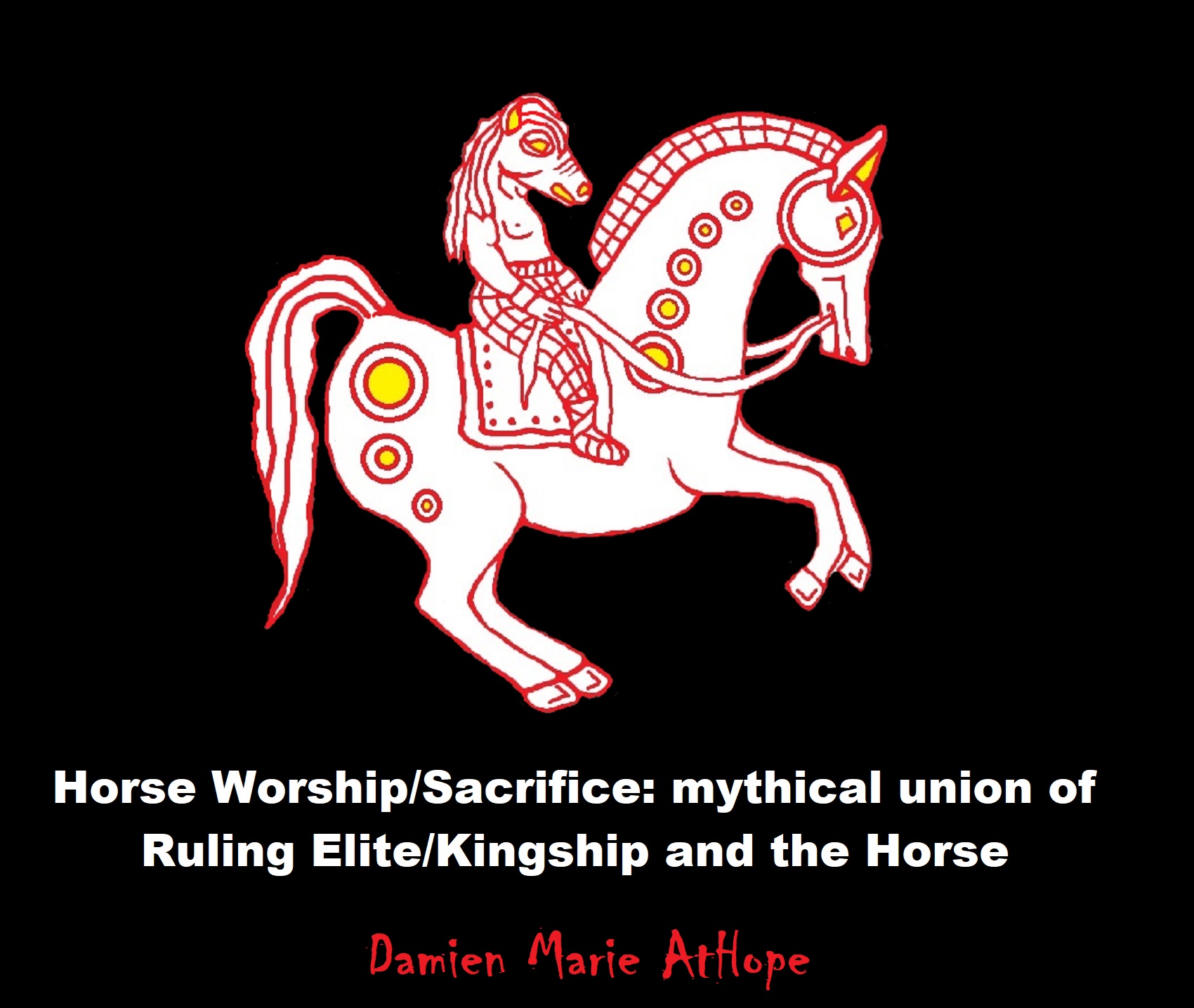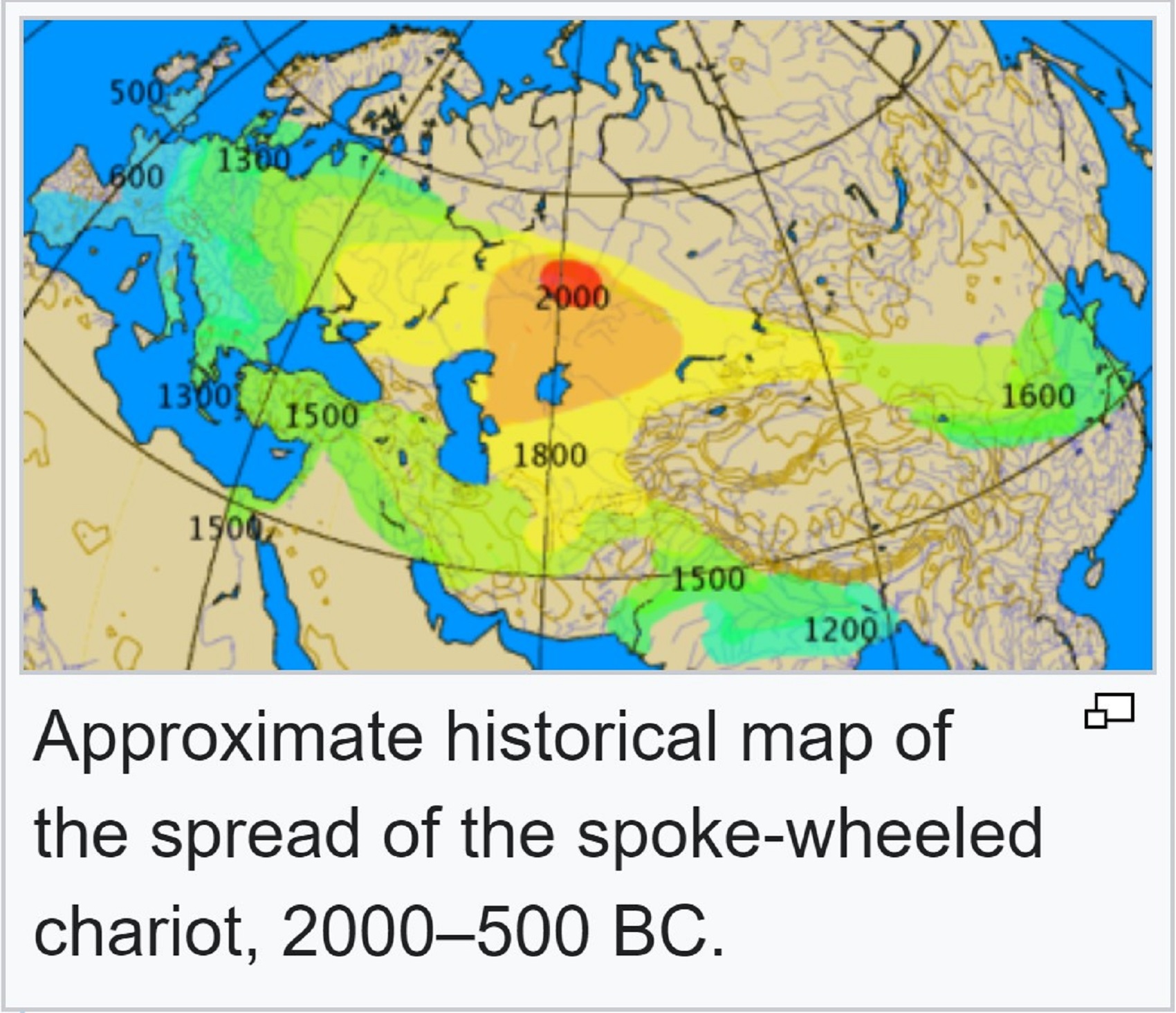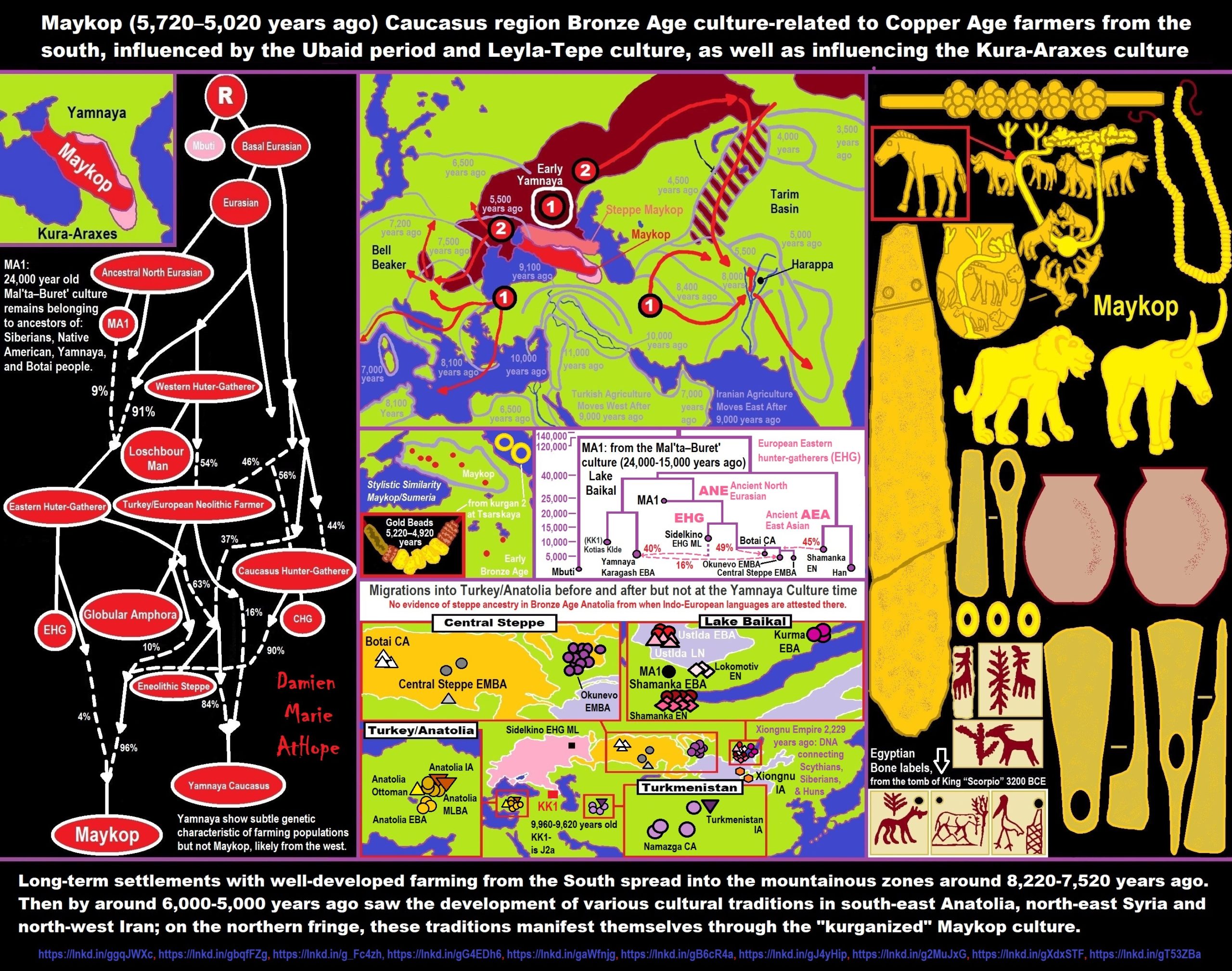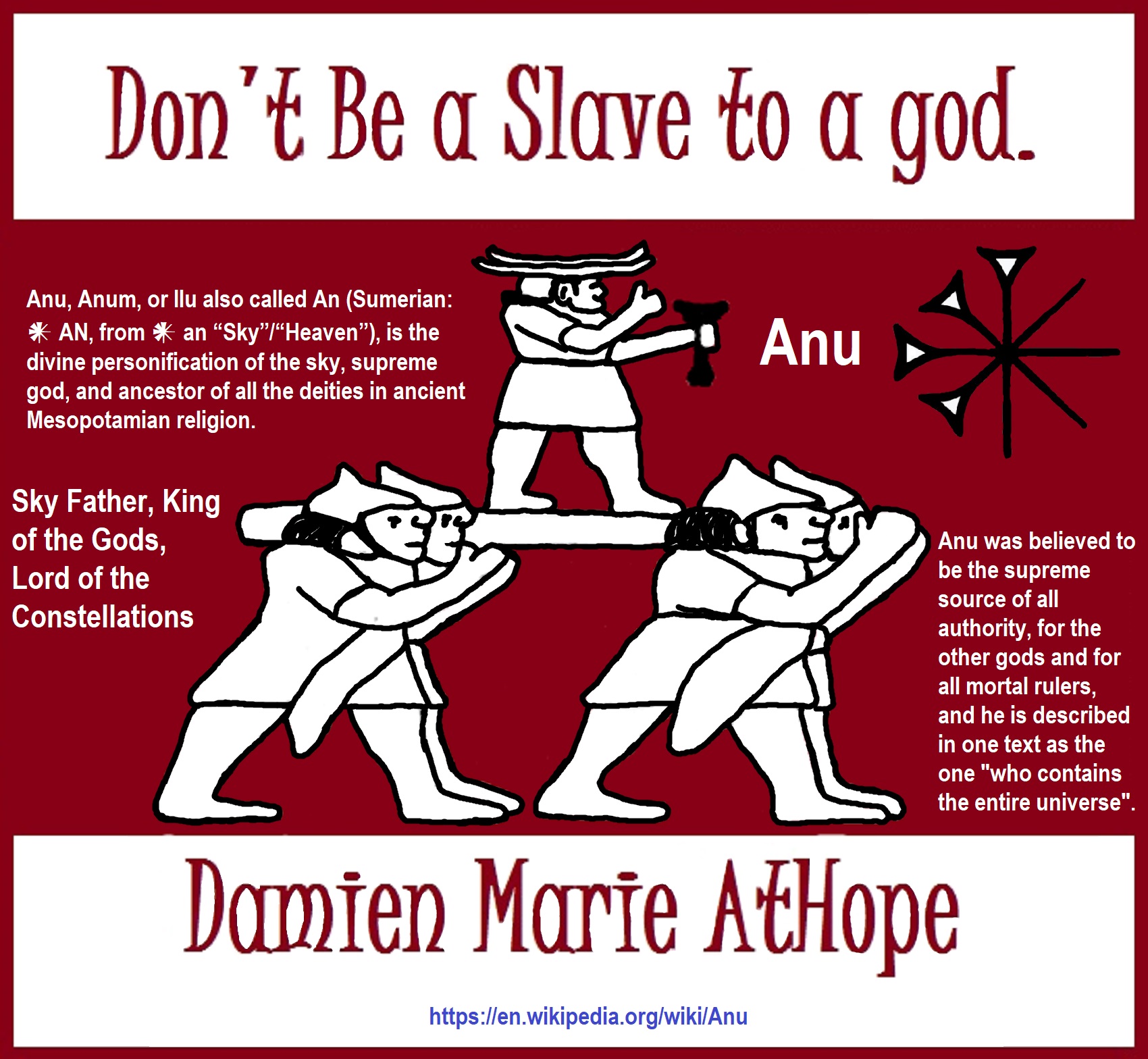
Predecessors to the domestic horse?
“A 2005 study analyzed the mitochondrial DNA (mtDNA) of a worldwide range of equids, from 53,000-year-old fossils to contemporary horses. Their analysis placed all equids into a single clade, or group with a single common ancestor, consisting of three genetically divergent species: Hippidion, the New World stilt-legged horse, and equus, the true horse. The true horse included prehistoric horses and the Przewalski’s horse, as well as what is now the modern domestic horse, belonged to a single Holarctic species. The true horse migrated from the Americas to Eurasia via Beringia, becoming broadly distributed from North America to central Europe, north and south of Pleistocene ice sheets. It became extinct in Beringia around 14,200 years ago, and in the rest of the Americas around 10,000 years ago. This clade survived in Eurasia, however, and it is from these horses which all domestic horses appear to have descended. These horses showed little phylogeographic structure, probably reflecting their high degree of mobility and adaptability.” ref
“Therefore, the domestic horse today is classified as Equus ferus caballus. No genetic originals of native wild horses currently exist. The Przewalski diverged from the modern horse before domestication. It has 66 chromosomes, as opposed to 64 among modern domesticated horses, and their Mitochondrial DNA (mtDNA) forms a distinct cluster. Genetic evidence suggests that modern Przewalski’s horses are descended from a distinct regional gene pool in the eastern part of the Eurasian steppes, not from the same genetic group that gave rise to modern domesticated horses. Nevertheless, evidence such as the cave paintings of Lascaux suggests that the ancient wild horses that some researchers now label the “Tarpan subtype” probably resembled Przewalski horses in their general appearance: big heads, dun coloration, thick necks, stiff upright manes, and relatively short, stout legs.” ref
Shamanic horse tradition:
“The horse occupies a very special place in shamanic rituals and mythology. The horse – primarily a carrier of souls and a burial animal – is used by the shaman in various situations as a means of helping to achieve a state of ecstasy. It is known that the eight-legged horse is a typical shamanic attribute. Eight-hoofed or headless horses are recorded in mythology and rituals of Germanic and Japanese “male unions”. The horse is a mythical image of Death, it delivers the deceased to the other world, makes the transition from one world to another.” ref
“Throughout history, horses have been credited with the gift of clairvoyance, which allows them to see the invisible danger. Therefore, they are considered especially susceptible to witch conspiracies. In the old days, witches took them at night to go to the Sabbath, they rushed on them for a long time and returned at dawn exhausted and covered with sweat and foam. To thwart “witch racing”, witchcraft and the evil eye, horse owners put trinkets and amulets installs and attached copper bells to their reins. During the witch hunt, it was believed that the devil and the witch could turn into horses.” ref
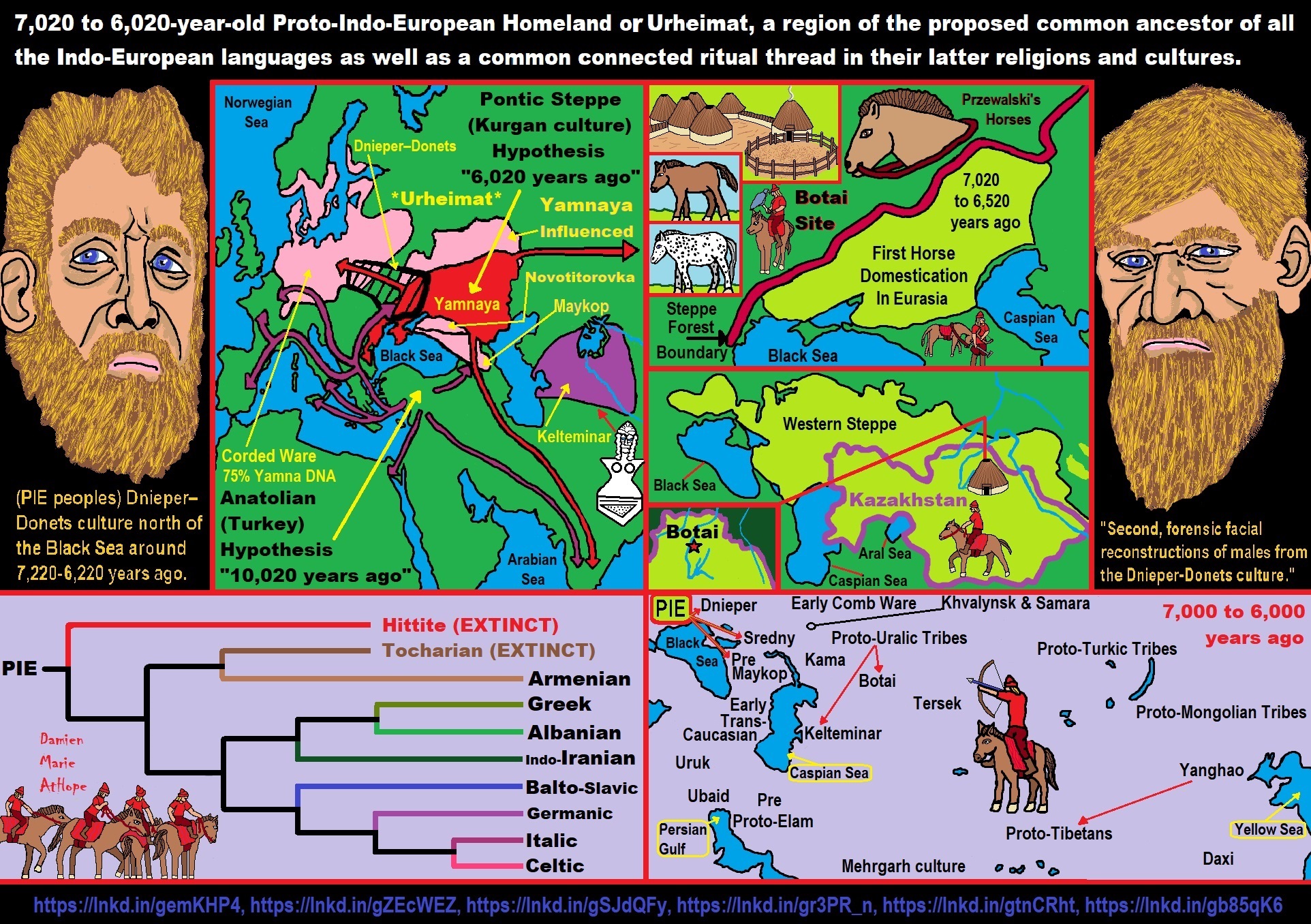
Domestication of the horse
“A number of hypotheses exist on many of the key issues regarding the domestication of the horse. Although horses appeared in Paleolithic cave art as early as 30,000 BCE, these were wild horses and were probably hunted for meat. How and when horses became domesticated is disputed. The clearest evidence of early use of the horse as a means of transport is from chariot burials dated c. 2000 BCE. However, an increasing amount of evidence supports the hypothesis that horses were domesticated in the Eurasian Steppes approximately 3500 BCE or around 5,500 years ago or so; recent discoveries in the context of the Botai culture suggest that Botai settlements in the Akmola Province of Kazakhstan are the location of the earliest domestication of the horse. Use of horses spread across Eurasia for transportation, agricultural work, and warfare.” ref
“The date of the domestication of the horse depends to some degree upon the definition of “domestication”. Some zoologists define “domestication” as human control over breeding, which can be detected in ancient skeletal samples by changes in the size and variability of ancient horse populations. Other researchers look at the broader evidence, including skeletal and dental evidence of working activity; weapons, art, and spiritual artifacts; and lifestyle patterns of human cultures. There is also evidence that horses were kept as meat animals before they were trained as working animals.” ref
“Attempts to date domestication by genetic study or analysis of physical remains rests on the assumption that there was a separation of the genotypes of domesticated and wild populations. Such a separation appears to have taken place, but dates based on such methods can only produce an estimate of the latest possible date for domestication without excluding the possibility of an unknown period of earlier gene flow between wild and domestic populations (which will occur naturally as long as the domesticated population is kept within the habitat of the wild population). Further, all modern horse populations retain the ability to revert to a feral state, and all feral horses are of domestic types; that is, they descend from ancestors that escaped from captivity.” ref
“Whether one adopts the narrower zoological definition of domestication or the broader cultural definition that rests on an array of zoological and archaeological evidence affects the time frame chosen for the domestication of the horse. The date of 4000 BCE is based on evidence that includes the appearance of dental pathologies associated with bitting, changes in butchering practices, changes in human economies and settlement patterns, the depiction of horses as symbols of power in artifacts, and the appearance of horse bones in human graves. On the other hand, measurable changes in size and increases in variability associated with domestication occurred later, about 2500–2000 BCE, as seen in horse remains found at the site of Csepel-Haros in Hungary, a settlement of the Bell Beaker culture.” ref
“Use of horses spread across Eurasia for transportation, agricultural work, and warfare. Horses and mules in agriculture used a breastplate type harness or a yoke more suitable for oxen, which was not as efficient at utilizing the full strength of the animals as the later-invented padded horse collar that arose several millennia later.” ref

I think it possible that Proto-Indo-Europian language starts 7,022-6,022 and the time of kings could start around, an overlapping time, or with/reason-behind Horse burials that start as 6,022-5,522 years ago.
“A monarchy is a form of government in which a person, the monarch, is head of state for life or until abdication. The political legitimacy and authority of the monarch may vary from restricted and largely symbolic (constitutional monarchy), to fully autocratic (absolute monarchy), and can expand across the domains of the executive, legislative, and judicial. Monarchs can carry various titles such as emperor, empress, king, queen, raja, khan, tsar, sultan, shah, or pharaoh. The succession of monarchs is in most cases hereditary, often building dynastic periods. However, elective and self-proclaimed monarchies are possible. Aristocrats, though not inherent to monarchies, often serve as the pool of persons to draw the monarch from and fill the constituting institutions (e.g. diet and court), giving many monarchies oligarchic elements.” ref
“Most historians have suggested that Sumer was first permanently settled between 5500 and 4000 BCE so 7,533-4,022 years ago by a West Asian people who spoke the Sumerian language (pointing to the names of cities, rivers, basic occupations, etc., as evidence), thought to be a non-Semitic and non-Indo-European agglutinative language isolate. In contrast to its Semitic neighbors, it was not an inflected language. However, Sumerian civilization took form in the Uruk period (4th millennium BCE 6,022-5,022 years ago), continuing into the Jemdet Nasr and Early Dynastic periods.” ref
“The word “monarch” (Late Latin: monarchia) comes from the Ancient Greek word μονάρχης (monárkhēs), derived from μόνος (mónos, “one, single”) and ἄρχω (árkhō, “to rule”): compare ἄρχων (árkhōn, “ruler, chief”). It referred to a single at least nominally absolute ruler. In current usage the word monarchy usually refers to a traditional system of hereditary rule, as elective monarchies are quite rare.” ref
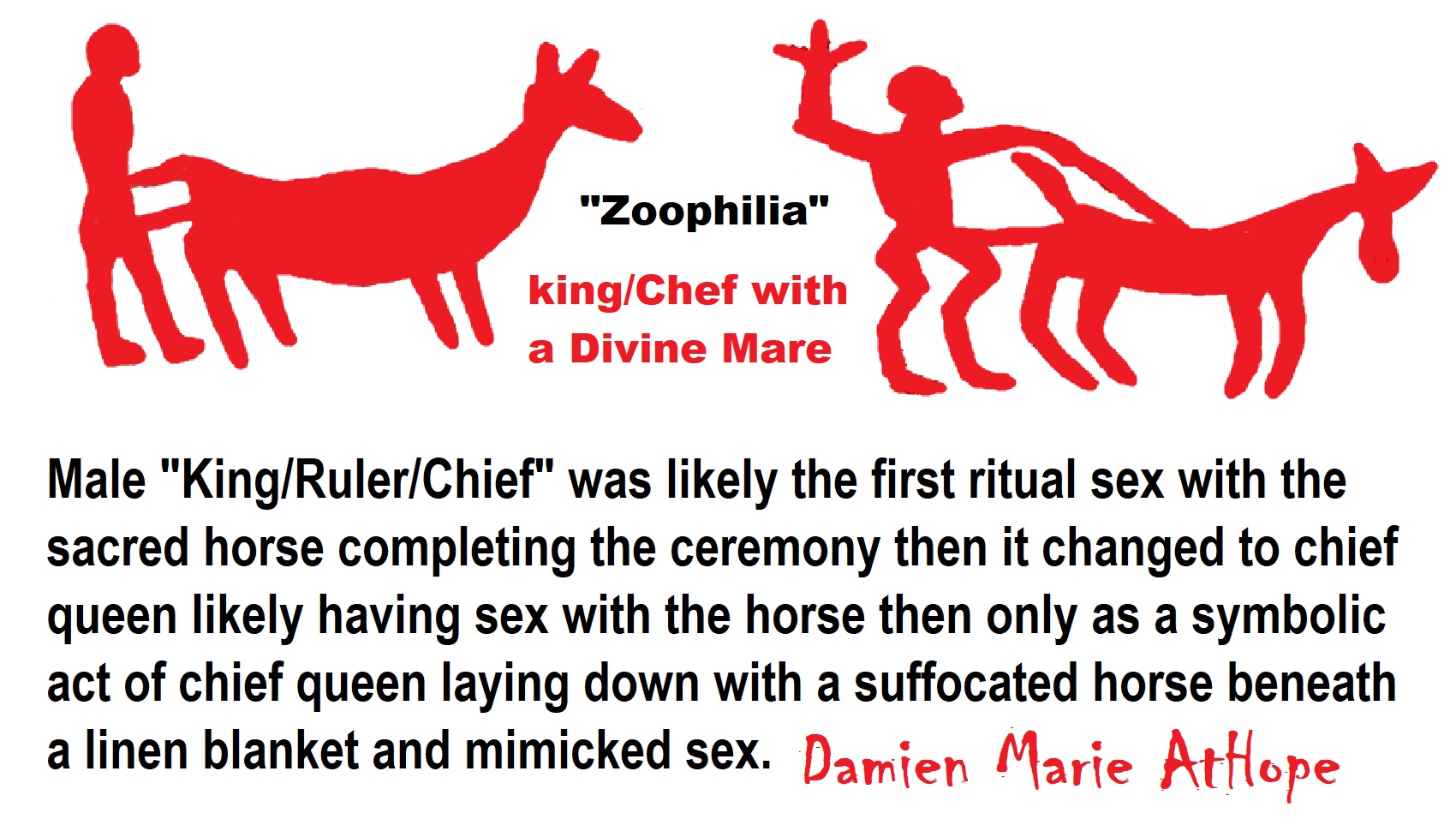
Male “King/Ruler/Chief” was likely the first ritual sex with the sacred horse completing the ceremony then it changed to chief queen likely having sex with the horse then only as a symbolic act of chief queen laying down with a suffocated horse beneath a linen blanket and mimicked sex.
“Man/god with horse-sized penis participating in royal/fertility ritual? Indo-European horse-sacrifice is one of the world’s most ancient and widespread traditions. The great Indo-European tradition of horse sacrifice in a 4000-year historic context, from the Sintashta culture in Russia in the east to historical Scandinavia in the west. In a brief history of Indo-European studies on the great horse sacrifices, we will present Indian, Irish, Greek, and Roman sacrificial traditions and
discuss how similarities across time and space have, for over a century, led different scholars to retrace these traditions to a common ‘Proto-Indo-European’ origin.” ref
Mythology: Horse worship and White horse (mythology)
“The reconstructed myth involves the coupling of a king with a divine mare which produced the divine twins. A related myth is that of a hero magically twinned with a horse foaled at the time of his birth (for example Cuchulainn, Pryderi), suggested to be fundamentally the same myth as that of the divine twin horsemen by the mytheme of a “mare-suckled” hero from Greek and medieval Serbian evidence, or mythical horses with human traits (Xanthos), suggesting totemic identity of the hero or king with the horse.” ref
Vedic (Indian): Ashvamedha
“Ashvamedha was a political ritual that was focused on the king’s right to rule. The horse had to be a stallion and it would be permitted to wander for a year, accompanied by people of the king. If the horse roamed off into lands of an enemy then that territory would be taken by the king, and if the horse’s attendants were killed in a fight by a challenger then the king would lose the right to rule. But if the horse stayed alive for a year then it was taken back to the king’s court where it was bathed, consecrated with butter, decorated with golden ornaments, and then sacrificed. After the completion of this ritual, the king would be considered as the undisputed ruler of the land which was covered by the horse.” ref
- “the sacrifice is connected with the elevation or inauguration of a member of the Kshatriya warrior caste
- the ceremony took place in spring or early summer
- the horse sacrificed was a stallion which won a race at the right side of the chariot
- the horse sacrificed was white-colored with dark circular spots, or with a dark front part, or with a tuft of dark blue hair
- it was bathed in water, in which mustard and sesame are mixed
- it was suffocated alongside a hornless ram and a he-goat, among other animals
- the chief queen lay down with the suffocated horse beneath a linen blanket and mimicked sexual intercourse with it, while the other queens perambulated the scene, slapping their thighs and fanning themselves
- the stallion was dissected along the “knife-paths” — with three knives made from gold, copper, and iron — and its portions awarded to various deities, symbolically invoking sky, atmosphere, and earth, while other priests started reciting the verses of Vedas, seeking healing and rejuvenation for the horse.” ref
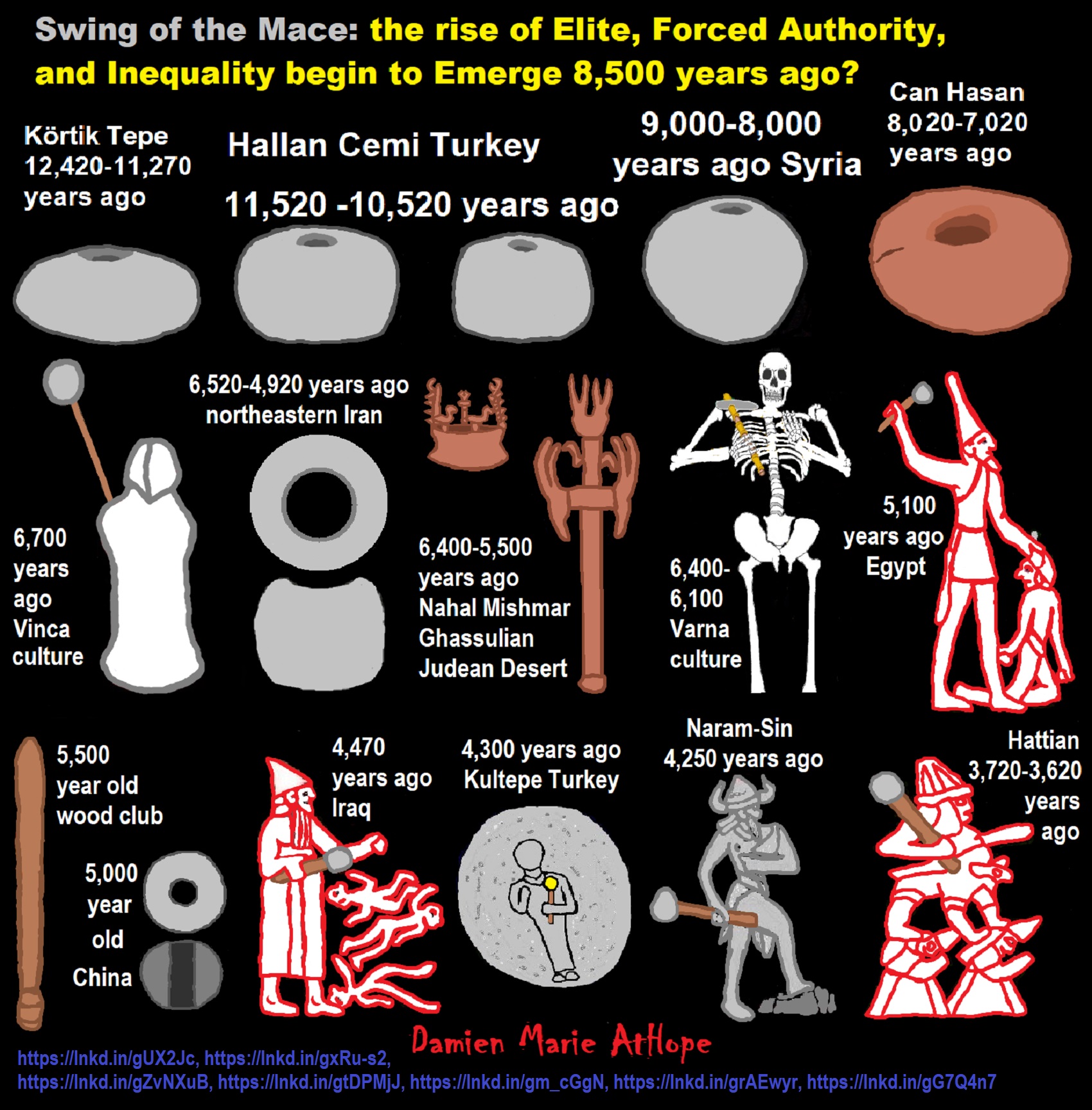
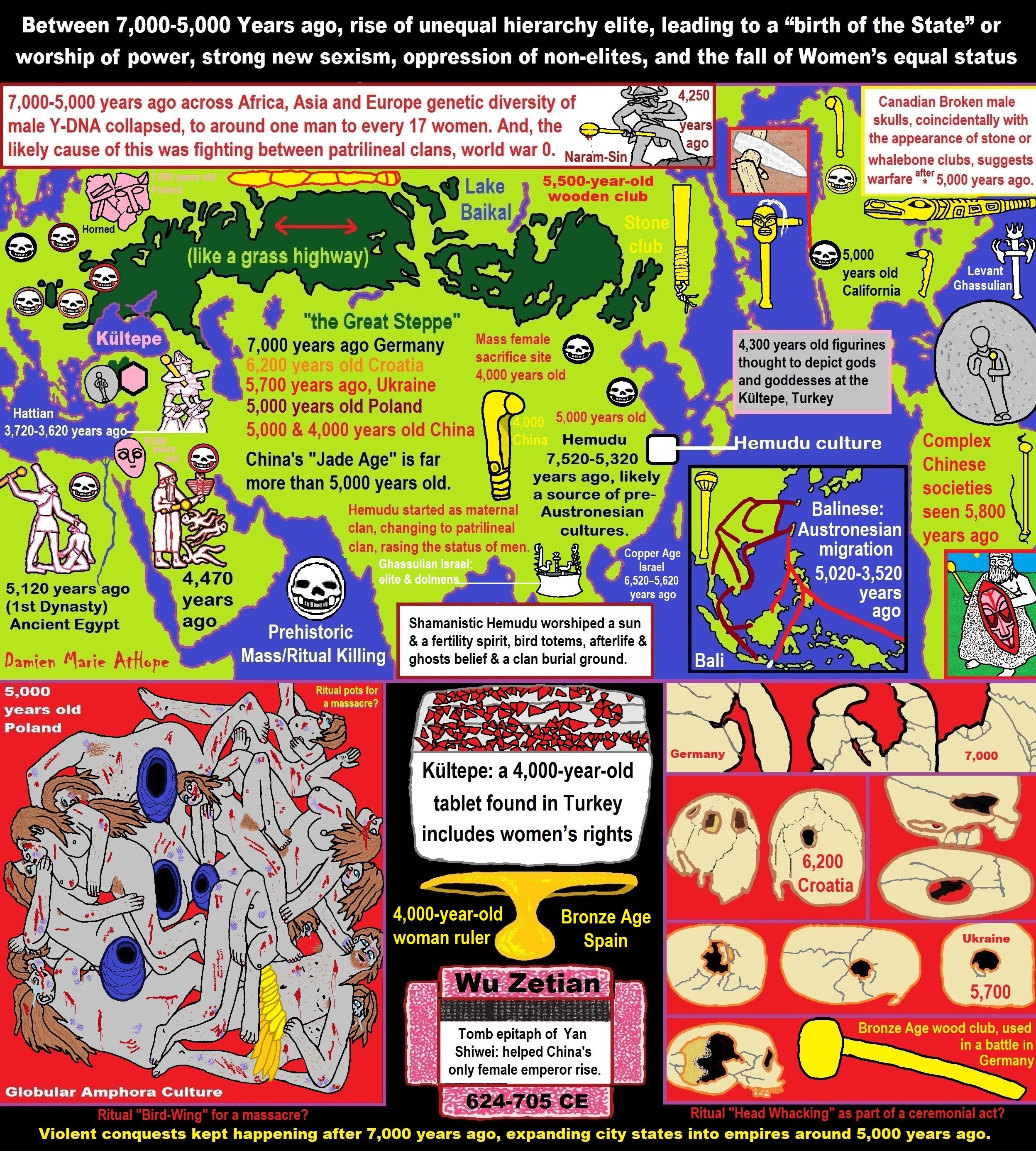
ref, ref, ref, ref, ref, ref, ref, ref, ref, ref, ref, ref, ref, ref, ref, ref, ref, ref, ref, ref, ref, ref, ref, ref, ref, ref, ref, ref, ref, ref, ref, ref, ref, ref, ref, ref, ref, ref, ref, ref, ref, ref, ref, ref, ref, ref, ref, ref, ref, ref, ref, ref, ref, ref, ref, ref, ref, ref, ref, ref, ref, ref, ref, ref, ref, ref, ref, ref, ref, ref, ref, ref, ref, ref, ref, ref, ref, ref, ref, ref, ref, ref, ref, ref, ref, ref, ref, ref, ref, ref
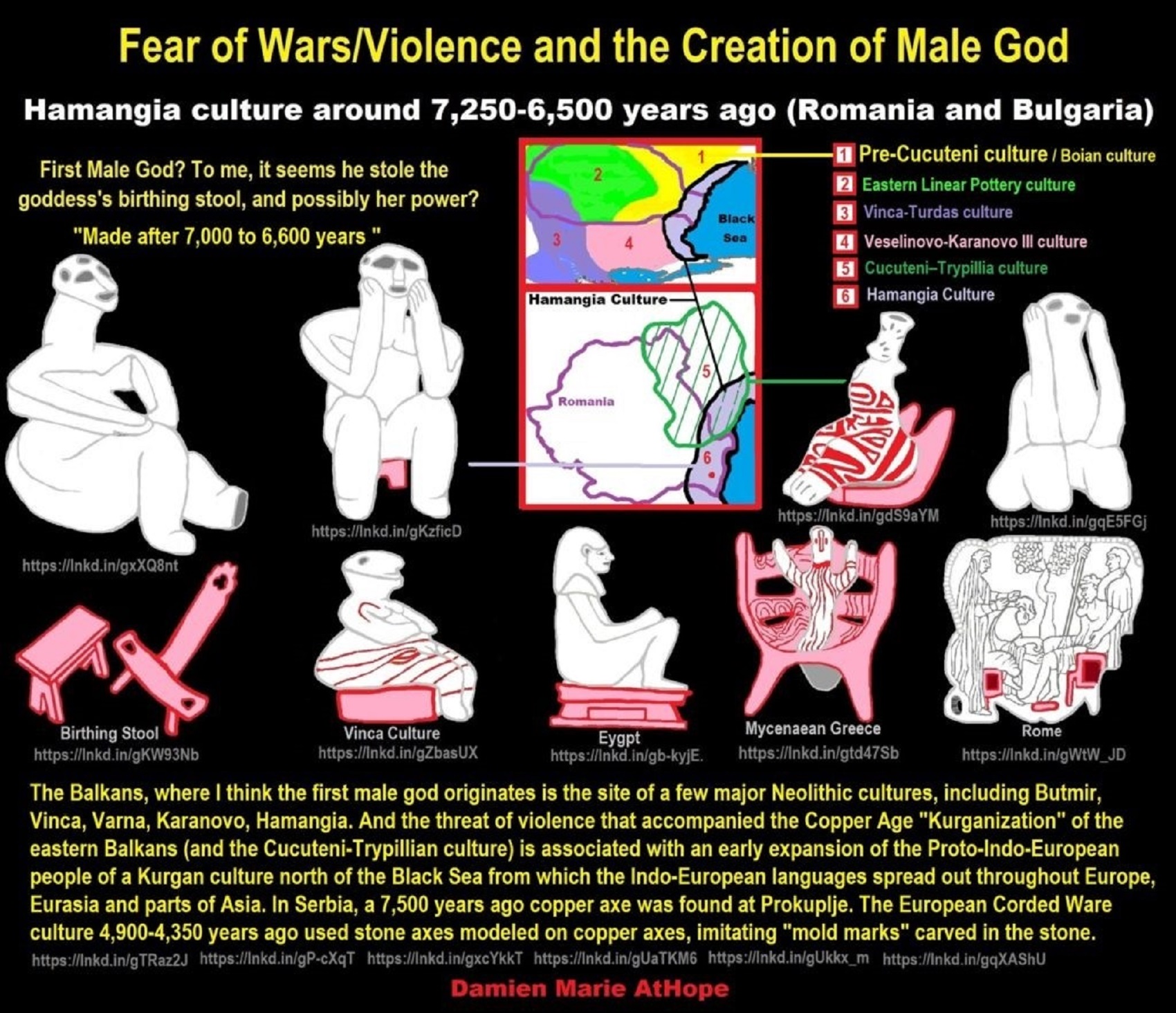


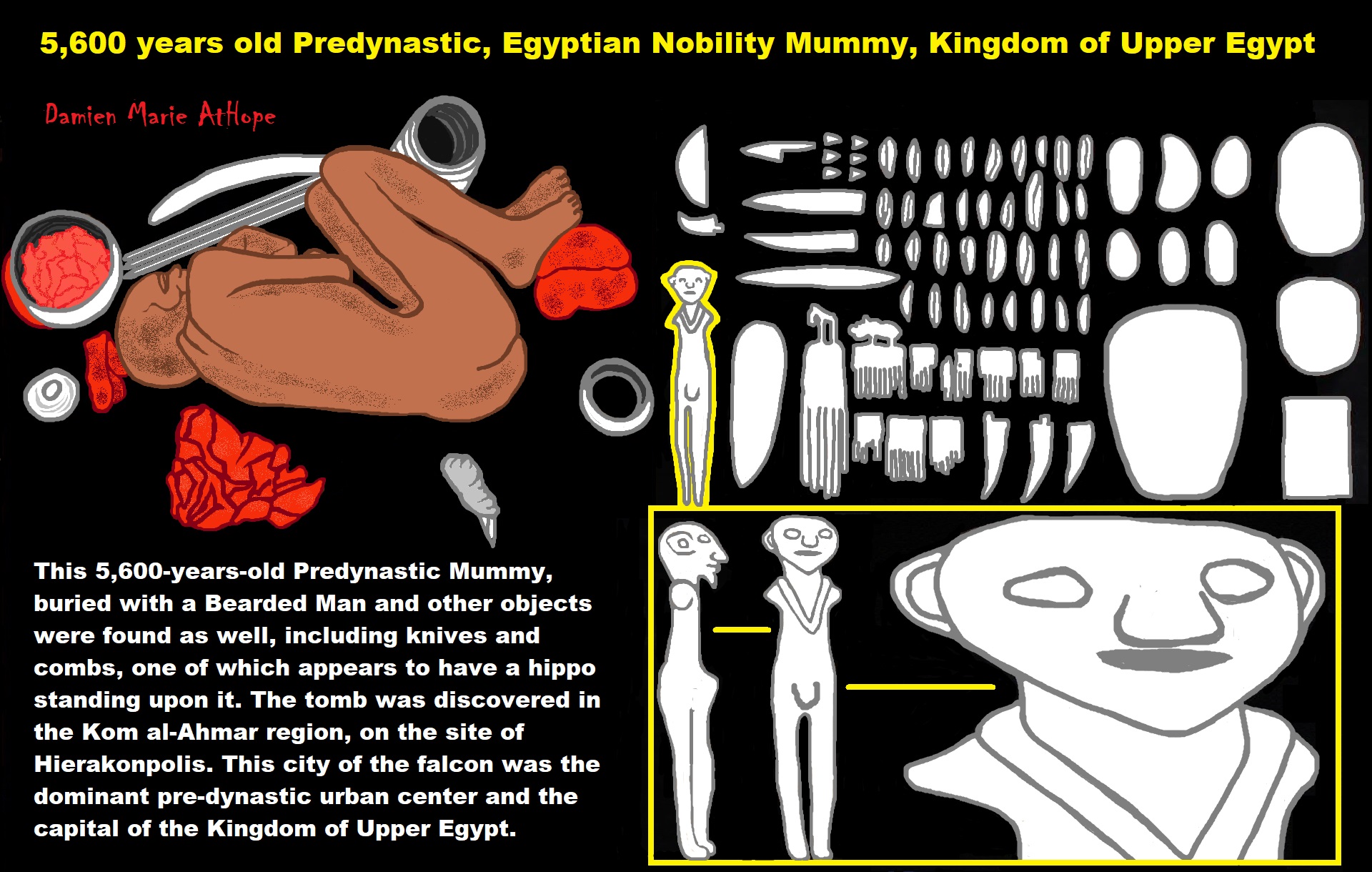

Seated Woman of Çatalhöyük
“The Seated Woman of Çatalhöyük (also Çatal Höyük) is a baked-clay, nude female form, seated between feline-headed arm-rests. It is generally thought to depict a corpulent and fertile Mother goddess in the process of giving birth while seated on her throne, which has two hand rests in the form of feline (lioness, leopard, or panther) heads in a Mistress of Animals motif. The statuette, one of several iconographically similar ones found at the site, is associated to other corpulent prehistoric goddess figures, of which the most famous is the Venus of Willendorf. It is a neolithic sculpture shaped by an unknown artist, and was completed in approximately 6000 BCE.” ref
Kubaba
“Kubaba is the only queen on the Sumerian King List, which states she reigned for 100 years – roughly in the Early Dynastic III period (ca. 2500–2330 BCE) of Sumerian history. A connection between her and a goddess known from Hurro–Hittite and later Luwian sources cannot be established on the account of spatial and temporal differences. Kubaba is one of very few women to have ever ruled in their own right in Mesopotamian history. Most versions of the king list place her alone in her own dynasty, the 3rd Dynasty of Kish, following the defeat of Sharrumiter of Mari, but other versions combine her with the 4th dynasty, that followed the primacy of the king of Akshak. Before becoming monarch, the king list says she was an alewife, brewess or brewster, terms for a woman who brewed alcohol.” ref
“Kubaba was a Syrian goddess associated particularly closely with Alalakh and Carchemish. She was adopted into the Hurrian and Hittite pantheons as well. After the fall of the Hittite empire, she continued to be venerated by Luwians. A connection between her and the similarly named legendary Sumerian queen Kubaba of Kish, while commonly proposed, cannot be established due to spatial and temporal differences. Emmanuel Laroche proposed in 1960 that Kubaba and Cybele were one and the same. This view is supported by Mark Munn, who argues that the Phrygian name Kybele developed from Lydian adjective kuvavli, first changed into kubabli and then simplified into kuballi, and finally kubelli. However, such an adjective is a purely speculative construction.” ref
Cybele
“Cybele (Phrygian: “Kubileya/Kubeleya Mother”, perhaps “Mountain Mother”) is an Anatolian mother goddess; she may have a possible forerunner in the earliest neolithic at Çatalhöyük, where statues of plump women, sometimes sitting, have been found in excavations. Phrygia‘s only known goddess, she was probably its national deity. Greek colonists in Asia Minor adopted and adapted her Phrygian cult and spread it to mainland Greece and to the more distant western Greek colonies around the 6th century BCE. In Greece, Cybele met with a mixed reception. She became partially assimilated to aspects of the Earth-goddess Gaia, of her possibly Minoan equivalent Rhea, and of the harvest–mother goddess Demeter. Some city-states, notably Athens, evoked her as a protector, but her most celebrated Greek rites and processions show her as an essentially foreign, exotic mystery-goddess who arrives in a lion-drawn chariot to the accompaniment of wild music, wine, and a disorderly, ecstatic following.” ref
“Uniquely in Greek religion, she had a eunuch mendicant priesthood. Many of her Greek cults included rites to a divine Phrygian castrate shepherd-consort Attis, who was probably a Greek invention. In Greece, Cybele became associated with mountains, town and city walls, fertile nature, and wild animals, especially lions. In Rome, Cybele became known as Magna Mater (“Great Mother”). The Roman State adopted and developed a particular form of her cult after the Sibylline oracle in 205 BCE recommended her conscription as a key religious ally in Rome’s second war against Carthage (218 to 201 BCE). Roman mythographers reinvented her as a Trojan goddess, and thus an ancestral goddess of the Roman people by way of the Trojan prince Aeneas. As Rome eventually established hegemony over the Mediterranean world, Romanized forms of Cybele’s cults spread throughout Rome’s empire. Greek and Roman writers debated and disputed the meaning and morality of her cults and priesthoods, which remain controversial subjects in modern scholarship.” ref
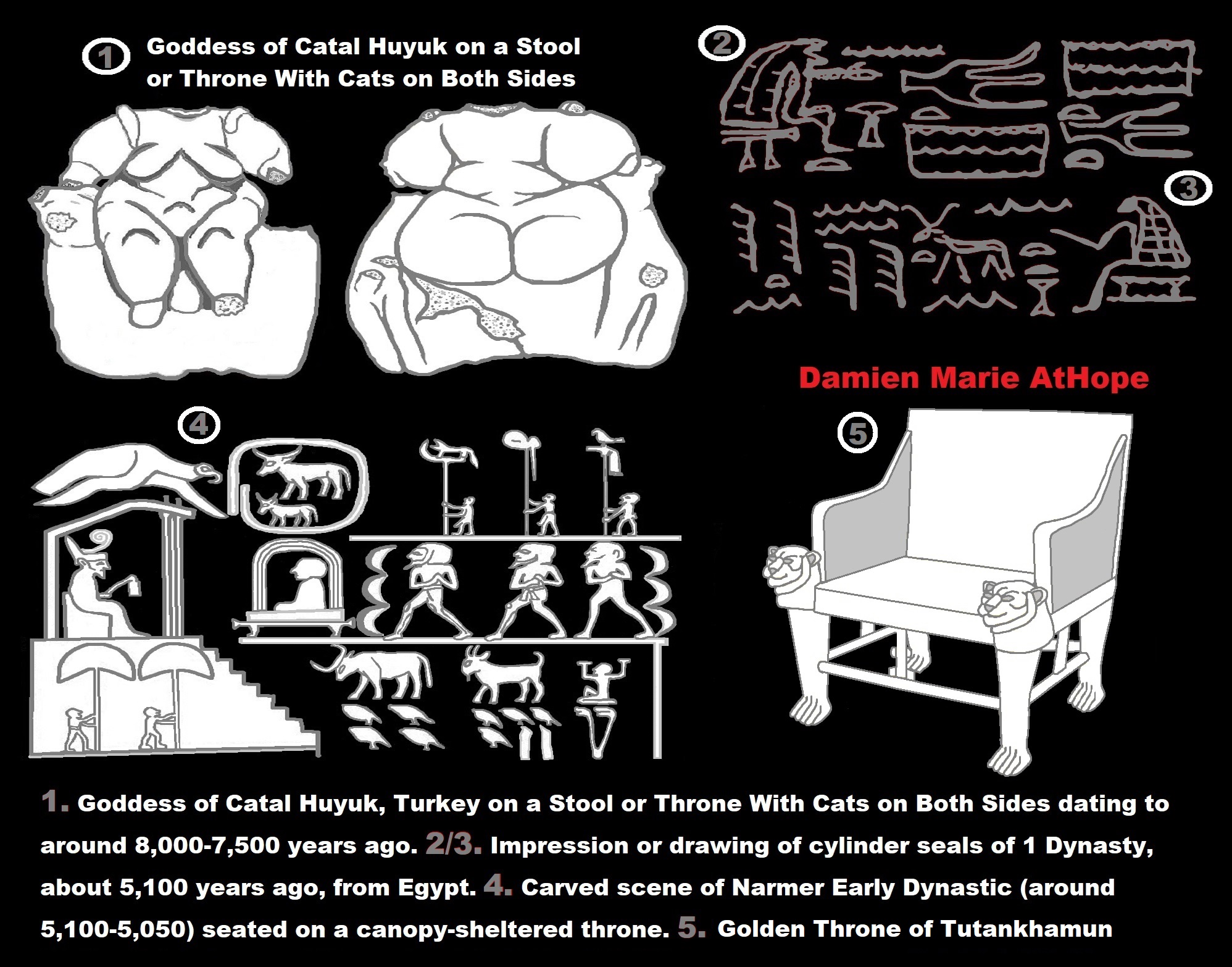
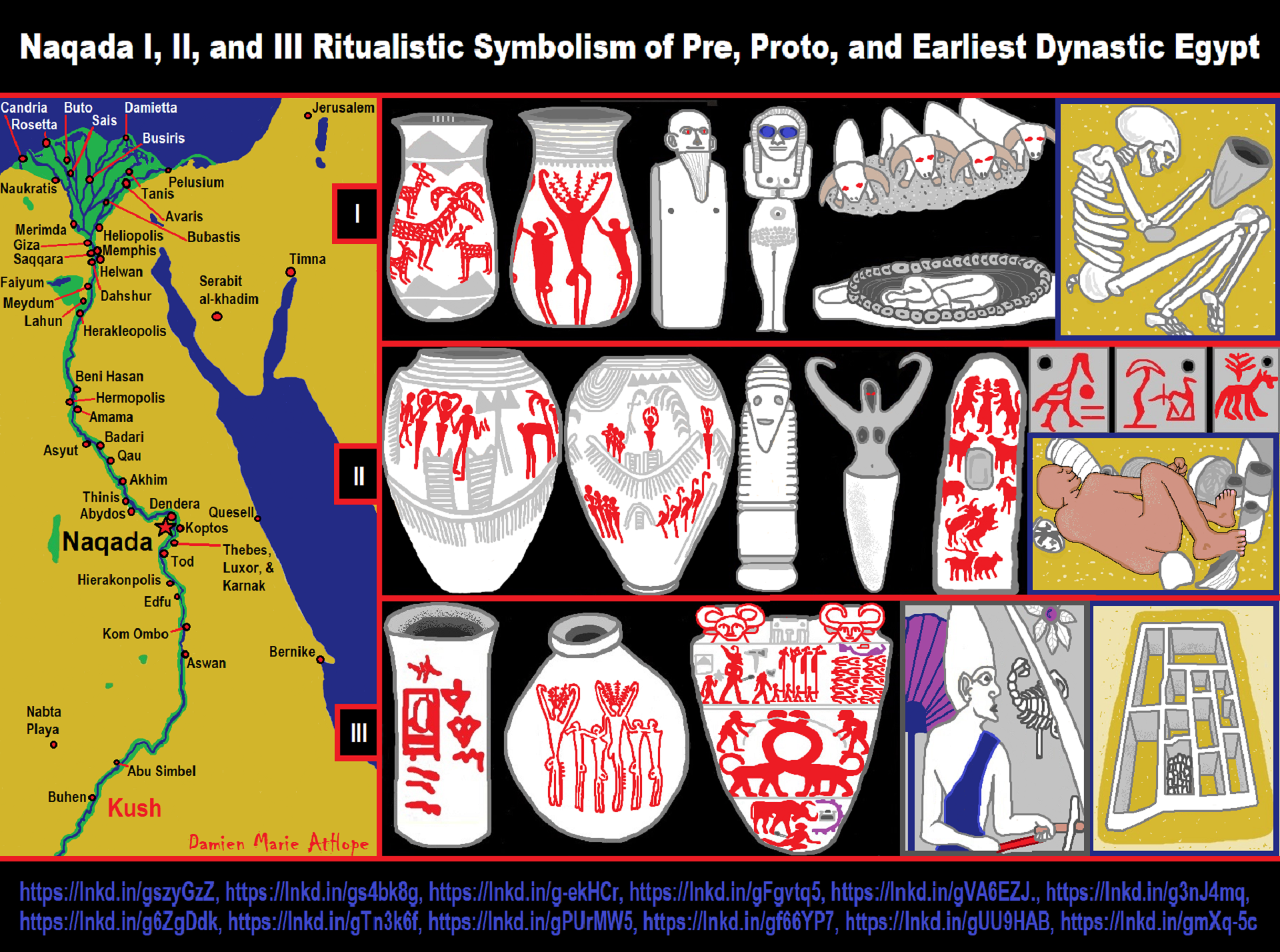
ref, ref, ref, ref, ref, ref, ref, ref, ref
“Naqada stands near the site of a prehistoric Egyptian necropolis: The town was the center of the cult of Set and large tombs were built there c. 3500 BCE. The large quantity of remains from Naqada have enabled the dating of the entire archeological period throughout Egypt and environs, hence the town name Naqada is used for the pre-dynastic Naqada culture c. 4400–3000 BCE. Other Naqada culture archeological sites include el Badari, the Gerzeh culture, and Nekhen.” ref
“The Naqada culture is an archaeological culture of Chalcolithic Predynastic Egypt (c. 4000–3000 BCE), named for the town of Naqada, Qena Governorate. A 2013 Oxford University dating study of the Predynastic period suggests a beginning date sometime between 3,800 and 3,700 BCE. The final phase of the Naqada culture is Naqada III, which is coterminous with the Protodynastic Period (Early Bronze Age c. 3200–3000 BCE) in ancient Egypt.” ref
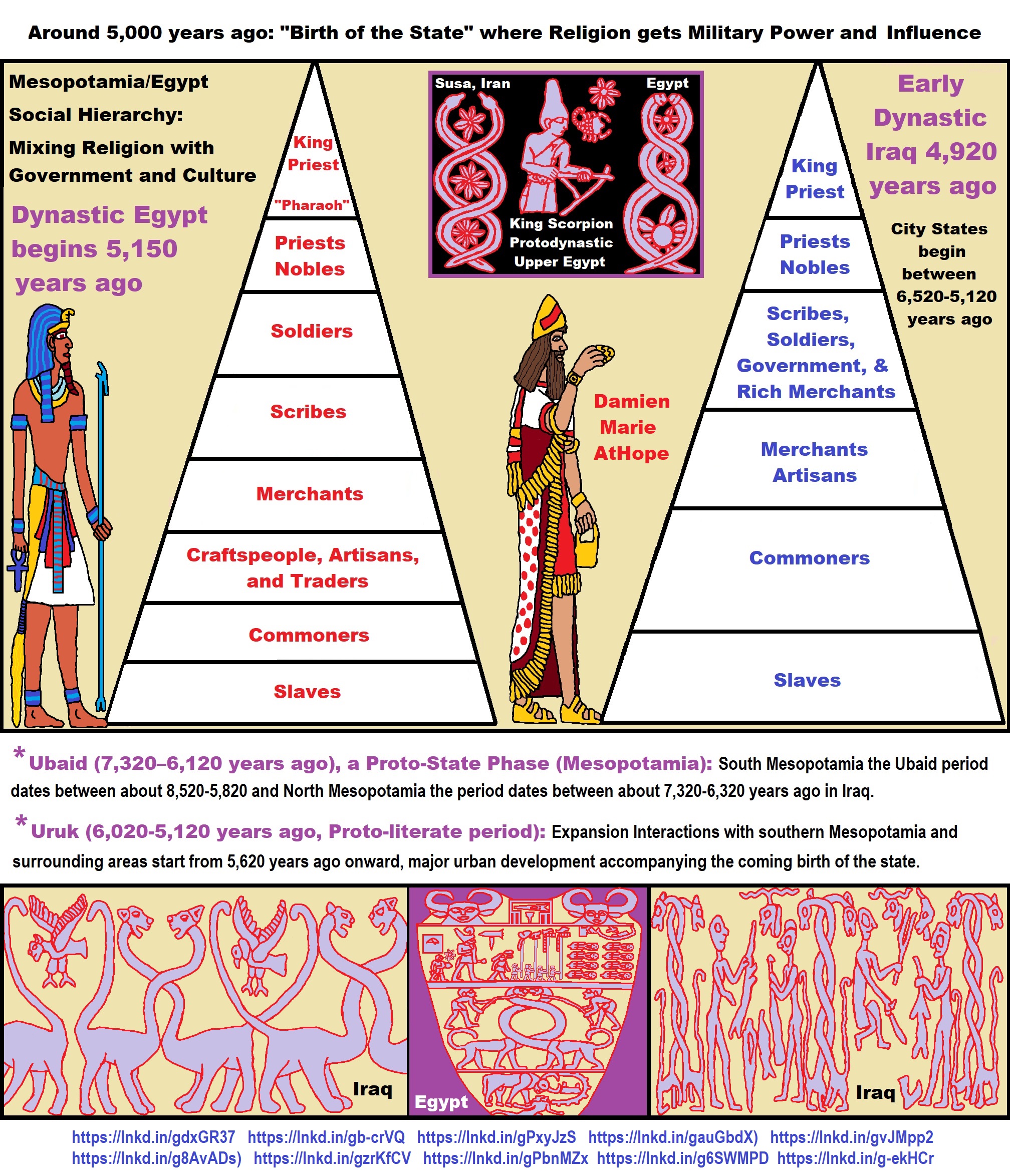
Ancient Egypt Monarch 3100 BCE or 5,122 years ago
“Monarchies are thought to be preceded by the similar form of prehistoric societal hierarchy known as chiefdom or tribal kingship. Chiefdoms are identified as having formed monarchic states, as in civilizations such as Mesopotamia, Ancient Egypt, and the Indus Valley Civilization. In some parts of the world, chiefdoms became monarchies. Some of the oldest recorded and evidenced monarchies were Narmer, Pharaoh of Ancient Egypt c. 3100 BCE, and Enmebaragesi, a Sumerian King of Kish c. 2600 BCE.” ref
“From earliest records, monarchs could be directly hereditary, while others were elected from among eligible members. With the Egyptian, Mesopotamian, Sudanic, reconstructed Proto-Indo-European religion, and others, the monarch held sacral functions directly connected to sacrifice and was sometimes identified with having divine ancestry, possibly establishing a notion of the divine right of kings.” ref
“Polybius identified monarchy as one of three “benign” basic forms of government (monarchy, aristocracy, and democracy), opposed to the three “malignant” basic forms of government (tyranny, oligarchy, and ochlocracy). The monarch in classical antiquity is often identified as “king” or “ruler” (translating archon, basileus, rex, tyrannos, etc.) or as “queen” (basilinna). Polybius originally understood monarchy as a component of republics, but since antiquity monarchy has contrasted with forms of republic, where executive power is wielded by free citizens and their assemblies. The 4th-century BCE Hindu text Arthasastra laid out the ethics of monarchism. In antiquity, some monarchies were abolished in favor of such assemblies in Rome (Roman Republic, 509 BCE), and Athens (Athenian democracy, 500 BCE).” ref
“By the 17th century, monarchy was challenged by evolving parliamentarism e.g. through regional assemblies (such as the Icelandic Commonwealth, the Swiss Landsgemeinde and later Tagsatzung, and the High Medieval communal movement linked to the rise of medieval town privileges) and by modern anti-monarchism e.g. of the temporary overthrow of the English monarchy by the Parliament of England in 1649, the American Revolution of 1776 and the French Revolution of 1789. One of many opponents of that trend was Elizabeth Dawbarn, whose anonymous Dialogue between Clara Neville and Louisa Mills, on Loyalty (1794) features “silly Louisa, who admires liberty, Tom Paine and the US, [who is] lectured by Clara on God’s approval of monarchy” and on the influence, women can exert on men.” ref
“Since then advocacy of the abolition of a monarchy or respectively of republics has been called republicanism, while the advocacy of monarchies is called monarchism. As such republics have become the opposing and alternative form of government to monarchy, despite some having seen infringements through lifelong or even hereditary heads of state.” ref
The Early Dynastic Period for Mesopotamia is around 2900–2350 BCE or 4,922-4,372 years ago
“The Early Dynastic period (abbreviated ED period or ED) is an archaeological culture in Mesopotamia (modern-day Iraq) that is generally dated to c. 2900–2350 BCE and was preceded by the Uruk and Jemdet Nasr periods. It saw the development of writing and the formation of the first cities and states. The ED itself was characterized by the existence of multiple city-states: small states with a relatively simple structure that developed and solidified over time. This development ultimately led to the unification of much of Mesopotamia under the rule of Sargon, the first monarch of the Akkadian Empire. Despite this political fragmentation, the ED city-states shared a relatively homogeneous material culture. Sumerian cities such as Uruk, Ur, Lagash, Umma, and Nippur located in Lower Mesopotamia were very powerful and influential. To the north and west stretched states centered on cities such as Kish, Mari, Nagar, and Ebla.” ref
“The study of Central and Lower Mesopotamia has long been given priority over neighboring regions. Archaeological sites in Central and Lower Mesopotamia—notably Girsu but also Eshnunna, Khafajah, Ur, and many others—have been excavated since the 19th century. These excavations have yielded cuneiform texts and many other important artifacts. As a result, this area was better known than neighboring regions, but the excavation and publication of the archives of Ebla have changed this perspective by shedding more light on surrounding areas, such as Upper Mesopotamia, western Syria, and southwestern Iran. These new findings revealed that Lower Mesopotamia shared many socio-cultural developments with neighboring areas and that the entirety of the ancient Near East participated in an exchange network in which material goods and ideas were being circulated.” ref
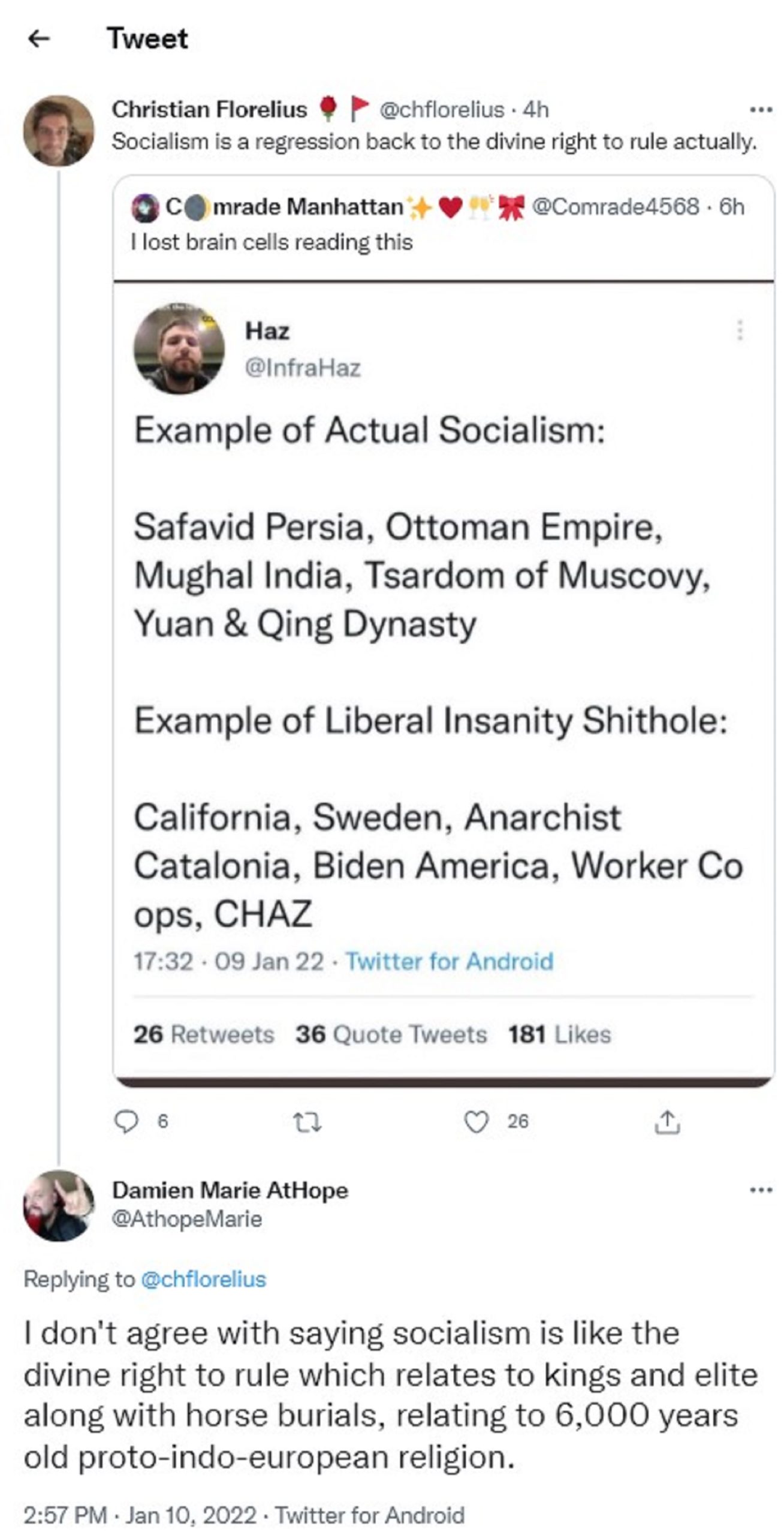
I don’t agree with saying socialism is like the divine right to rule which relates to kings and elite along with horse burials, relating to 6,000 years old Proto-Indo-European religion.
“King is the title given to a male monarch in a variety of contexts. The female equivalent is queen, which title is also given to the consort of a king. The term king may also refer to a king consort, a title that is sometimes given to the husband of a ruling queen, but the title of prince consort is more common. The English word is of Germanic origin, and historically refers to Germanic kingship, in the pre-Christian period a type of tribal kingship. The monarchies of Europe in the Christian Middle Ages derived their claim from Christianisation and the divine right of kings, partly influenced by the notion of sacral kingship inherited from Germanic antiquity.” ref
- “In the context of prehistory, antiquity, and contemporary indigenous peoples, the title may refer to tribal kingship. Germanic kingship is cognate with Indo-European traditions of tribal rulership (c.f. Indic rājan, Gothic reiks, and Old Irish rí, etc.).
- In the context of classical antiquity, king may translate in Latin as rex and in Greek as archon or basileus.
- In classical European feudalism, the title of king as the ruler of a kingdom is understood to be the highest rank in the feudal order, potentially subject, at least nominally, only to an emperor (harking back to the client kings of the Roman Republic and Roman Empire).
- In a modern context, the title may refer to the ruler of one of a number of modern monarchies (either absolute or constitutional). The title of king is used alongside other titles for monarchs: in the West, emperor, grand prince, prince, archduke, duke or grand duke, and in the Islamic world, malik, sultan, emir or hakim, etc.
- The city-states of the Aztec Empire had a Tlatoani, which were kings of pre-Hispanic Mesoamerica. The Huey Tlatoani was the emperor of the Aztecs.” ref
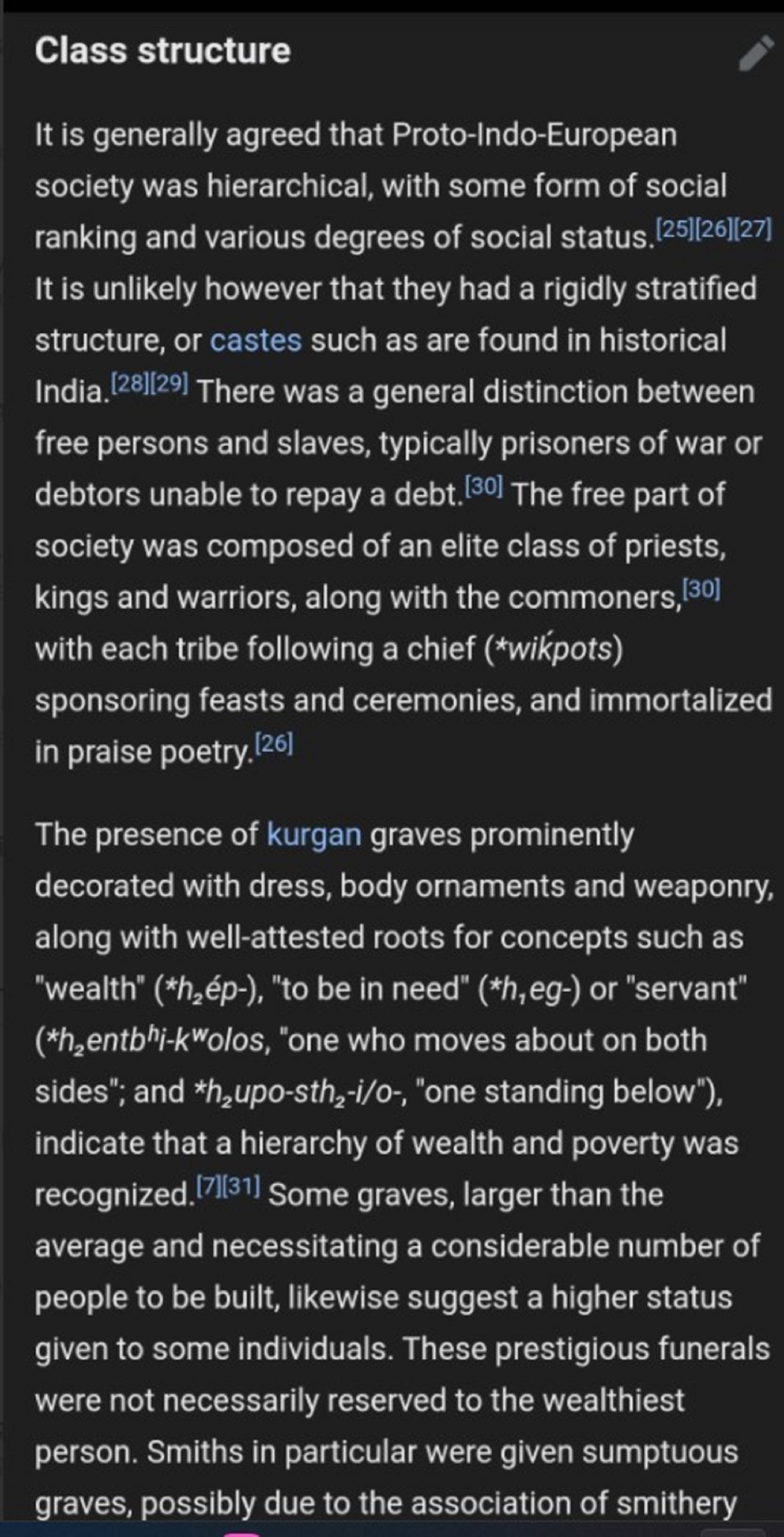
Proto-Indo-European class structure ref
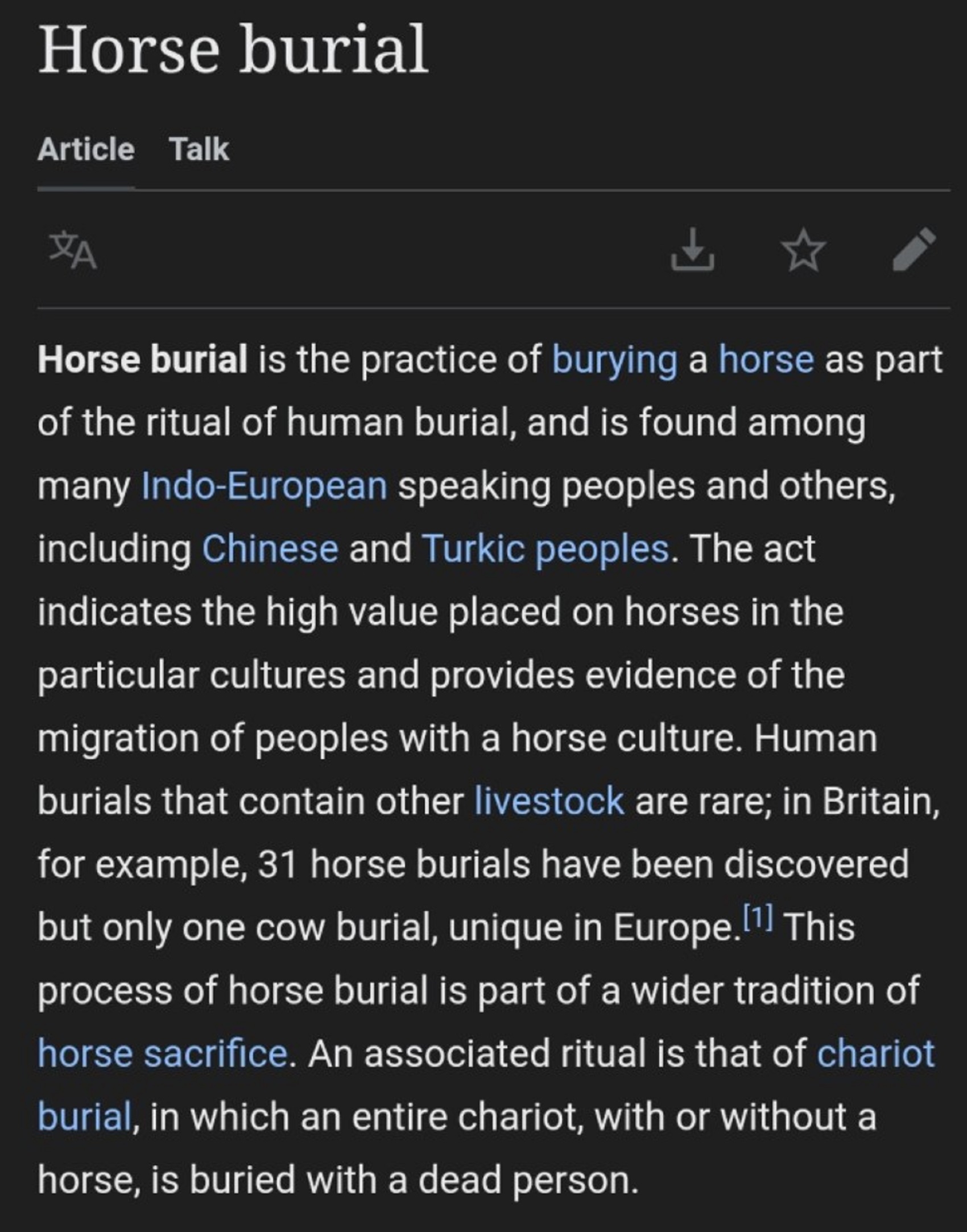
Horse burial and kingship relate as well as the divine right to rule theme. ref

Horse burial: ref

Horse worship?
“Horse worship is a spiritual practice with archaeological evidence of its existence during the Iron Age and, in some places, as far back as the Bronze Age. The horse was seen as divine, as a sacred animal associated with a particular deity, or as a totem animal impersonating the king or warrior. Horse cults and horse sacrifice were originally a feature of Eurasian nomad cultures. While horse worship has been almost exclusively associated with Indo-European culture, by the Early Middle Ages it was also adopted by Turkic peoples. Horse worship still exists today in various regions of South Asia.” ref
Bronze Age
“The history of horse domestication is still a debated topic. The most widely accepted theory is that the horse was domesticated somewhere in the western Eurasian steppes. Various archaeological cultures including the Botai in Kazakhstan and Dereivka in Ukraine are proposed as possible candidates. However, widespread use of horses on the steppes is only noted from the late part of the third millennium BCE.” ref
Germanic
“Tacitus (Germania) mentions the use of white horses for divination by the Germanic tribes:
But to this nation it is peculiar, to learn presages and admonitions divine from horses also. These are nourished by the State in the same sacred woods and groves, all milk-white and employed in no earthly labor. These yoked in the holy chariot, are accompanied by the Priest and the King, or the Chief of the Community, who both carefully observed his actions and neighing. Nor in any sort of augury is more faith and assurance reposed, not by the populace only, but even by the nobles, even by the Priests. These account themselves the ministers of the Gods, and the horses privy to his will.” ref
India
“In India, horse worship in the form of worship of Hayagriva dates back to 2000 BCE, when the Indo-Aryan people started to migrate into the Indus valley. The Indo-Aryans worshipped the horse for its speed, strength, and intelligence. To this day, the worship of Hayagriva exists among the followers of Hinduism.” ref
Iron Age
“The Uffington White Horse in the United Kingdom, is dated to the Iron Age (800 BCE–CE 100) or the late Bronze Age (1000–700 BCE) in Britain; deposits of fine silt removed from the horse’s ‘beak’ were scientifically dated to the Late Bronze Age. The French archaeologist Patrice Méniel has demonstrated, based on examination of animal bones from many archaeological sites, a lack of hippophagy (horse eating) in ritual centers and burial sites in Gaul, although there is some evidence for hippophagy from earlier settlement sites in the same region. Horse oracles are also attested in later times (see Arkona below).” ref
“There is some reason to believe that Poseidon, like other water gods, was originally conceived under the form of a horse. In Greek art, Poseidon rides a chariot that was pulled by a hippocampus or by horses that could ride on the sea, and sailors sometimes drowned horses as a sacrifice to Poseidon to ensure a safe voyage. In the cave of Phigalia Demeter was, according to popular tradition, represented with the head and mane of a horse, possibly a relic of the time when a non-specialized corn-spirit bore this form. Her priests were called Poloi (Greek for “colts”) in Laconia.” ref
“This seems related to the archaic myth by which Poseidon once pursued Demeter; She spurned his advances, turning herself into a mare so that she could hide in a herd of horses; he saw through the deception and became a stallion and captured her. Their child was a horse, Arion, which was capable of human speech. This bears some resemblance to the Norse mythology reference to the gender-changing Loki having turned himself into a mare and given birth to Sleipnir, “the greatest of all horses.” ref


“In northern China, the Nanzhuangtou culture on the middle Yellow River around Hebei (c. 8500–7700 BCE) had grinding tools. The Xinglongwa culture in eastern Inner Mongolia (c. 6200–5400 BCE) ate millet, possibly from agriculture. The Dadiwan culture along the upper Yellow River (c. 5800–5400 BC) also ate millet. By the Yangshao culture (c. 5000–3000 BCE), the peoples of the Yellow River were growing millet extensively, along with some barley, rice, and vegetables; wove hemp and silk, which indicates some form of sericulture; but may have been limited to migratory slash and burn farming methods. The Longshan culture (c. 3000–2000 BCE) displays more advanced sericulture and definite cities.” ref
“In southern China, the Pengtoushan culture on the Yangtze River (c. 7500–6100 BCE) has left rice farming tools at some locations, though not at the type site. The Hemudu culture around Hangzhou Bay south of the Yangtze (c. 5000–4500 BCE) certainly cultivated rice. The various people (such as hundred viet tribal union) who succeeded in these areas were later conquered and culturally assimilated by the northern Chinese dynasties during the historical period.” ref
Inner Asia Mountain Corridor
“The Inner Asia Mountain Corridor (IAMC) was an ancient exchange route ranging from the Altai Mountains in Siberia to the Hindu Kush (present-day Afghanistan and northern Pakistan), which took shape in the 3rd millennium BCE. The expansion of the Indo-European Andronovo culture towards the Bactria-Margiana Culture in the second millennium BCE took place along the IAMC, giving way to the Indo-Aryan migration into South Asia.” ref
“By the fourth millennium BCE, or 6,022-5,022 years ago, a mobile pastoralist culture emerged at the Eurasian steppes. From the Pontic–Caspian steppe (present-day Ukraine and Russia), the Indo-European Yamna culture spread westwards toward the Great Hungarian Plain; and north-west it developed into the Corded Ware culture. Expanding eastward, Corded Ware eventually developed into the Sintashta culture, which further developed into the Andronovo culture. According to Narasimhan et al. (2018), the Andronovo-culture extended southwards via the IAMC, reaching into the Bactria-Margiana Culture, from where Indo-European language and culture reached South Asia.” ref
Eurasian Steppe Corridor
“The Steppe Route was an ancient overland route through the Eurasian Steppe that was an active precursor of the Silk Road. Silk and horses were traded as key commodities; secondary trade included furs, weapons, musical instruments, precious stones (turquoise, lapis lazuli, agate, nephrite), and jewels. This route extended for approximately 10,000 km (6,200 mi). Trans-Eurasian trade through the Steppe Route precedes the conventional date for the origins of the Silk Road by at least two millennia.” ref
Mal’ta–Buret’ culture of Siberia and Basal Haplogroup R* or R-M207
“The Mal’ta–Buret‘ culture is an archaeological culture of the Upper Paleolithic (around 24,000 to 15,000 years ago) on the upper Angara River in the area west of Lake Baikal in the Irkutsk Oblast, Siberia, Russian Federation. The type sites are named for the villages of Mal’ta, Usolsky District and Buret’, Bokhansky District (both in Irkutsk Oblast).” ref
“The “Mal’ta Cluster” is composed of three individuals from the Glacial Maximum 24,000-17,000 years ago from the Lake Baikal region of Siberia.” ref
“MA-1 is the abbreviation of the male child remains found near Mal’ta dated to 24,000 years ago, who belonged to a population related to the genetic ancestors of Siberians, American Indians, and Bronze Age Yamnaya people of the Eurasian steppe. In particular, modern-day Native Americans, Kets, Mansi, Nganasans, and Yukaghirs were found to be harbor a lot of ancestries related to MA-1.” ref
Haplogroup R possible time of origin about 27,000 years in Central Asia, South Asia, or Siberia:
- Mal’ta–Buret’ culture (24,000-15,000 years ago)
- Afontova Gora culture (21,000-12,000 years ago)
- Trialetian culture (16,000–8000 years ago)
- Samara culture (7,000-6,500 years ago)
- Khvalynsk culture (7,000-6,500 years ago)
- Afanasievo culture (5,300-4,500 years ago)
- Yamna/Yamnaya Culture (5,300-4,500 years ago)
- Andronovo culture (4,000–2,900 years ago) ref
“The areas were people showed red hair matches at 1% and Germanic R1b S21 at 1-5%. But it didn’t explain the Finnish I1 subclades came before the bronze age over 4,022 years ago. This also means Finnish I1 in Sweden and Norway were very old and pre bronze age and pre Germanic. Probably, also means Scandinavian I1 arrived before Corded ware culture because of another groups of I1 subclades in continental Europe.” ref
“This also means continental (mainly central) European I1a1 M227, I1a3 Z58, I1a4 Z63, and I1b Z131 own another origin and I1 M253 line that goes back over 11,000 years. I1 M253 is a very old haplogroup, datable 15,000-20,000ybp in central Europe.” ref
“A 2014 study in Hungary uncovered remains of nine individuals from the Linear Pottery culture, one of whom was found to have carried the M253 SNP which defines Haplogroup I1. It is abbreviated as LBK (from German: Linearbandkeramik), and is also known as the Linear Band Ware, Linear Ware, Linear Ceramics, or Incised Ware culture, and falls within the Danubian I culture of V. Gordon Childe. This culture is thought to have been present between 6,500 to 7,500 years ago.” ref
“The densest evidence for the culture is on the middle Danube, the upper and middle Elbe, and the upper and middle Rhine. It represents a major event in the initial spread of agriculture in Europe. The pottery after which it was named consists of simple cups, bowls, vases, and jugs, without handles, but in a later phase with lugs or pierced lugs, bases, and necks.” ref
“Important sites include Nitra in Slovakia; Bylany in the Czech Republic; Langweiler and Zwenkau in Germany; Brunn am Gebirge in Austria; Elsloo, Sittard, Köln-Lindenthal, Aldenhoven, Flomborn, and Rixheim on the Rhine; Lautereck and Hienheim on the upper Danube; and Rössen and Sonderhausen on the middle Elbe.” ref
“Excavations at Oslonki in Poland revealed a large, fortified settlement (dating to 4300 BCE or 6,322 years ago, i. e., Late LBK), covering an area of 4,000 m². Nearly 30 trapezoidal longhouses and over 80 graves make it one of the richest such settlements in archaeological finds from all of central Europe. The rectangular longhouses were between 7 and 45 meters long and between 5 and 7 meters wide. They were built of massive timber posts chinked with wattle and daub mortar.” ref
To me, in a big picture-related way, I surmise, likely, almost all clan or warrior “cult” talk, relates back to North Asia. That includes the Americas as well all people calling themselves or their clan/tribe/group “warriors”, relates back to North Aisa around 7,000 years ago.
“A warrior is a person specializing in combat or warfare as an institutionalized or professionalized career, especially within the context of a tribal or clan-based warrior culture society that recognizes a separate warrior aristocracies, class, or caste.” ref
“Warriors seem to have been present in the earliest pre-state societies. Most of the basic weapons used by warriors appeared before the rise of most hierarchical systems. Bows and arrows, clubs, spears, swords, and other edged weapons were in widespread use. However, with the new findings of metallurgy, the aforementioned weapons had grown in effectiveness.” ref
“When the first hierarchical systems evolved 5000 years ago, the gap between the rulers and the ruled had increased. Making war to extend the outreach of their territories, rulers often forced men from lower orders of society into the military role. This had been the first use of professional soldiers —a distinct difference from the warrior communities.” ref
“The warrior ethic in many societies later became the preserve of the ruling class. Egyptian pharaohs would depict themselves in war chariots, shooting at enemies, or smashing others with clubs. Fighting was considered a prestigious activity, but only when associated with status and power. European mounted knights would often feel contempt for the foot soldiers recruited from lower classes. In Mesoamerican societies of pre-Columbian America, the elite aristocratic soldiers remained separated from the lower classes of stone-throwers. The samurai were the hereditary military nobility and officer caste of Japan from the 12th to the late 19th century.” ref
“In contrast to the beliefs of the caste and clan-based warrior, who saw war as a place to attain valor and glory, warfare was a practical matter that could change the course of history. History always showed that men of lower orders would almost always outfight warrior elites through an individualistic and humble approach to war, provided that they were practically organized and equipped.” ref
“This was the approach of the Roman legions who had only the incentive of promotion, as well as a strict level of discipline. When Europe’s standing armies of the 17th and 18th centuries developed, discipline was at the core of their training. Officers had the role of transforming men that they viewed as a lower class to become reliable fighting men.” ref
“Inspired by the Ancient Greek ideals of the ‘citizen soldier‘, many European societies during the Renaissance began to incorporate conscription and raise armies from the general populace. A change in attitude was noted as well, as officers were told to treat their soldiers with moderation and respect.” ref
“For example, men who fought in the American Civil War often elected their own officers. With the mobilization of citizens in the armies sometimes reaching the millions, societies often made efforts in order to maintain or revive the warrior spirit. This trend continues to the modern-day. Due to the heroic connotations of the term “warrior”, this metaphor is especially popular in publications advocating or recruiting for a country’s military.” ref
Warrior communities
- Ahir
- Akinji
- Al-Haras
- Amazons
- Anglo-Saxons
- Apache
- Armatoloi
- Ashigaru
- Assassin
- Aswaran
- Batavi
- Berserker
- Bogatyr
- Boxers
- Boyars
- Carthaginian
- Cataphract
- Celts
- Cheyenne
- Comanche
- Comitatus
- Condottieri
- Cossacks
- Crusader
- Curetes
- Dacians
- Dog soldier
- Druzhina
- Eagle warrior
- Eso Ikoyi
- Eight Banners
- Gabiniani
- Gargareans
- Ghazi
- Gladiator
- Gurkha
- Hajduks
- Harii
- Hashashin
- Hersir
- Herules
- Hessian
- Highlander
- Hippeis
- Hird
- Hoplite
- Hospitaller
- Housecarl
- Hulubalang
- Huns
- Hyksos
- Hwarang
- Immortals
- Zulu‘s Impi
- Jaguar warrior
- Janissary
- Jat
- Jinyiwei
- Jund
- Karaiyar
- Karava
- Kassites
- Khalsa
- Kheshig
- Kipchaks
- Klephts
- Knights
- Knights Templar
- Kshatriya
- Kshetri
- Leidang
- Maccabees
- Maharlika
- Mangudai
- Mamluk
- Maravar
- Maratha
- Maryannu
- Maurya/Kushwaha
- Maori
- Mongols
- Morlachs
- Moro People
- Medjay
- Meenas
- Mesedi
- Mingghan
- Mukkuvar
- Nair
- Nakh peoples
- Ninja/Kunoichi
- Normans
- Numerus Batavorum
- Onna-musha
- Optimatoi
- Pirates
- Quilombo
- Rajput
- Red Lantern Sect
- Reddy
- Romans
- Ror
- Rus’ people
- Saini
- Samurai
- Scordisci
- Scythians
- Seminole
- Sengunthar
- Shaolin
- Shieldmaiden
- Sioux
- Sipahi
- Sohei
- Somatophylakes
- Spartan
- Timawa
- Teutonic Knights
- Thingmen
- Triballi
- Uskoks
- Valkyrie
- Vanniyar/Vanniar (Chieftain)
- Varangian Guard
- Velir or Vellalar
- Vikings
- Virago
- Voynuks
- White Lotus Sect
- Yadav
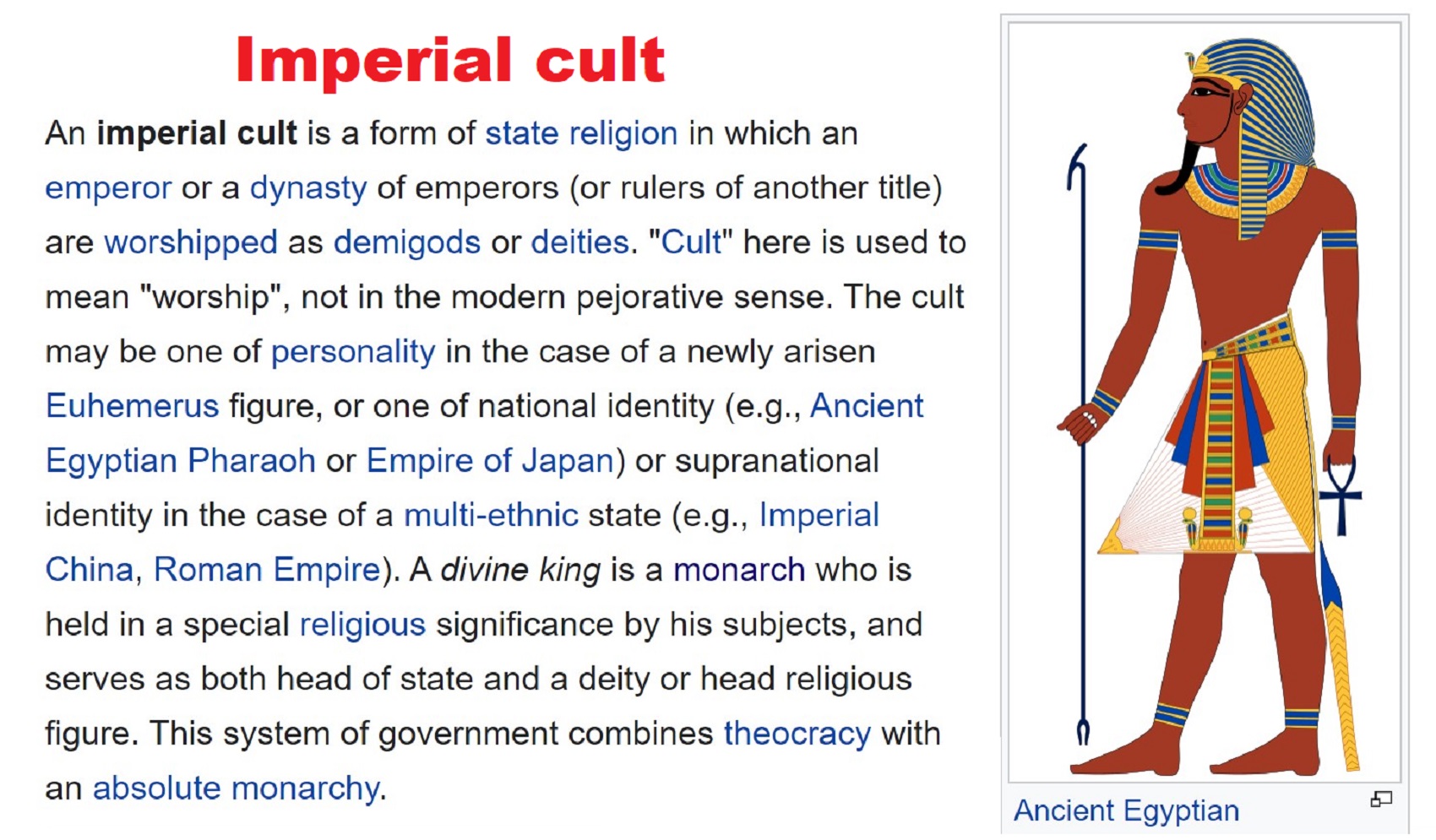

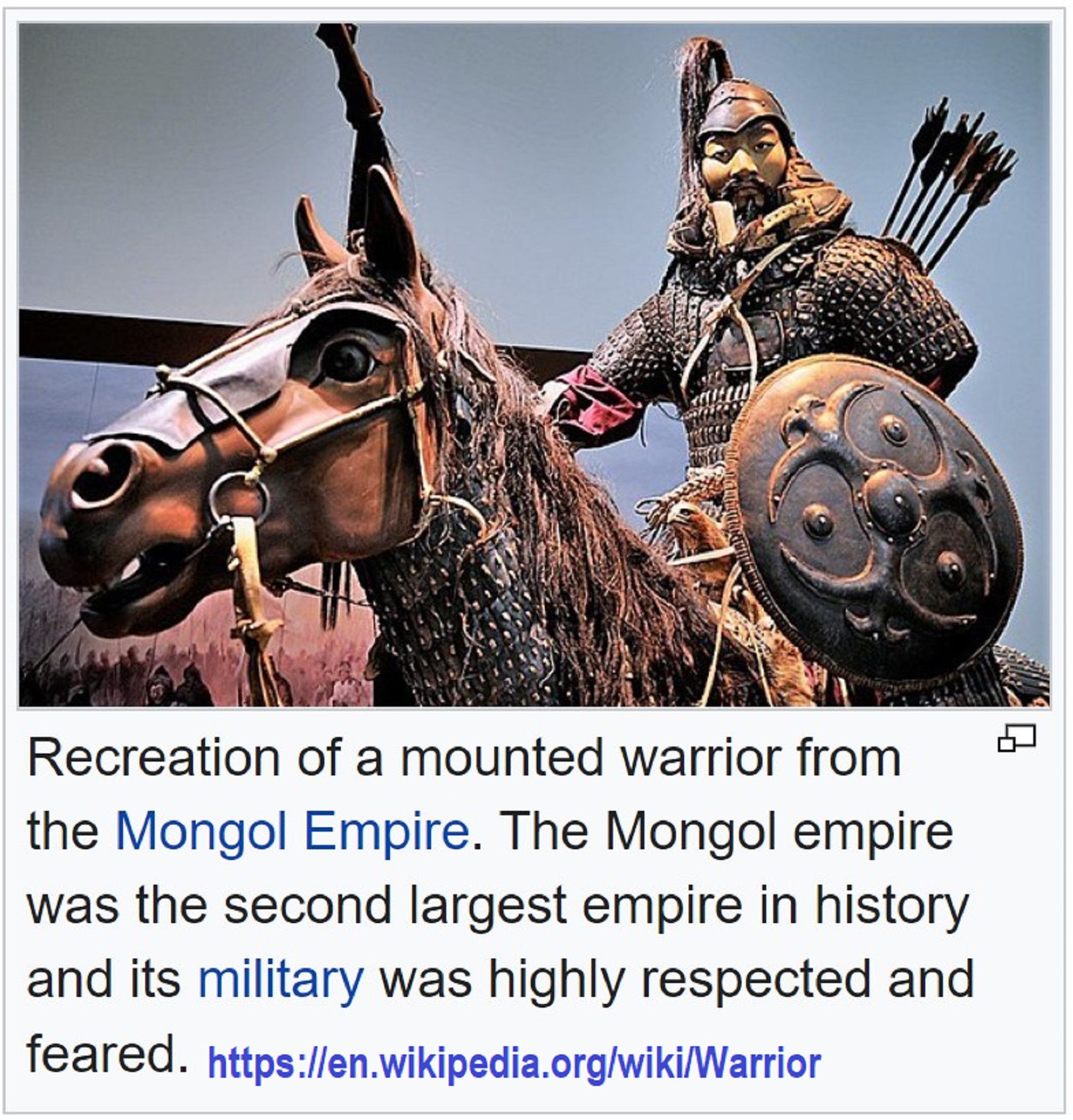
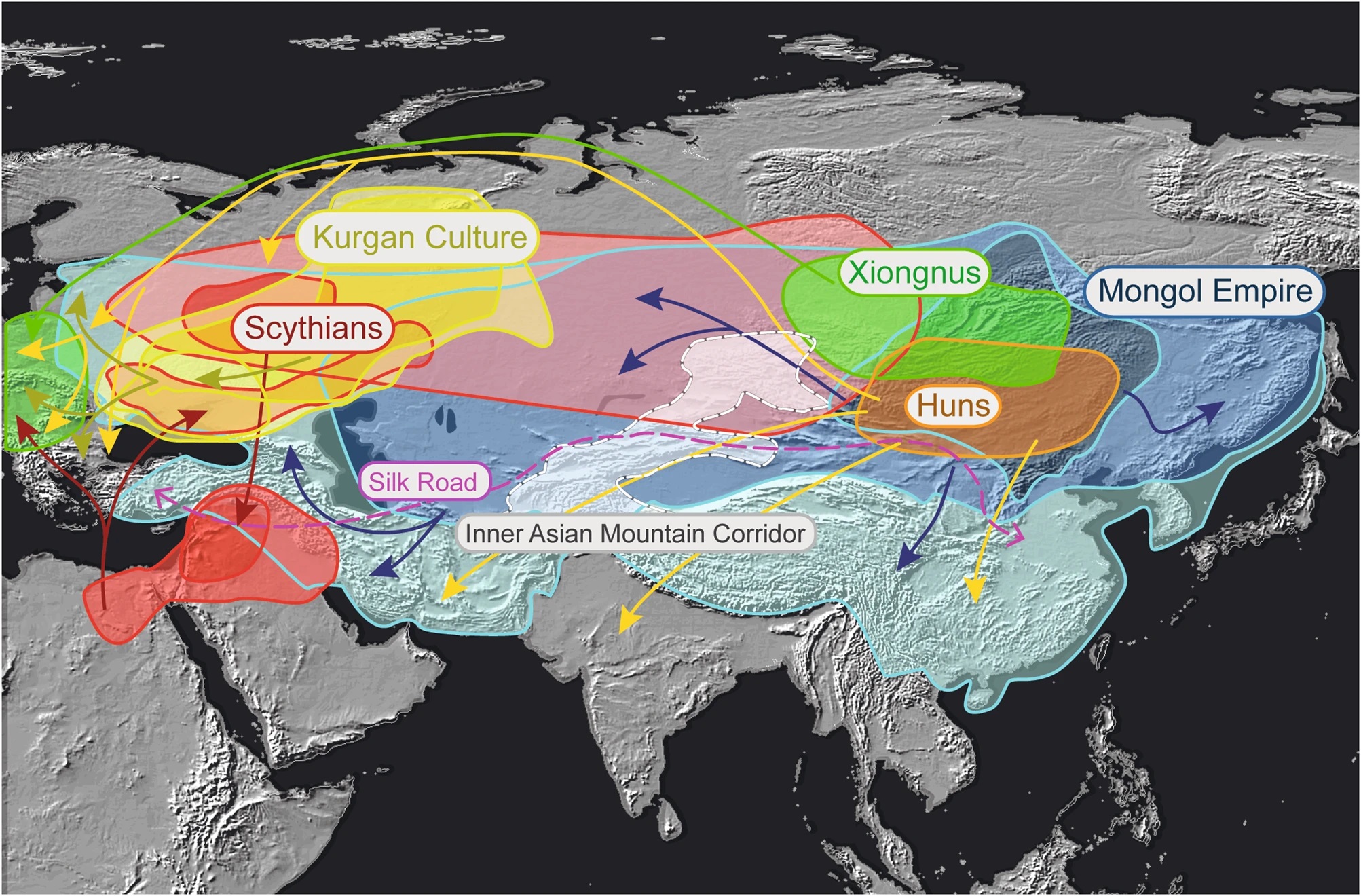
Horse Gods and Goddesses of the Ancient World
“Throughout history, white horses have been mythologized in many cultures. For example, Herodotus reported that white horses were held as sacred animals in the Achaemenid court of Xerxes the Great (ruled 486–465 BCE), In more than one tradition, a white horse carries patron saints or the world savior in the end times, including Hinduism, Christianity, and Islam.” ref
Aine: The Red Horse Goddess
“Aine is an Irish Celtic horse goddess and Fairy Queen who healed and granted fertility to her followers. Cnoc Aine in Knockainey was Aine’s center of worship. In ancient times, royalty performed marriages on top the hill to honor Aine and to seal the kingship. This act means Aine was an important sovereignty goddess. Aine’s sacred lake, Lough Gur, which isn’t far from Cnoc Aine, was used as a place of healing and transition from this life to the next.” ref
Aine’s Magical Abilities
“Aine was a fertility goddess, but also a goddess of healing, sovereignty, the otherworld, and abundance. As a fairy queen, she could shapeshift like any other fairy. She often turned into a large red mare, which made her a sacred horse goddess to the Celts. The color red signified the otherworld, bloodline, and the occult mysteries, which makes Aine a psychopomp to the afterlife.” ref
Ares the Horse God & His Warrior Horses
“Ares, the Greek god of war, was well-known for his destructive ways. Born to Zeus and Hera, Ares was a god that Zeus kept at arm’s distance. The Greeks were wary of Ares, as he had the reputation of being a cruel man-slaughterer. Ares is well-known for his scandalous affair Aphrodite. In this myth, Aphrodite’s angry husband catches Ares in a net and humiliates him in front of the gods.” ref
Ares’ Link to Animals
“Following this event, Ares turned himself into a boar when he learned Aphrodite had fallen in love with another god – Adonis. Then he charged at the boy with all his might. Ares and the horse are closely linked, as well as other animals like the bull and dog. Ares charged into battle in a chariot pulled by two divine horses. On his shield was an emblem of two war-waging, powerful horses. And the ancients sacrificed horses in Ares’ name.” ref
Belenus: The Shining Sun God
“Belenus, also known as Belenos, was a Celtic horse god who survived the Roman conquest and became part of the Gallo-Roman religion. As a sun god, solar wheels are sacred to Belenus. Belenus lends his name to the ancient Celtic sabbat Beltane. He was a sun god, and the beginning of May was once considered the official start to summer in Celtic times. He is sometimes depicted in a horse-drawn chariot similar to Apollo. Clay horse figurine offerings inundated his shrine in Burgundy, France.” ref
Epona: Celtic Goddess of Horses
“No deity’s name evokes the image of the horse quite like the name Epona. Epona was a widely-worshiped Celtic horse goddess in the region that is present-day France and Germany. Her cult survived the Roman conquest and became part of the Gallo-Roman religion. Her name literally means “Great Mare”. Epona the horse goddess ruled over all equine animals including donkeys, ponies, and mules. She is a fertility goddess who carries a cornucopia, grains, and is accompanied by foals.” ref
Freyr: Norse God of Peace and Prosperity (And Horses, Apparently)
“Freyr is the King of the Vanir, the Norse god of peace and prosperity. And while most associate Freyr with his sacred golden boar, he also has a horse ally named Bloody Hoof. In the Poetic Edda, Freyr gifts a divine horse to his messenger. This horse may have been Bloody Hoof, though the poem doesn’t clarify. In the Icelandic sagas, Freyr is closely associated with horse cults in the new settlement.” ref
Rhiannon: Welsh Fairy Queen & Horse Goddess
“Rhiannon is a Welsh mythical figure from The Mabinogion. She is a beautiful fairy maiden who marries a mortal Welsh king. Her story is a sad, yet inspiring one. Rhiannon is blamed for murdering her kidnapped son. She’s punished in a horrifying manner, while also grieving for her lost son. They strip away her dignity and force her to carry the castle’s guests on her back like a horse. Rhiannon never runs away or complains; she believes her good character will be restored. Her story is one of hope and strength and is empowering to women who have been oppressed or abused.” ref
Rhiannon’s Connection to Horses
“Rhiannon is a fairy goddess and therefore has dominion over wildlife, but her favorite animals are birds and horses. In the Mabinogi, Rhiannon is a mare and her son is a foal. She’s so strongly related to horses that scholars believe she could be the Welsh version of the continental horse goddess Epona. The fact she carries people around on her back like a horse is strong enough evidence to relate her to horses. Not to mention when her mortal husband first pursues her, Rhiannon escapes on her fairy horse.” ref
Shango and the Black Horse
“Shango is a horse god in the Yoruba religion. He is an Orisha of thunder, justice, virility, and fire (among other things). In legend, he was the fourth king of Oyo, the second dynasty of Oduduwa, in the Yoruba empire in West Africa. His consorts were Oshun, Oya, and Obba. He was son to Oddumare in some legends, and in others, he was the heir of Obbatala and Oddua. His sacred number is six, his colors are red and white, and his sacred day is December fourth because of his comparison to Saint Barbara.” ref
Shango’s Black Horse
“Sources say to place a black horse statue on Shango’s shrine. Shango rides his black horse in ancient sculptures all over Africa. In Medieval Africa, people saw horses as powerful figures – they were owned by warriors and royalty. Because of Shango’s kingship, he has a close association with horses but also because of sacred rituals.” ref
The Icelandic – “Horse of the Gods”
“Hardy, willing, friendly, versatile, sure-footed – the long list of positive breed characteristics puts the Icelandic Horse in a category of its own. Isolated for almost a thousand years, this unique creature is quickly growing in popularity around the globe. DNA evidence shows that Icelandic Horses are genetically linked to the Shetland Pony, the Norwegian Lyng Horse, and the Mongolian Horse. Archeologists believe that Viking explorers and brought their horses from Norway, and the recently conquered Shetland Islands, to Iceland in the late ninth century. Logic dictates that only the strongest and best of their stock would have survived the difficult journey.” ref
No equine breeding stock has been permitted to enter Iceland for almost a thousand years, preserving the “purity” and unique characteristics of the breed. The Icelandic has five natural gaits: walk, trot, tölt, canter, and pace. Not all horses have five gaits, but most have walk, trot, canter, and tölt, which is prized above others. Tölt, the “gait of the gods,” is a four beat trot, which is exceptionally smooth. A natural tölter is a joy to ride! Skeið, or “flying pace” is a very lateral gait with suspension. Horses can reach speeds of 35 miles per hour in pace. It feels like you are flying!” ref
Horses in Slavic Mythology
“As I finish up my first draft of book 1 in my Slavic fantasy series, my Slavic Saturday posts continue with an animal that plays a crucial role in both Slavic mythology and history: the horse. (June 2021 Updated) Note: If you enjoy Slavic mythology, check out A Dagger in the Winds, the first book in my Slavic fantasy series called The Frostmarked Chronicles. You can also join my monthly newsletter for updates and free novellas (such as the prequel, The Rider in the Night) set in the world of the series.” ref
“The three animals that appear the most in Slavic myths are the bear, the wolf, and the horse. In that trio, it would at first seem the horse is the odd one out. Both wolves and bears were seen as powerful forces of nature, though, and to the Slavs, the horse was no different.” ref
“As we talked about in my post about the Wenedowie/Veneti early Slavic tribe, agriculture was the center of their economy and way of life. And the key to their advanced agriculture was their early invention of the plow, which would often be pulled by horses. They helped farmers constantly. Without them, farming would have been a far more difficult ordeal (though it still was with their help). Horses held the power to carry and pull what humans could not, and that meant the early Slavs also saw each side of the horse—both the tender and the wild.” ref
“The multitude of sides to the horse are reflected in the many gods represented by it. Jaryło (Jarilo/Yarilo), a god of agriculture and spring, was often pictured riding a white horse with the coming of spring. One of his sisters, Dziewanna (Devana), was the goddess of the wilds and hunt, and her symbol was the mare. Dadźbóg (Dažbog), god of the sun, was said to be riding a chariot through the sky with three horses: gold, silver, and diamond. But not all the perceptions were positive. Czarnobóg (Chernobog), a dark god, rode a black horse when he faced his rival, Białobóg (Belobog), who rode a white horse.” ref
“This horse’s importance doesn’t stop with deities, though. In rituals conducted by wróżbici diviners, the behavior of horses would be used to determine whether the tribe should march to war or not. During weddings, horses were also considered to symbolize the young groom, and during many festivals, people dressed up as horses or rode them to symbolize great creatures or battles.” ref

The “wheel” related word list
“Most linguists argue that the PIEs (Proto-Indo-Europeans) did have words for wheel. The candidates put forward for wheel or wagon-related words are nine reconstructed PIE word forms. These are:
- *hurki , argued to mean “wheel”
- *roteh2, argued to mean “wheel”
- *kwékwlo-, argued to mean “wheel”
- *kwelh1-, argued to mean “turn” perhaps in the sense of a turning wheel.
- *h2eks-, argued to mean “axle”
- *h2ih3s-, argued to mean “thill” or “wagon shaft”
- *wéĝh-, argued to mean “convey in a vehicle”
- *h3nebh-, argued to mean “nave” or “wheel hub”
- *iugó-, argued to mean “yoke” ref

ref, ref, ref, ref, ref, ref, ref, ref, ref, ref, ref, ref, ref, ref, ref, ref, ref
“The shaman is, above all, a connecting figure, bridging several worlds for his people, traveling between this world, the underworld, and the heavens. He transforms himself into an animal and talks with ghosts, the dead, the deities, and the ancestors. He dies and revives. He brings back knowledge from the shadow realm, thus linking his people to the spirits and places which were once mythically accessible to all.–anthropologist Barbara Meyerhoff” ref
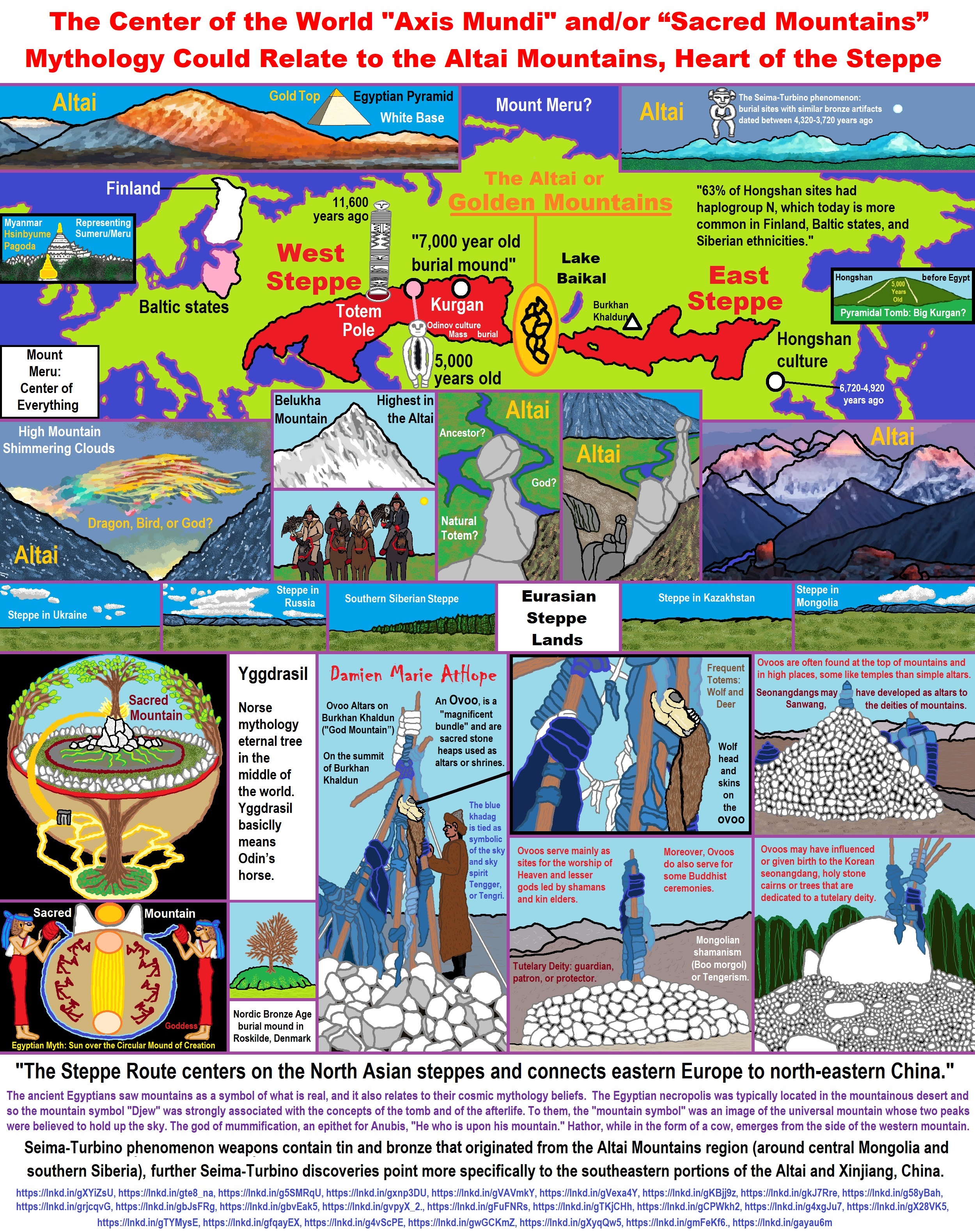
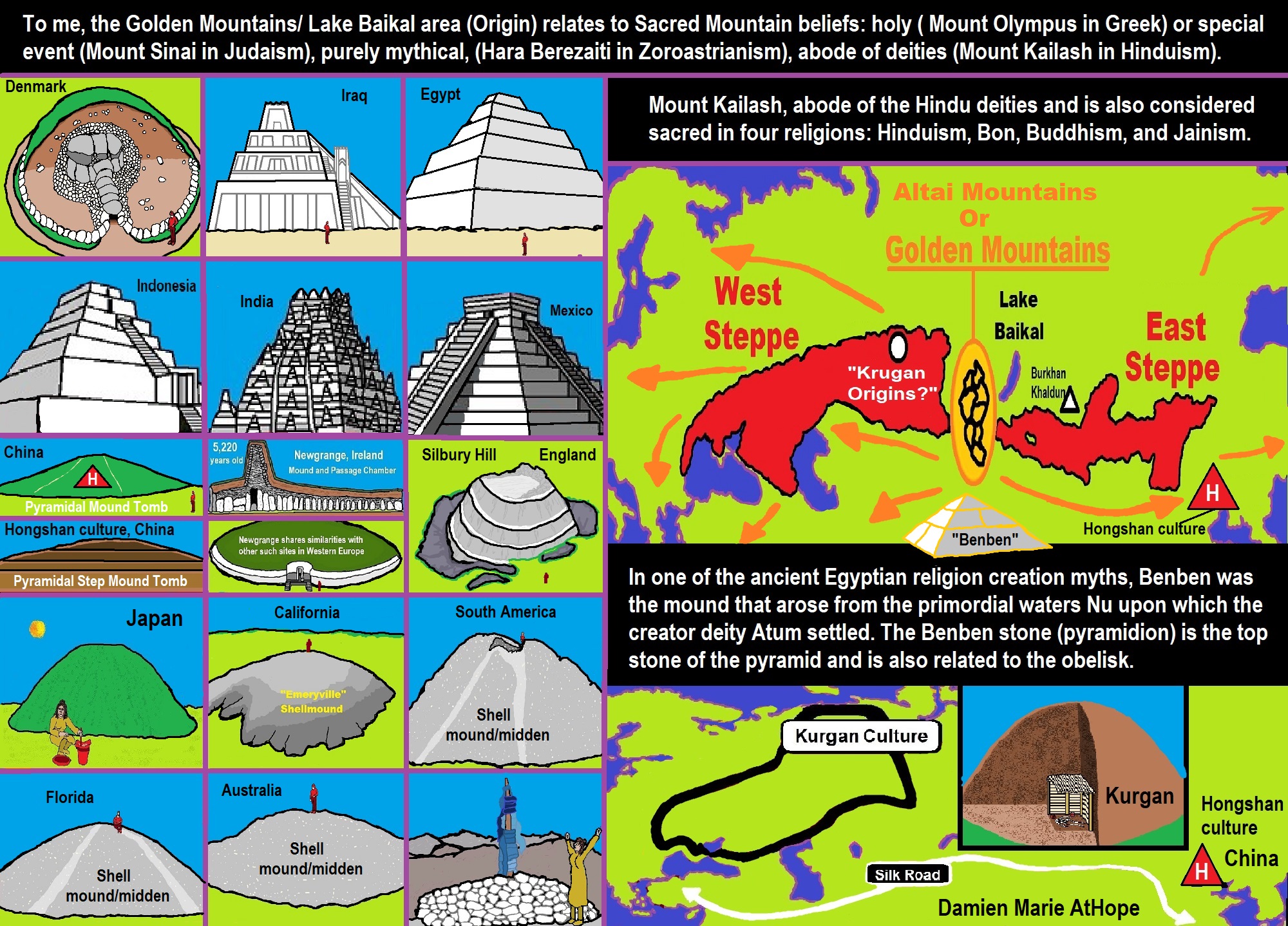
Chariot Origins at the Eurasian steppe
“A chariot is a type of carriage driven by a charioteer, usually using horses to provide rapid motive power. The oldest known chariots have been found in burials of the Sintashta culture in modern-day Chelyabinsk Oblast, Russia, dated to c. 2000 BCE. The critical invention that allowed the construction of light, horse-drawn chariots was the spoked wheel.” ref
“The chariot was a fast, light, open, two-wheeled conveyance drawn by two or more horses that were hitched side by side, and was little more than a floor with a waist-high guard at the front and sides. It was initially used for ancient warfare during the Bronze and Iron Ages, but after its military capabilities had been superseded by light and heavy cavalries, chariots continued to be used for travel and transport, in processions, for games, and in races.” ref
Ancient Horse Burials of the Bronze Age: Folklore and Superstition
“Horses have long been an important aspect in both western and eastern cultures. They are considered common in Indo-European traditions, with Chinese and Turkish traditions providing the most well-known from the east. It is significant that horse burials can be dated as far back as the Early Bronze Age, as there are few other animals that appear to hold such a valued position irrespective of culture. The earliest evidence comes from Newgrange in Ireland, a complex dating approximately to 2400 BCE, and horses remained prominent in Ireland until the present.” ref
“In the traditions of Ireland, Britain, and Scandinavia, horses have been known to represent warfare, fertility, status, and power, and this has often been indicated by the wealth of material culture discovered in graves, bogs, and other subterranean locations which have preserved the finds. Wheeled vehicles and harnesses are not uncommonly discovered, and horseshoes are symbols of good luck (even today) and have been found among other iron and horse-related objects included in both inhumations and cremations. While this work is intended to focus on horse burials in relation to Ireland in particular, it is important to note their affiliation with other neighboring cultures to emphasize the importance of horses in both religious and non-religious environments.” ref
“Horse skulls have also been found buried in foundations, and it has been the arduous task of archaeologists and ethnographers to determine what the purpose of those skulls might have been. As argued by Duffy (2015), there could be ritualistic and non-ritualistic implications. Though absolute certainty cannot be known without specific documentation to confirm, that there are two likely avenues by which these burials can be categorized reveals once again the pertinence of horses in Irish culture.” ref
“On the one hand, the skulls could be just what they appear to be: foundational burials. The ritual implications of this could have been akin to the placement of family heads in the walls and niches of houses in Çatalhöyük—that is, these burials could have been to ensure the good favor from both gods and ancestors, possibly ensuring this appreciation in lieu of being in possession of the actual remains of ancestors.” ref
“Horses are also popular in fairy lore up to the present and it is also possible that these burials served some purpose to ensure protection against the Otherworld, as indicated by Fanny D. Bergen (1895). Bergen discusses the various ways in which horses prove helpful against supernatural powers in Irish culture, such as their ability to feel evils “invisible to men” and thus protect their owners accordingly.” ref
“The opposing view of these ritualistic examples is that some foundational burials under homes and barns might have had a more practical purpose relating to the dispersal of supernatural spirits indirectly. Threshing was commonly practiced during the harvest, an activity requiring farmers to beat grains against the ground to dislodge the edible parts from the inedible. Dancing, meanwhile, was a popular social pastime in Irish culture, as evidenced by their longstanding céilí traditions and mythological texts.” ref
“According to a study by Moriarty (2015), the placement of horse skulls under the floorboards was intended enhance the resonance the sound of sound, improving the acoustics of these common locations. According to Hukantaival (2009), these skulls—referred to as “acoustic skulls”—it was “considered important that the sound of threshing carried far” and “it is well known that in many cultures loud noises are considered to expel evil forces”. While threshing was an important activity in Irish culture to cultivate grains, dancing was an equally important aspect of the social culture. The horse skulls would emphasize the loud echoes of the dancers’ feet just as it would the sounds of the threshing thereby protecting them during regular activities.” ref
“However, the aforementioned examples from the works of Duffy, Moriarty, and Hukantaival are not the only reasons why horses have been found buried. As mentioned at the beginning of this article, horses have been included in burials since the Early Bronze Age. Excavators have determined that the inclusion of a horse or the accoutrements of a horse (i.e., harness, bridle, and so on) were intended for various reasons, such as to exhibit the status of the deceased or to ensure the dead had transport to the Otherworld/underworld.” ref
“Depending on the culture, the inclusion of the horse served a variety of roles. While the precise reasons might never be known with absolute certainty, records can help in deducing the purposes. In Irish culture in particular, mythological texts like the Ulster Cycle, Lebor Gabála Érenn, Táin Bó Cúailnge, etc., laws codes, works of art (such as sculpture) all served to indicate the likely reasons for the burial of horses in particular. Nonetheless, though the practice of burying horse skulls has greatly decreased in popularity, horses still remain a valued aspect of Irish culture as suggested by present superstitions and the continued appreciation of mythology and lore.” ref
Horse Sacrifice?
“Horse sacrifice is the ritual killing and offering of a horse, usually as part of a religious or cultural ritual. Horse sacrifices were common throughout Eurasia with the domestication of the horse and continuing up until the spread of Abrahamic religions, or in some places like Mongolia, of Buddhism. The practice is rarely observed in some cultures even today. The Gaulish personal name Epomeduos is from ek’wo-medhu- (“horse + mead”), while aśvamedha is either from ek’wo-mad-dho- (“horse + drunk”) or ek’wo-mey-dho- (“horse + strength”).” ref
“Many ethnic religions from Indo-European speaking peoples show evidence for horse sacrifice, and comparative mythology suggests that they derive from a purported Proto-Indo-European ritual and common root, though the practice is also observed among non-Indo-European speaking peoples, especially in nomadic societies from the Eurasian steppe. Some scholars, including Edgar Polomé, regard the reconstruction of a purported common Proto-Indo-European ritual as unjustified due to the difference between the attested traditions.” ref
“Horses are often sacrificed in a funerary context, and interred with the deceased, a practice called horse burial. There is evidence but no explicit myths from the three branches of Indo-Europeans of a major horse sacrifice ritual based on a speculated mythical union of Indo-European kingship and the horse. The Indian Aśvamedha is the clearest evidence preserved, but vestiges from Latin and Celtic traditions allow the reconstruction of a few common attributes.” ref
“The reconstructed myth involves the coupling of a king with a divine mare which produced the divine twins. A related myth is that of a hero magically twinned with a horse foaled at the time of his birth (for example Cuchulainn, Pryderi), suggested to be fundamentally the same myth as that of the divine twin horsemen by the mytheme of a “mare-suckled” hero from Greek and medieval Serbian evidence, or mythical horses with human traits (Xanthos), suggesting totemic identity of the hero or king with the horse.” ref
Comparative Horse Sacrifice Rituals
Vedic (Indian) Horse Sacrifice: Ashvamedha
“Ashvamedha was a political ritual that was focused on the king’s right to rule. The horse had to be a stallion and it would be permitted to wander for a year, accompanied by people of the king. If the horse roamed off into lands of an enemy then that territory would be taken by the king, and if the horse’s attendants were killed in a fight by a challenger then the king would lose the right to rule. But if the horse stayed alive for a year then it was taken back to the king’s court where it was bathed, consecrated with butter, decorated with golden ornaments, and then sacrificed. After the completion of this ritual, the king would be considered as the undisputed ruler of the land which was covered by the horse.” ref
- “the sacrifice is connected with the elevation or inauguration of a member of the Kshatriya warrior caste
- the ceremony took place in spring or early summer
- the horse sacrificed was a stallion which won a race at the right side of the chariot
- the horse sacrificed was white-colored with dark circular spots, or with a dark front part, or with a tuft of dark blue hair
- it was bathed in water, in which mustard and sesame are mixed
- it was suffocated alongside a hornless ram and a he-goat, among other animals
- the chief queen lay down with the suffocated horse beneath a linen blanket and mimicked sexual intercourse with it, while the other queens perambulated the scene, slapping their thighs and fanning themselves
- the stallion was dissected along the “knife-paths” — with three knives made from gold, copper, and iron — and its portions awarded to various deities, symbolically invoking sky, atmosphere, and earth, while other priests started reciting the verses of Vedas, seeking healing and rejuvenation for the horse.” ref
Roman Horse Sacrifice
“The Roman Equus October ceremony involved:
- “the horse was dedicated to Mars, the Roman god of war
- the sacrifice took place on the Ides of October, but through ritual reuse was used in a spring festival (the Parilia)
- two-horse chariot races determined the victim, which was the right-hand horse of the winning team
- the horse is dismembered: the tail (cauda, possibly a euphemism for the penis) is taken to the Regia, the king’s residence, while two factions battle for possession of the head as a talisman for the coming year.” ref
Irish Horse Sacrifice
“Geraldus Cambrensis recorded a ceremony among the Irish:
There is in a northern and remote part of Ulster, among the Kenelcunil, a certain tribe which is wont to install a king over itself by an excessively savage and abominable ritual. In the presence of all the people of this land in one place, a white mare is brought into their midst. Thereupon he who is to be elevated, not to a prince but to a beast, not to a king but to an outlaw, steps forward in beastly fashion and exhibits his bestiality. Right thereafter the mare is killed and boiled piecemeal in water, and in the same water a bath is prepared for him. He gets into the bath and eats of the flesh that is brought to him, with his people standing around and sharing it with him. He also imbibes the broth in which he is bathed, not from any vessel, nor with his hand, but only with his mouth. When this is done right according to such unrighteous ritual, his rule and sovereignty are consecrated.” ref
The major points of comparison involve:
- “The king (most likely; Geraldus is somewhat indirect) engages in sexual intercourse with the mare to be sacrificed;
- The horse is dismembered and cooked in a cauldron, and consumed by the king who is also sitting in the cauldron.” ref
Norse Horse Sacrifice
“The Völsa þáttr mentions a Norse pagan ritual involving veneration of the penis of a slaughtered stallion. A freshly cut horse head was also used in setting up a nithing pole for a Norse curse. The Norse ceremony according to the description in Hervarar saga of the Swedish inauguration of Blot-Sweyn, the last or next to last pagan Germanic king, c. 1080:
- the horse is dismembered for eating
- the blood is sprinkled on the sacred tree at Uppsala.” ref
Horse Sacrifice Archaeology?
“The primary archaeological context of horse sacrifice are burials, notably chariot burials, but graves with horse remains reach from the Eneolithic well into historical times. Herodotus describes the execution of horses at the burial of a Scythian king, and Iron Age kurgan graves known to contain horses number in the hundreds. There are also frequent deposition of horses in burials in Iron Age India. The custom is by no means restricted to Indo-European populations, but is continued by Turkic tribes.” ref
Horse Burial?
“Horse burial is the practice of burying a horse as part of the ritual of human burial, and is found among many Indo-European speaking peoples and others, including Chinese and Turkic peoples. The act indicates the high value placed on horses in the particular cultures and provides evidence of the migration of peoples with a horse culture. Human burials that contain other livestock are rare; in Britain, for example, 31 horse burials have been discovered but only one cow burial, unique in Europe. This process of horse burial is part of a wider tradition of horse sacrifice. An associated ritual is that of chariot burial, in which an entire chariot, with or without a horse, is buried with a dead person.” ref
“The horse carries great symbolic meaning in human cultures (see horse worship). In Celtic and Germanic cultures, for instance, the horse “could be associated with the journeying sun”, and horses were deified and used in divination, but Celtic horse sacrifice is rare whereas horses were regularly sacrificed and buried alongside dead humans in Germany and Scandinavia. The Indo-European ubiquity and importance of horse sacrifice (which in many cases involves a symbolic coupling between king and mare) attests to this importance.” ref
“Considerable differences exist between different horse burials even within a single area and culture, so much so that it is perhaps impossible to generalize. Sometimes horses were cremated, sometimes buried; sometimes they were placed in the same grave as humans, sometimes in a different pit; some cultures appear to favor horse burial for male warriors, others did not seem to differentiate in gender.” ref
“The practice of horse burial is bound to the historical territory covered by the domesticated horse, which initially was the Eurasian Steppe, ca. 4000–3500 BCE. Early cultures with a mythology that would support horse burial are those in or bordering those areas—Turkic cultures, Chinese cultures, and Indo-European cultures.” ref
“It is claimed that a form of horse burial is attested from the Paleolithic, when the skin of a horse was hung over a pole; some of the animal’s bones were left inside the skin to preserve its shape. This supposed “head and hooves” culture, however, is only one explanation for archeological finds from the third millennium BCE. The earliest proven horse burial in the Old World dates back to the fifth or fourth millennium BCE and is found in S’ezzhee, in a cemetery on the Volga from the Samara culture.” ref
“Thousands of years later, Herodotus described the practice among the Scythians. Typically, such burials involved the sacrifice and burial of one or more horses to accompany the remains of high-ranked members or warriors. In China, horse burials (including chariots) are found beginning in the Shang Dynasty (1600–1100 BCE). Remains of the ritual are found in Kazakh culture, where a dead person’s horse is slaughtered a year after its owner’s death, in a ceremony accompanied by horse races. Horse burial and related rituals survived among other peoples as well into recent times, for instance among the Nez Perce people (where skinned and stuffed horses were used as grave monuments) and the Blackfoot Confederacy.” ref
“Sites featuring horse burials are found throughout the regions of the world occupied by Indo-Aryan, Turkic, and Chinese peoples. They include Tall al-Ajjul (Gaza strip, dating back to 2100 BCE), Central Iran, where horse burials are attested in the second millennium BCE, Marlik (in Iran, from the late second millennium BCE), and Gordium (in Phrygia, with horse burials attested possibly after 700 BCE). A horse burial from Bactria provides evidence of the migration in the second millennium BCE of horse cultures from Central Asia into Turkmenistan. A horse burial in Tell el-Dab’a, Egypt, evidences the introduction of the horse to Egypt by the Hyksos, in the Second Intermediate Period of Egypt (1650–1550 BCE).” ref
“A nomad’s kurgan burial of around 700 BCE at Kostromskaya in southern Russia included, as well as the principal male body with his accoutrements, thirteen humans with no adornment above him, and around the edges of the burial twenty-two horses buried in pairs. Horse burials are part of the Pazyryk burials, where lavishly decked-out horses were killed and sometimes buried in chambers separate from those containing human remains. They were characteristic in pre-Christian Hungary (one horse burial was excavated in Mikulčice, another in Sterlitamak) of the ninth and tenth centuries, especially for rich members of society, where people were buried next to the skin and the skull of a saddled horse; the rest of the horse meat was possibly eaten during a burial ceremony. Roman culture left horse burials throughout their empire, including first-century burials in modern-day Waremme, Belgium, and Beuningen, Netherlands.” ref
Horse Burial Among Germanic cultures?
“Germanic peoples attached great significance to the horse; a horse may have been an acquaintance of the god Wodan, and they may have been (according to Tacitus) confidants of the gods. Scandinavian literature from the 8th to 11th centuries emphasizes the importance of horses in Viking society. Horses were closely associated with gods, especially Odin and Freyr. Horses played a central role in funerary practices as well as in other rituals. Horses were prominent symbols of fertility, and there were many horse fertility cults. The rituals associated with these include horse fights, burials, consumption of horse meat, and horse sacrifice.” ref
“Hengist and Horsa, the mythical ancestors of the Anglo-Saxons, were associated with horses, and references to horses are found throughout Anglo-Saxon literature. Actual horse burials in England are relatively rare and “may point to influence from the continent”. A well-known Anglo-Saxon horse burial (from the sixth/seventh century) is Mound 17 at Sutton Hoo, a few yards from the more famous ship burial in Mound 1. A sixth-century grave near Lakenheath, Suffolk, yielded the body of a man next to that of a “complete horse in harness, with a bucket of food by its head.” Another prominent example is the Wulfsen horse burial dated to 700–800 AD, near Hamburg Germany.” ref
“Horse burials are relatively widespread in Iceland; as of 1999, 115 graves were found that contained the remains of horses. There were so many graves in which the remains of a human female was associated with those of a horse, that it was speculated that a horse burial in association with a male warrior did not occur in Iceland.” ref
“Examination of the archaeological record in Norway has revealed some patterns that are comparable to horse burials in other areas. Of the six-hundred graves excavated forty of them are horse burials. Horse burials are found in both Norway and Iceland to occur more frequently with males, but are not exclusive to males. There are some female burials with horses, but a significantly lower number of them are found. Most graves are covered by circular or oval mounds. The grave goods found in Viking burials associated with horses in Norway and Iceland are also pretty similar. For male burials there are usually found weapons and tools, and women are usually found with tools, beads, brooches. Both genders are often found buried with riding equipment like horse bits and headstalls.” ref
“Viking burial rituals were complex and dramatic. One witness Ibn Fadlan Risala describes the ship burial ritual in detail. The burial consisted of days of mourning, sewing special burial clothes, dog sacrifice, running horses then cutting them into pieces and putting them in the ship with the deceased, and burning the whole thing. This shows that horse slaughter was dramatic and memorable; it was noted in this story. Also taking into consideration the economic value of horses, it was probably not a decision taken lightly. Given the public display of the sacrifice, it could not have solely been for personal religious reasons and could have had important social implications as well.” ref
Horse Burial Among Chinese culture
“Horse burials are well known from ancient China as well, beginning with the Shang Dynasty. Particularly notable is the tomb of Duke Jing of Qi (reigned 547–490 BCE), which contained a separate pit with the remains of possibly over 600 horses. Later burials, especially from the Tang dynasty, featured the well-known pottery horses.” ref
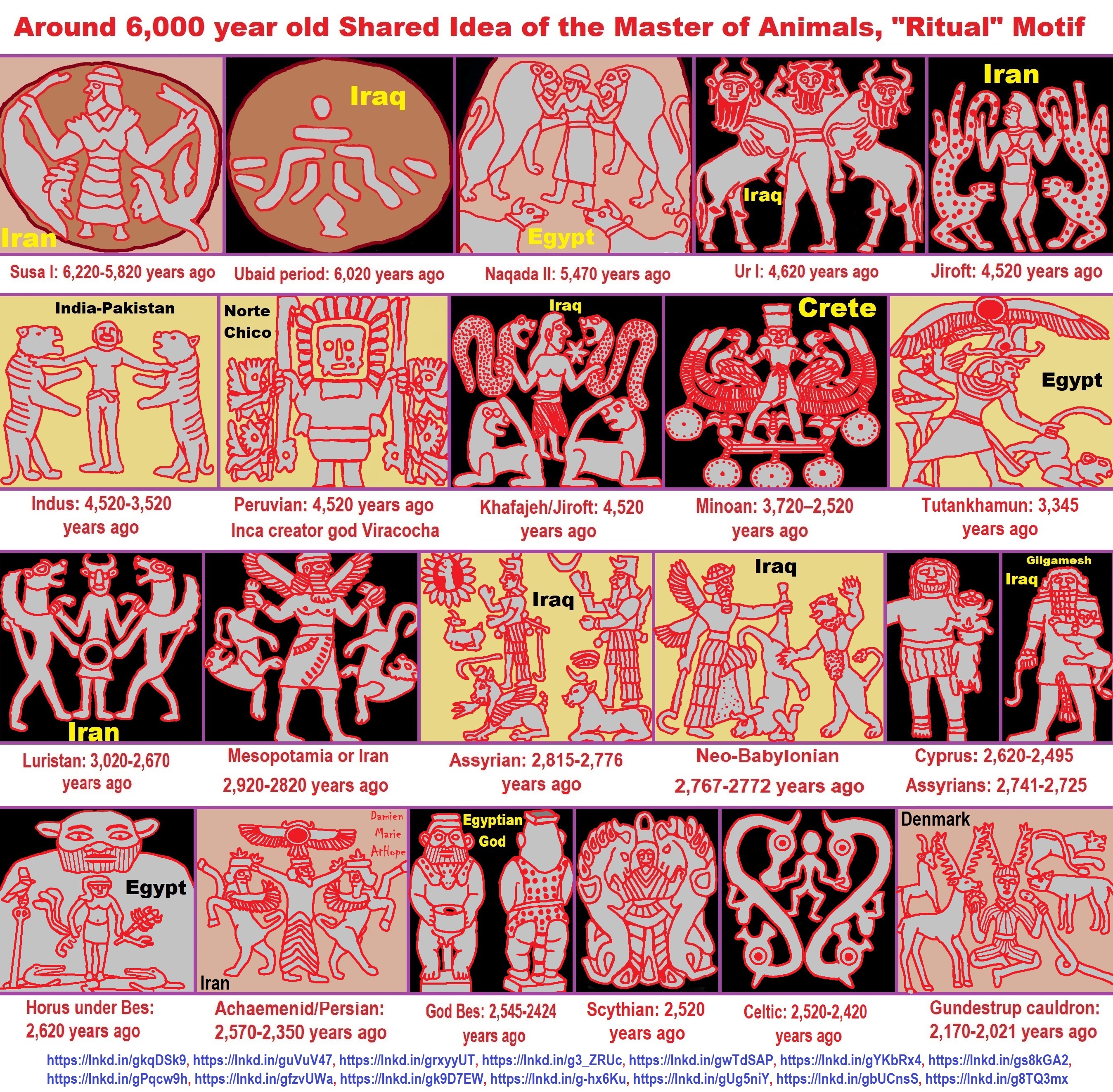
Horse and Sun Gods and Goddesses?
“Riding Across the Sky: Many sun gods and goddesses are humanoid and ride or drive a vessel of some sort across the sky. It may be a boat, a chariot, or a cup. The sun god of the Greeks and Romans, for example, rode in a four-horse (Pyrios, Aeos, Aethon, and Phlegon) chariot. In Hindu traditions, the sun god Surya travels across the sky in a chariot pulled by either seven horses or a single seven-headed horse. The chariot driver is Aruna, the personification of dawn. In Hindu mythology, they fight the demons of darkness.” ref
“There may be more than one god of the sun. The Egyptians differentiated among the aspects of the sun and had several gods associated with it: Khepri for the rising sun, Atum for the setting sun, and Re for the noontime sun, who rode across the sky in a solar bark. The Greeks and Romans also had more than one sun god. Sol (Sunna)NorseSun GoddessShe rides in a horse-drawn solar chariot. Or SuryaHinduSun GodRides the sky in a horse-drawn chariot.” ref
“In Gallo-Roman religion, Epona was a protector of horses, ponies, donkeys, and mules. She was particularly a goddess of fertility, as shown by her attributes of a patera, cornucopia, ears of grain, and the presence of foals in some sculptures. She and her horses might also have been leaders of the soul in the after-life ride, with parallels in Rhiannon of the Mabinogion. The worship of Epona, “the sole Celtic divinity ultimately worshipped in Rome itself”, as the patroness of cavalry, was widespread in the Roman Empire between the first and third centuries AD; this is unusual for a Celtic deity, most of whom were associated with specific localities.” ref
“Although known only from Roman contexts, the name Epona (‘Great Mare’) is from the Gaulish language; it is derived from the inferred Proto-Celtic *ekʷos ‘horse’, which gives rise to modern Welsh ebol ‘foal’, together with the augmentative suffix -on frequently, though not exclusively, found in theonyms (for example Sirona, Matrona) and the usual Gaulish feminine singular -a. In an episode preserved in a remark of Pausanias, an archaic Demeter Erinys (Vengeful Demeter) too had also been a Great Mare, who was mounted by Poseidon in the form of a stallion and foaled Arion and the Daughter who was unnamed outside the Arcadian mysteries. Demeter was venerated as a mare in Lycosoura in Arcadia into historical times.” ref
“Fernand Benoît found the earliest attestations of a cult of Epona in the Danubian provinces and asserted that she had been introduced in the limes of Gaul by horsemen from the east. That suggestion has not been generally taken up. Although the name is Gaulish, dedicatory inscriptions to Epona are in Latin or, rarely, Greek. They were made not only by Celts, but also by Germans, Romans, and other inhabitants of the Roman Empire. An inscription to Epona from Mainz, Germany, identifies the dedicator as Syrian.” ref
“A long Latin inscription of the first century BCE, engraved in a lead sheet and accompanying the sacrifice of a filly and the votive gift of a cauldron, was found in 1887 at Rom, Deux-Sèvres, the Roman Rauranum. Olmsted reads the inscription as invoking the goddess with an archaic profusion of epithets: Eponina ‘dear little Epona’, Atanta ‘horse-goddess’, Potia ‘powerful Mistress’ (compare Greek Potnia), Dibonia (Latin, the ‘good goddess’)”, Catona ‘of battle’, noble and good Vovesia. However, Olmsted’s interpretation has not been generally accepted by other scholars; Meid interprets the same inscription as an invocation of Dibona in vulgar Greek for aid in a romantic dispute.” ref
“Epona’s feast day in the Roman calendar was given as December 18 on a rustic calendar from Guidizzolo, Italy, although this may have been only a local celebration. She was incorporated into the imperial cult by being invoked on behalf of the Emperor, as Epona Augusta or Epona Regina.” ref
“The supposed autonomy of Celtic civilization in Gaul suffered a further setback with Fernand Benoît’s study of the funereal symbolism of the horseman with the serpent-tailed (“anguiforme”) daemon, which he established as a theme of victory over death, and Epona; both he found to be late manifestations of Mediterranean-influenced symbolism, which had reached Gaul through contacts with Etruria and Magna Graecia. Benoît compared the rider with most of the riders imaged around the Mediterranean shores.” ref
“Perceptions of native Celtic goddesses had changed under Roman hegemony: only the names remained the same. As Gaul was Romanized under the early Empire, Epona’s sovereign role evolved into a protector of cavalry. The cult of Epona was spread over much of the Roman Empire by the auxiliary cavalry, alae, especially the Imperial Horse Guard or equites singulares augustii recruited from Gaul, Lower Germany, and Pannonia. A series of their dedications to Epona and other Celtic, Roman, and German deities was found in Rome, at the Lateran. Her cult is said to have been “widespread also in Carinthia and Styria.” ref
“As Epane she is attested in Cantabria, northern Spain, on Mount Bernorio, Palencia; as Iccona Loiminna in Portugal on the Lusitanian inscription of Cabeço das Fráguas. A euhemeristic account of Epona’s origin occurs in the Parallela Minora, which were traditionally attributed to Plutarch (but are now classed as “Pseudo-Plutarch”): Fulvius Stellus hated women and used to consort with a mare and in due time the mare gave birth to a beautiful girl and they named her Epona. She is the goddess that is concerned with the protection of horses. So Agesilaüs in the third book of his Italian History.” ref
“The tale was passed along in the context of unseemly man-beast coupling in Giambattista Della Porta‘s edition of Magia naturalis (1589), a potpourri of the sensible and questionable, erroneously citing Plutarch’s Life of Solon. It may represent some recollection of Indo-European horse sacrifice, such as the Vedic ashvamedha and the Irish ritual described by Giraldus Cambrensis, both of which have to do with kingship. In the Celtic ritual, the king mates with a white mare thought to embody the goddess of sovereignty.” ref
“Sculptures of Epona fall into five types, as distinguished by Benoît: riding, standing or seated before a horse, standing or seated between two horses, a tamer of horses in the manner of potnia theron, and the symbolic mare and foal. In the Equestrian type, common in Gaul, she is depicted sitting side-saddle on a horse or (rarely) lying on one; in the Imperial type (more common outside Gaul) she sits on a throne flanked by two or more horses or foals. In distant Dacia, she is represented on a stela (now at the Szépmüvézeti Museum, Budapest) in the format of Cybele, seated frontally on a throne with her hands on the necks of her paired animals: her horses are substitutions for Cybele’s lions.” ref
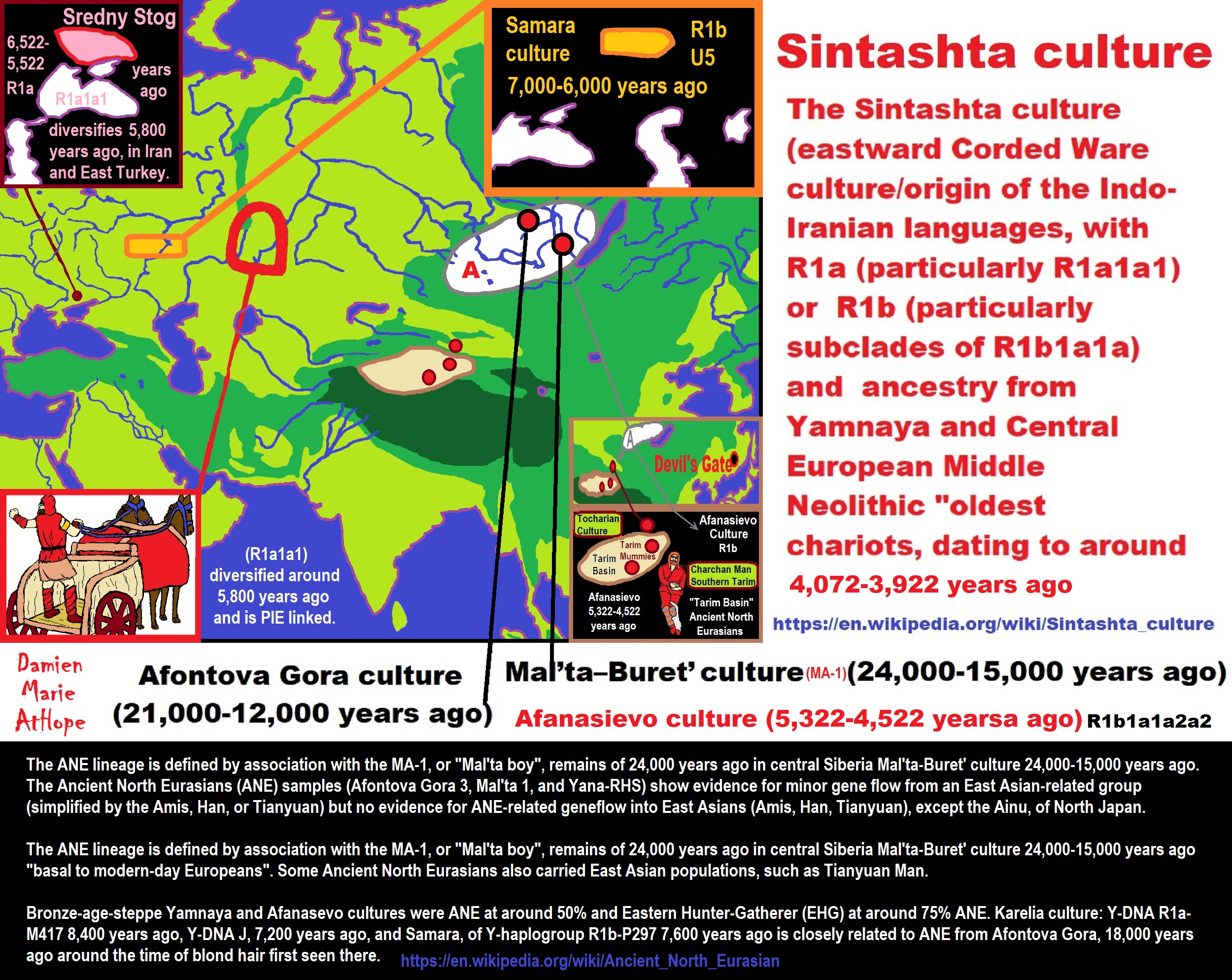
Sintashta Culture
“The Sintashta culture (eastward Corded Ware culture/origin of the Indo-Iranian languages, with R1a (particularly R1a1a1) or R1b (particularly subclades of R1b1a1a) and ancestry from Yamnaya and Central European Middle Neolithic “oldest chariots, dating to around 2050–1900 BCE.” ref
“The oldest known chariots have been found in burials of the Sintashta culture in modern-day Chelyabinsk Oblast, Russia, dated to c. 2000 BCE. The critical invention that allowed the construction of light, horse-drawn chariots was the spoked wheel.” ref
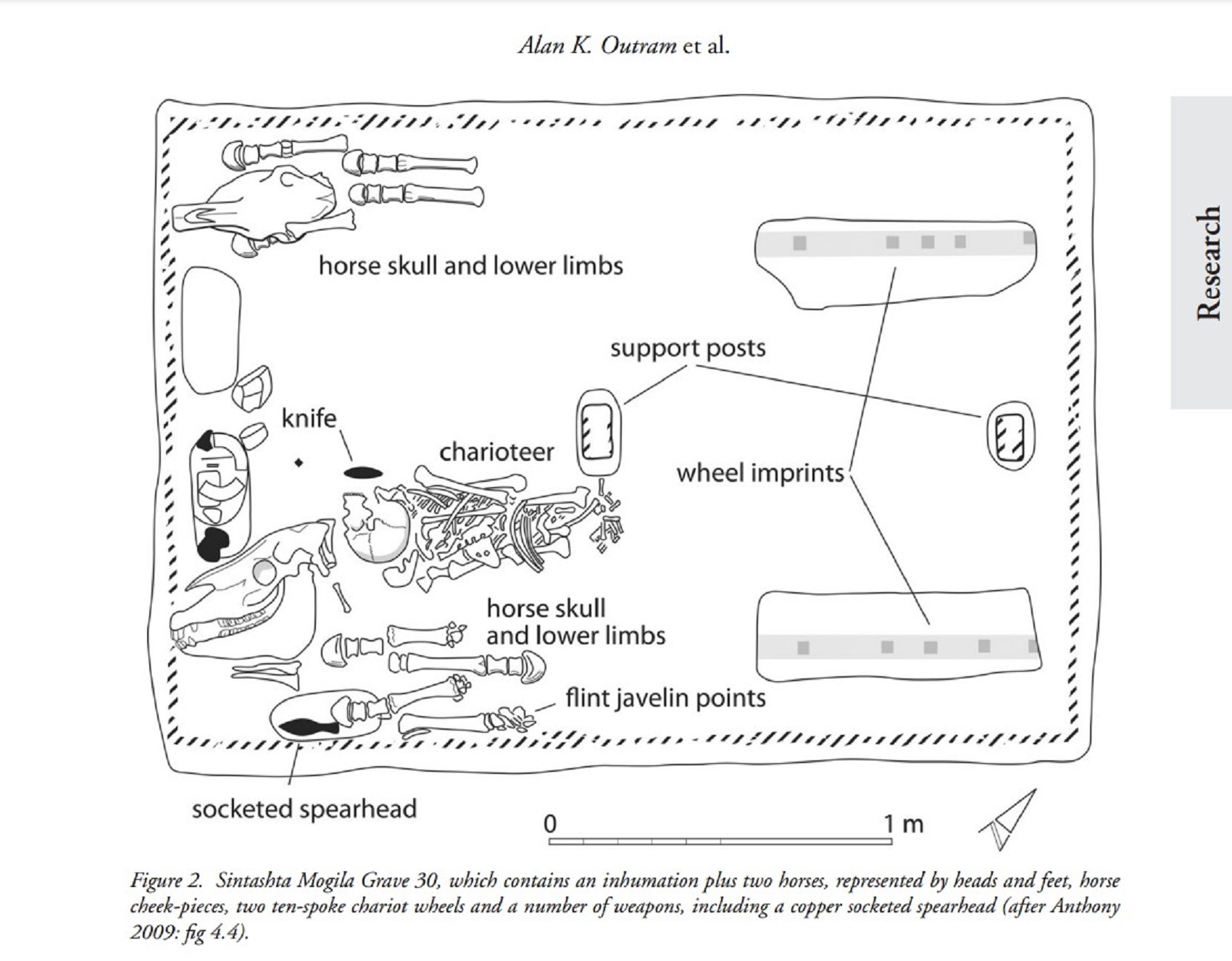
Horse Sacrifice
“The Sintashta culture dates from about 2100–1800 BCE, located along the rivers Ural and Tobol, and their tributaries, in the steppe territory immediately east of the Ural Mountains, with other key settlements being Arkaim, Alandskoye, and Andreyevskoye.” ref
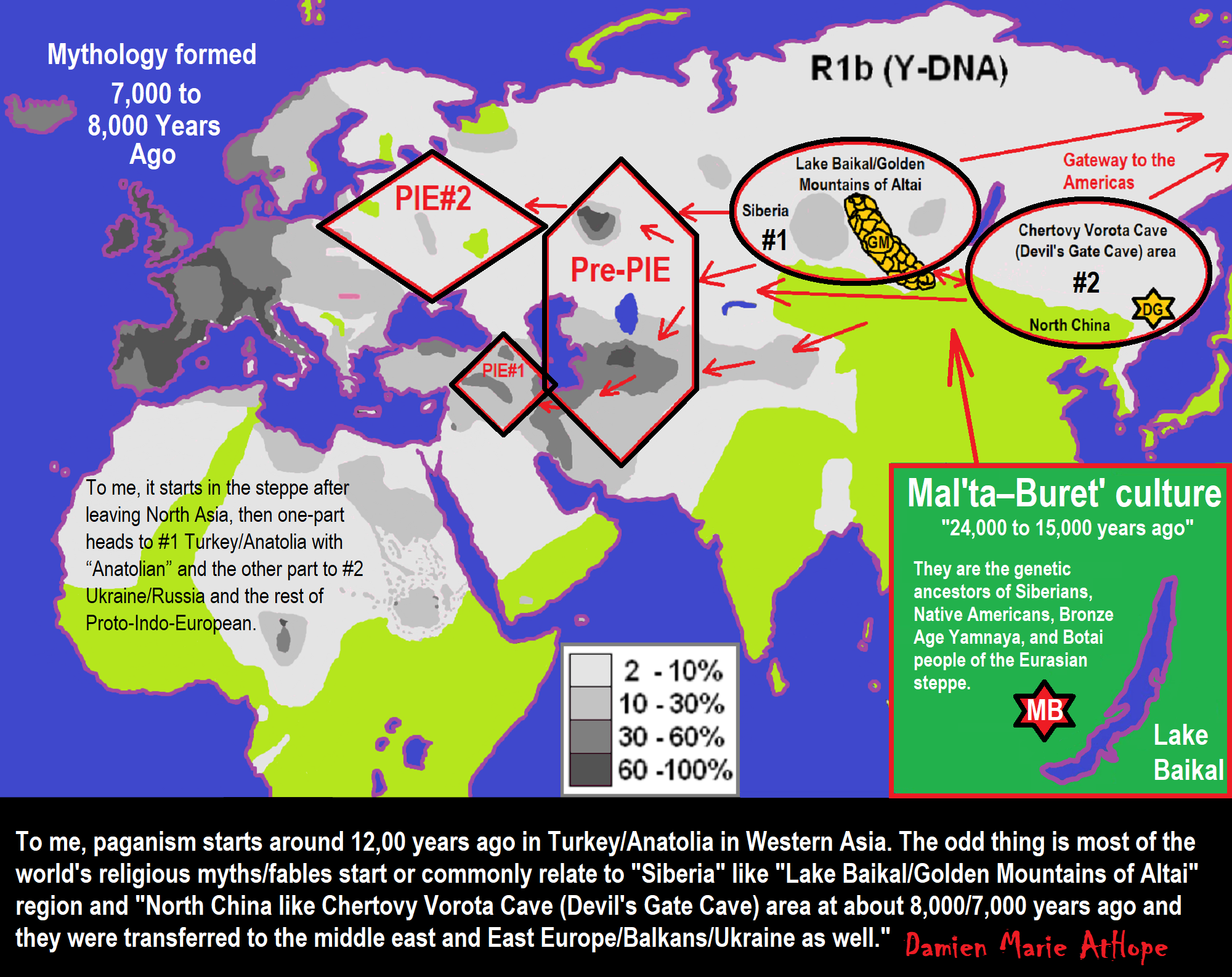
Haplogroup R possible time of origin about 27,000 years in Central Asia, South Asia, or Siberia:
- Mal’ta–Buret’ culture (24,000-15,000 years ago)
- Afontova Gora culture (21,000-12,000 years ago)
- Trialetian culture (16,000–8000 years ago)
- Samara culture (7,000-6,500 years ago)
- Khvalynsk culture (7,000-6,500 years ago)
- Afanasievo culture (5,300-4,500 years ago)
- Yamna/Yamnaya Culture (5,300-4,500 years ago)
- Andronovo culture (4,000–2,900 years ago) ref

“Asian varieties of millet made their way from China to the Black Sea region of Europe by 5000 BCE or 7,000 years ago.” https://en.wikipedia.org/wiki/Millet
Origins of ‘Transeurasian’ languages traced to Neolithic millet farmers in north-eastern China about 9,000 years ago
“A study combining linguistic, genetic, and archaeological evidence has traced the origins of a family of languages including modern Japanese, Korean, Turkish and Mongolian and the people who speak them to millet farmers who inhabited a region in north-eastern China about 9,000 years ago. The findings outlined on Wednesday document a shared genetic ancestry for the hundreds of millions of people who speak what the researchers call Transeurasian languages across an area stretching more than 5,000 miles (8,000km).” ref
“Millet was an important early crop as hunter-gatherers transitioned to an agricultural lifestyle. There are 98 Transeurasian languages, including Korean, Japanese, and various Turkic languages in parts of Europe, Anatolia, Central Asia, and Siberia, various Mongolic languages, and various Tungusic languages in Manchuria and Siberia. This language family’s beginnings were traced to Neolithic millet farmers in the Liao River valley, an area encompassing parts of the Chinese provinces of Liaoning and Jilin and the region of Inner Mongolia. As these farmers moved across north-eastern Asia over thousands of years, the descendant languages spread north and west into Siberia and the steppes and east into the Korean peninsula and over the sea to the Japanese archipelago.” ref
“Eurasiatic is a proposed language with many language families historically spoken in northern, western, and southern Eurasia; which typically include Altaic (Mongolic, Tungusic, and Turkic), Chukchi-Kamchatkan, Eskimo–Aleut, Indo-European, and Uralic.” ref
“Voiced stops such as /d/ occur in the Indo-European, Yeniseian, Turkic, Mongolian, Tungusic, Japonic and Sino-Tibetan languages. They have also later arisen in several branches of Uralic.” ref
“Uralo-Siberian is a hypothetical language family of Uralic, Yukaghir, Eskimo–Aleut and besides linguistic evidence, several genetic studies, support a common origin in Northeast Asia.” ref
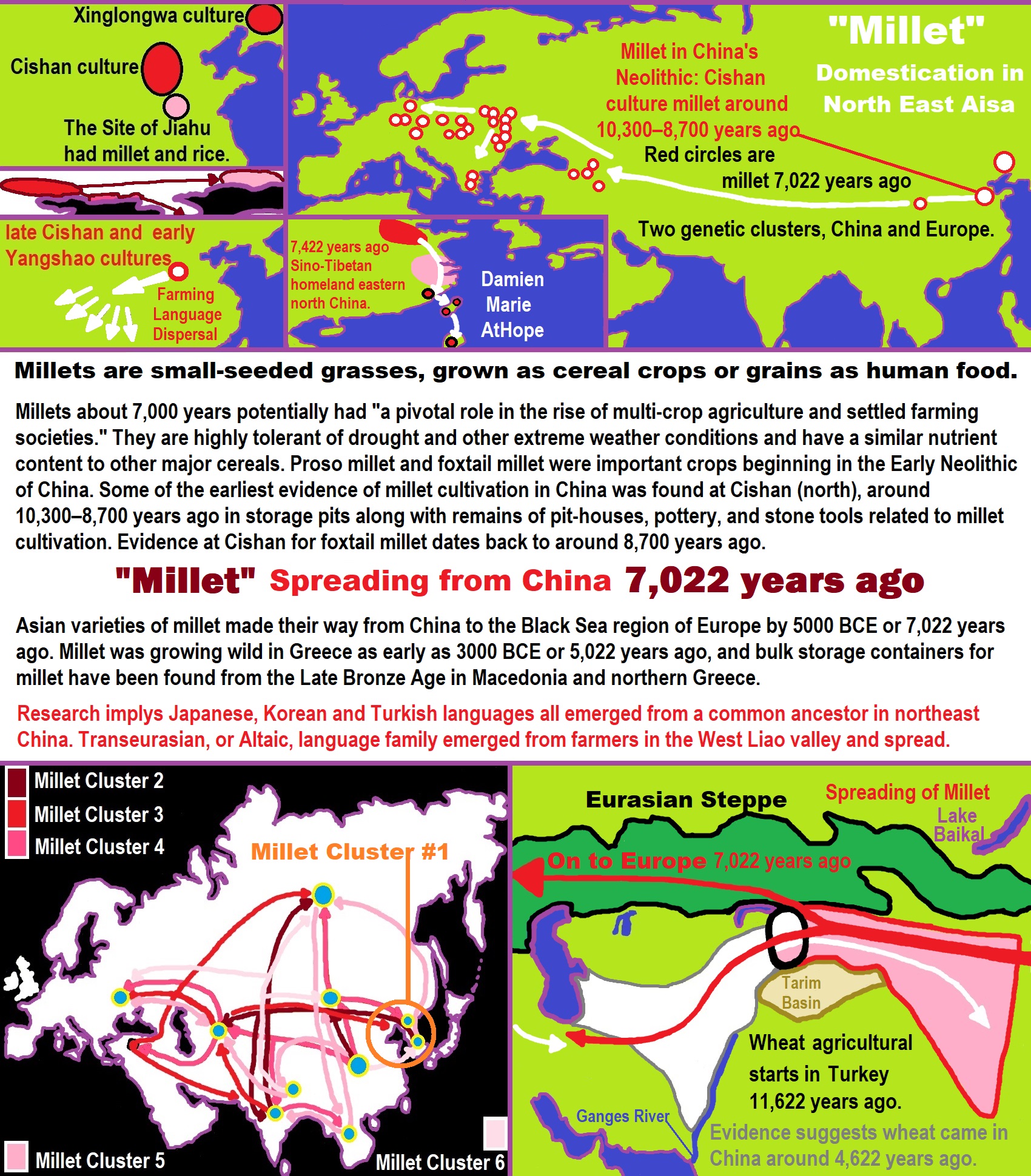
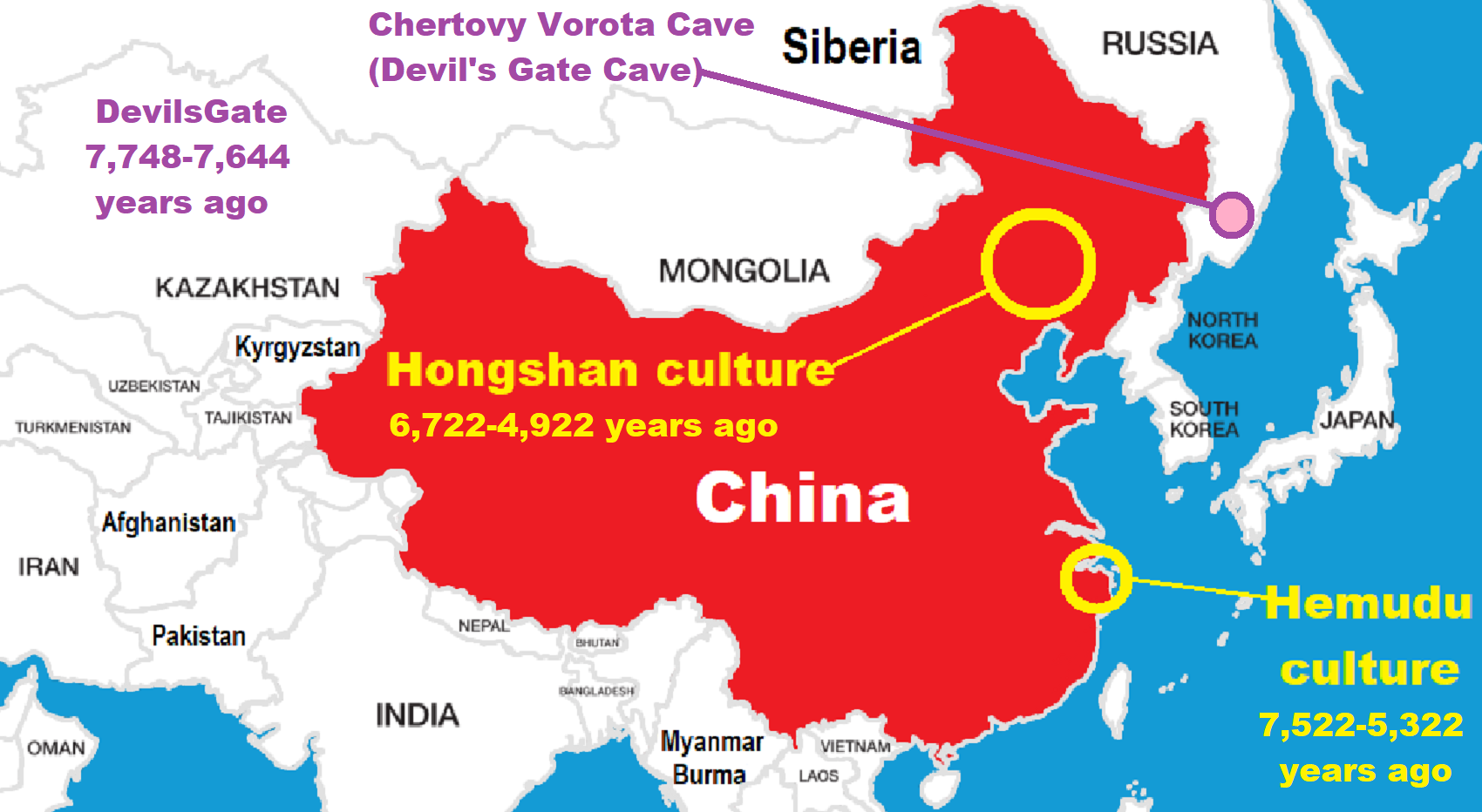

Pic ref
Ancient Women Found in a Russian Cave Turn Out to Be Closely Related to The Modern Population https://www.sciencealert.com/ancient-women-found-in-a-russian-cave-turn-out-to-be-closely-related-to-the-modern-population
Abstract
“Ancient genomes have revolutionized our understanding of Holocene prehistory and, particularly, the Neolithic transition in western Eurasia. In contrast, East Asia has so far received little attention, despite representing a core region at which the Neolithic transition took place independently ~3 millennia after its onset in the Near East. We report genome-wide data from two hunter-gatherers from Devil’s Gate, an early Neolithic cave site (dated to ~7.7 thousand years ago) located in East Asia, on the border between Russia and Korea. Both of these individuals are genetically most similar to geographically close modern populations from the Amur Basin, all speaking Tungusic languages, and, in particular, to the Ulchi. The similarity to nearby modern populations and the low levels of additional genetic material in the Ulchi imply a high level of genetic continuity in this region during the Holocene, a pattern that markedly contrasts with that reported for Europe.” ref
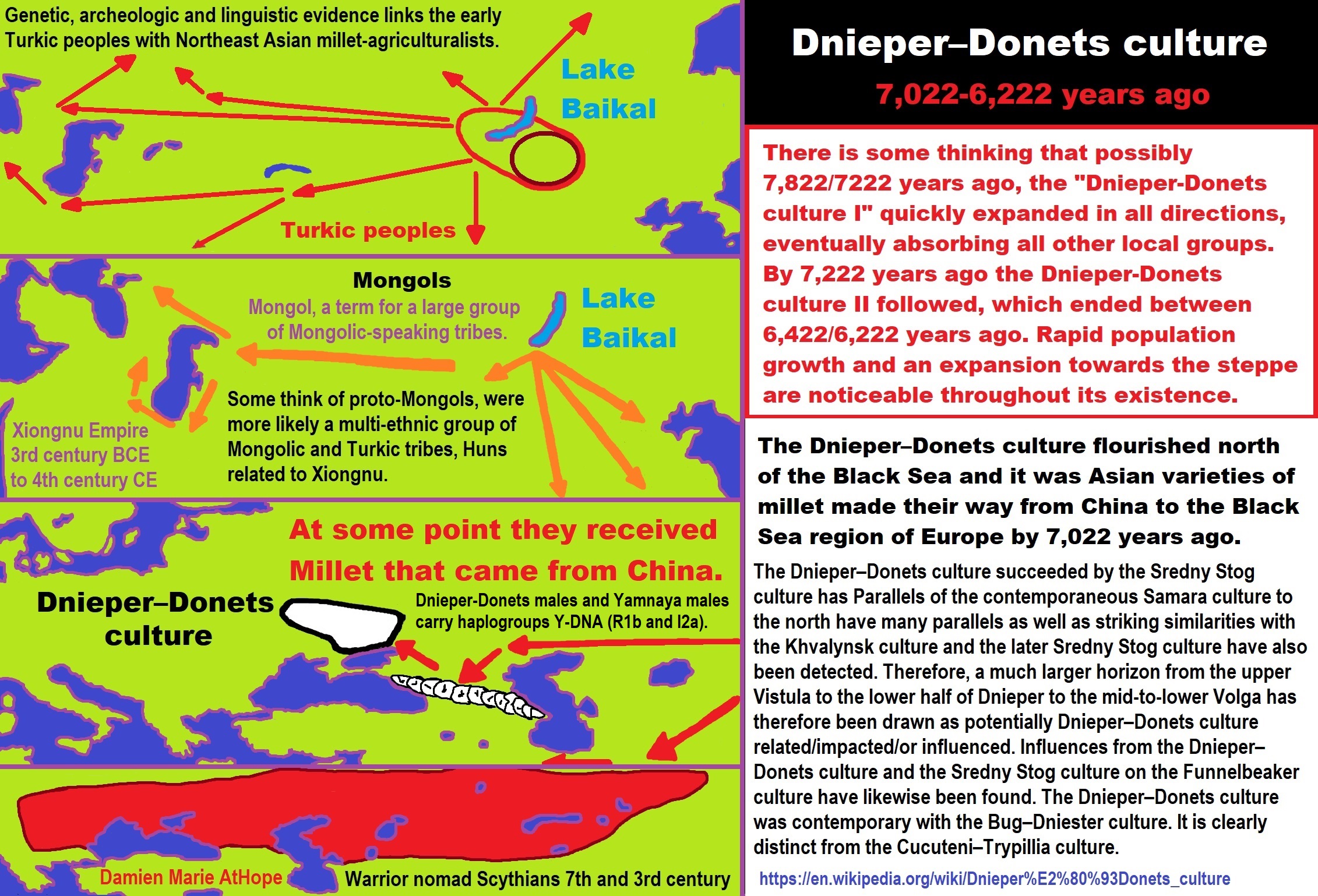


ref, ref, ref, ref, ref, ref, ref
List of Lunar Deities
“In mythology, a lunar deity is a god or goddess of the Moon, sometimes as a personification. These deities can have a variety of functions and traditions depending upon the culture, but they are often related. Some forms of moon worship can be found in most ancient religions. The Moon features prominently in art and literature, often with a purported influence in human affairs. Many cultures are oriented chronologically by the Moon, as opposed to the Sun. The Hindu calendar maintains the integrity of the lunar month and the moon god Chandra has religious significance during many Hindu festivals (e.g. Karwa Chauth, Sankashti Chaturthi, and during eclipses). The ancient Germanic tribes were also known to have a lunar calendar.” ref
“Many cultures have implicitly linked the 29.5-day lunar cycle to women’s menstrual cycles, as evident in the shared linguistic roots of “menstruation” and “moon” words in multiple language families. This identification was not universal, as demonstrated by the fact that not all moon deities are female. Still, many well-known mythologies feature moon goddesses, including the Greek goddess Selene, the Roman goddess Luna, and the Chinese goddess Chang’e. Several goddesses including Artemis, Hecate, and Isis did not originally have lunar aspects, and only acquired them late in antiquity due to syncretism with the de facto Greco-Roman lunar deity Selene/Luna. In traditions with male gods, there is little evidence of such syncretism, though the Greek Hermes has been equated with the male Egyptian lunar god Thoth.” ref
“Male lunar gods are also common, such as Sin of the Mesopotamians, Mani of the Germanic tribes, Tsukuyomi of the Japanese, Igaluk/Alignak of the Inuit, and the Hindu god Chandra. The original Proto-Indo-European lunar deity appears to have been male, with many possible derivatives including the Homeric figure of Menelaus. Cultures with male moon gods often feature sun goddesses. An exception is Hinduism, featuring both male and female aspects of the solar divine. The ancient Egyptians had several moon gods including Khonsu and Thoth, although Thoth is a considerably more complex deity. Set represented the moon in the Egyptian Calendar of Lucky and Unlucky Days.” ref
List of Solar Deities
“A solar deity is a god or goddess who represents the Sun, or an aspect of it, usually by its perceived power and strength. Solar deities and Sun worship can be found throughout most of recorded history in various forms. The following is a list of solar deities. A dawn god or goddess is a deity in a polytheistic religious tradition who is in some sense associated with the dawn. These deities show some relation with the morning, the beginning of the day, and, in some cases, become syncretized with similar solar deities.” ref, ref
Solar deity?
“A solar deity (also sun goddess or sun god) is a sky deity who represents the Sun, or an aspect of it, usually by its perceived power and strength. Solar deities and Sun worship can be found throughout most of recorded history in various forms. The Sun is sometimes referred to by its Latin name Sol or by its Greek name Helios. The English word sun stems from Proto-Germanic *sunnǭ.” ref
“Predynasty Egyptian beliefs attribute Atum as the sun-god and Horus as god of the sky and Sun. As the Old Kingdom theocracy gained power, early beliefs were incorporated with the expanding popularity of Ra and the Osiris-Horus mythology. Atum became Ra-Atum, the rays of the setting Sun. Osiris became the divine heir to Atum’s power on Earth and passed his divine authority to his son, Horus. Early Egyptian myths imply the Sun is within the lioness Sekhmet at night and is reflected in her eyes, or that it is within the cow, Hathor, during the night and reborn each morning as her son (bull).” ref
“Mesopotamian Shamash plays an important role during the Bronze Age, and “my Sun” was eventually used to address royalty. Similarly, South American cultures have a tradition of Sun worship as with the Incan Inti. In Germanic mythology, this is Sol, in Vedic Surya, and in Greek Helios (occasionally referred to as Titan) and (sometimes) as Apollo. In Proto-Indo-European mythology the sun appears to be a multilayered figure, manifested as a goddess but also perceived as the eye of the sky father Dyeus.” ref
Solar mythology?
Three theories exercised great influence on nineteenth and early twentieth-century mythography. These theories were the “solar mythology” of Alvin Boyd Kuhn and Max Müller, the tree worship of Mannhardt, and the totemism of J. F. McLennan. Müller’s “solar mythology” was born from the study of the Indo-European language. Of the Indo-European languages, Müller believed Archaic Sanskrit is the closest to the language spoken by the Aryans.” ref
“Using the Sanskrit names for deities as a base he applied Grimm’s law to names for similar deities from different Indo-European groups to compare their etymological relationships to one another. In this comparison, Müller saw the similarities between the names and used these etymological similarities to explain the similarities between their roles as deities. Through this study Müller concluded that it is the different names for the Sun which led to the creation of multiple solar deities and their mythologies that were passed down from one group to another.” ref
“R. F. Littledale criticized the Sun myth theory when he illustrated that Max Müller on his own principles was himself only a solar myth, whilst Alfred Lyall delivered another attack on the same theory’s assumption that tribal gods and heroes, such as those of Homer, were only reflections of the Sun myth by proving that the gods of certain Rajput clans were actual warriors who founded the clans a few centuries ago, and were the ancestors of the present chieftains.” ref
Solar vessels and Sun chariots
“The Sun was sometimes envisioned as traveling through the sky in a boat. A prominent example is the solar barque used by Ra in ancient Egyptian mythology. The Neolithic concept of a “solar barge” (also “solar bark”, “solar barque”, “solar boat” and “sun boat”, a mythological representation of the Sun riding in a boat) is found in the later myths of ancient Egypt, with Ra and Horus. Several Egyptian kings were buried with ships that may have been intended to symbolize the solar barque, including the Khufu ship that was buried at the foot of the Great Pyramid of Giza.” ref
“Examples of solar vessels include:
- Neolithic petroglyphs which are interpreted as depicting solar barges.
- The many early Egyptian goddesses that were seen as sun deities, and the later gods Ra and Horus were depicted as riding in a solar barge. In Egyptian myths of the afterlife, Ra rides in an underground channel from west to east every night so that he can rise in the east the next morning.
- The Nebra sky disk, which is thought to show a depiction of a solar barge.
- Nordic Bronze Age petroglyphs, including those found in Tanumshede, often contain barges and sun crosses in different constellations.” ref
“The concept the ‘solar chariot’ is younger than that of the solar barge and is typically Indo-European, corresponding with the Indo-European expansion after the invention of the chariot in the 2nd millennium BCE. The reconstruction of the Proto-Indo-European religion features a ‘solar chariot‘ or ‘sun chariot’ with which the Sun traverses the sky. In Chinese culture, the sun chariot is associated with the passage of time. For instance, in the poem Suffering from the Shortness of Days, Li He of the Tang dynasty is hostile towards the legendary dragons that drew the sun chariot as a vehicle for the continuous progress of time.” ref
“Examples of solar chariots include:
- In Norse mythology, the chariot of the goddess Sól, drawn by Arvak and Alsvid. The Trundholm sun chariot dates to the Nordic Bronze Age, more than 2,500 years earlier than the Norse myth, but is often associated with it.
- Greek Helios (or Apollo) riding in a chariot, (see also Phaëton)
- Sol Invictus depicted riding a quadriga on the reverse of a Roman coin.
- Vedic Surya riding in a chariot drawn by seven horses.” ref
“The following is an excerpt from the poem:
I will cut off the dragon’s feet, chew the dragon’s flesh,
so that they can’t turn back in the morning or lie down at night.
Left to themselves the old won’t die; the young won’t cry.” ref
“Solar deities are revered in some of the major world religions. The Sun was also compared to a wheel, for example, in Greek hēlíou kúklos, Sanskrit suryasya cakram, and Anglo-Saxon sunnan hweogul, all theorised to be reflexes of PIE *swelyosyo kukwelos. Scholarship also points to a possible reflex in poetic expressions in Ukrainian folksongs.” ref

- From a Gerzeh/Naqada II Late Predynastic Egyptian palette with a goddess “Bat/Hathor” cow-head sun/stars motif.
- From a Hierakonpolis late Gerzeh/Naqada II Predynastic or early Naqada III Proto-Dynastic Egyptian porphyry fluted bowl with two reliefs on the rim, one of which was a goddess “Hathor/Bat” cow-head sun/stars motif.
- From an Abydos tomb, u-210 which held a small seal with a goddess “Bat/Hathor” sun/stars motif from the Gerzeh/Naqada II Late Predynastic Egyptian period.
- A Mongolian Copper Age bull sun/star shamanism petroglyph
- A Mongolian Bronze Age deer sun/star shamanism petroglyph symbol.
- A Kyrgyzstan Saimaly-Tash possibly Bronze Age shamanism cow-sun person symbol petroglyph.
- Similar X-ray style images among different peoples of the North from Siberia to Central Asia with shamanism petroglyphs of horned animals with sun symbols from possibly as old as the Neolithic to the Bronze Age. ref, ref, ref
Sun Deity likely Gender?
“Solar deities are often thought of as male (and lunar deities being female) but the opposite has more often been the case. In Germanic mythology the Sun is female, and the Moon is male. Other cultures that have sun goddesses include the Lithuanians (Saulė) and Latvians (Saule), the Finns (Päivätär, Beiwe) and the related Hungarians. Sun goddesses are found around the world in Australia (Bila, Wala); in Indian tribal religions (Bisal-Mariamma, Bomong, ‘Ka Sgni) and Sri Lanka (Pattini); among the Hittites (Wurusemu), Egyptians (Hathor, Sekhmet), and Canaanites (Shapash); in the Canary Islands (Chaxiraxi, Magec); in Native America, among the Cherokee (Unelanuhi), Natchez (Oüa Chill/Uwahci∙ł), Inuit (Malina), and Miwok (He’-koo-lās); and in Asia among the Japanese (Amaterasu).” ref
“The cobra (of Pharaoh, son of Ra), the lioness (daughter of Ra), and the cow (daughter of Ra), are the dominant symbols of the most ancient Egyptian deities. They were female and carried their relationship to the sun atop their heads, and their cults remained active throughout the history of the culture. Later a sun god (Aten) was established in the eighteenth dynasty on top of the other solar deities, before the “aberration” was stamped out and the old pantheon re-established. When male deities became associated with the sun in that culture, they began as the offspring of a mother (except Ra, King of the Gods who gave birth to himself).” ref
“In Buddhist cosmology, the bodhisattva of the Sun is known as Sūryaprabha (“having the light of the sun”); in Chinese he is called Rigong Riguang Pusa (The Bright Solar Bodhisattva of the Solar Palace), Rigong Riguang Tianzi (The Bright Solar Prince of the Solar Palace), or Rigong Riguang Zuntian Pusa (The Greatly Revered Bright Solar Prince of the Solar Palace), one of the 20 or 24 guardian devas.” ref
“Sūryaprabha is often depicted with Candraprabha (“having the light of the moon”), called in Chinese Yuegong Yueguang Pusa (The Bright Lunar Bodhisattva of the Lunar Palace), Yuegong Yueguang Tianzi ( The Bright Lunar Prince of the Lunar Palace), or Yuegong Yueguang Zuntian Pusa (The Greatly Revered Bright Lunar Prince of the Lunar Palace). Together with Bhaiṣajyaguru Buddha (Chinese: Yaoshi Fo) these two bodhisattvas constitute the Dongfang San Sheng (Three Holy Sages of the Eastern Quarter). The devas Surya and Candra are also recognized as deities that embody the Sun and Moon, respectively.” ref
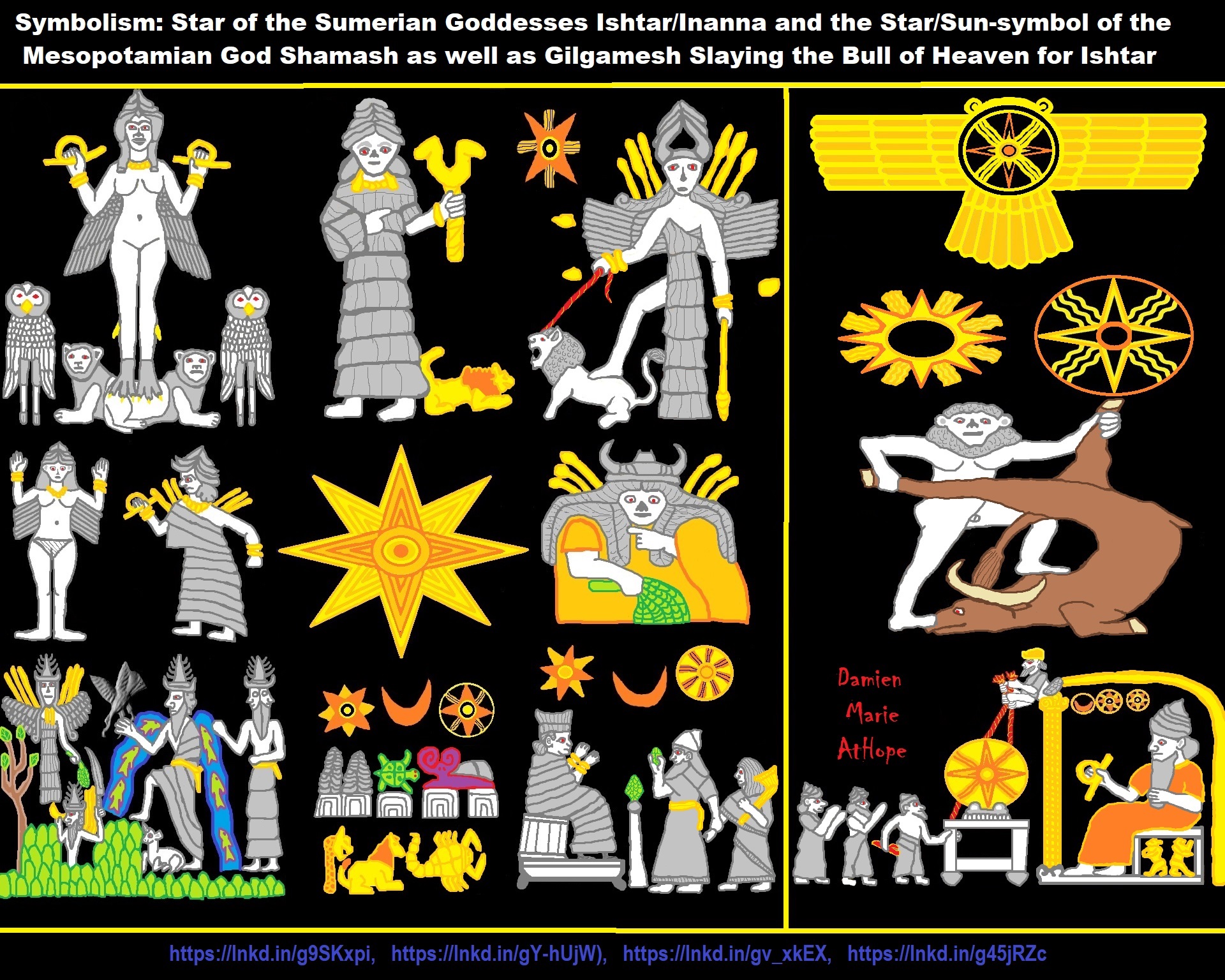
Female Sun Deities
“You may notice that most sun deities are male and act as counterparts to female moon deities, but don’t take this as a given. Sometimes the roles are reversed. There are goddesses of the sun just as there are male deities of the moon. In Norse mythology, for example, Sol (also called Sunna) is the goddess of the sun, while her brother, Mani, is the god of the moon. Sol rides a chariot that is drawn by two golden horses. Another sun goddess is Amaterasu, a major deity in the Shinto religion of Japan. Her brother, Tsukuyomi, is the god of the moon. It is from the sun goddess that the Japanese imperial family is believed to be descended.” ref
Sun Worship?
“Sun worship was prevalent in ancient Egyptian religion. The earliest deities associated with the Sun are all goddesses: Wadjet, Sekhmet, Hathor, Nut, Bast, Bat, and Menhit. First Hathor, and then Isis, give birth to and nurse Horus and Ra. Hathor the horned-cow is one of the 12 daughters of Ra, gifted with joy, and is a wet-nurse to Horus. From at least the 4th Dynasty of ancient Egypt, the Sun was worshipped as the deity Re (pronounced probably as Riya, meaning simply ‘the sun‘), and portrayed as a falcon-headed god surmounted by the solar disk, and surrounded by a serpent. Re supposedly gave warmth to the living body, symbolized as an ankh: a “☥” shaped amulet with a looped upper half.” ref
“The ankh, it was believed, was surrendered with death, but could be preserved in the corpse with appropriate mummification and funerary rites. The supremacy of Re in the Egyptian pantheon was at its highest with the 5th Dynasty, when open-air solar temples became common. In the Middle Kingdom of Egypt, Ra lost some of his preeminence to Osiris, lord of the West, and judge of the dead. In the New Empire period, the Sun became identified with the dung beetle, whose spherical ball of dung was identified with the Sun. In the form of the sun disc Aten, the Sun had a brief resurgence during the Amarna Period when it again became the preeminent, if not only, divinity for the Pharaoh Akhenaton.” ref
“The Sun’s movement across the sky represents a struggle between the Pharaoh’s soul and an avatar of Osiris. Ra travels across the sky in his solar-boat; at dawn he drives away the demon king Apep. The “solarisation” of several local gods (Hnum-Re, Min-Re, Amon-Re) reaches its peak in the period of the fifth dynasty. Rituals to the god Amun who became identified with the sun god Ra were often carried out on the top of temple pylons.” ref
“In the eighteenth dynasty, the earliest-known monotheistic head of state, Akhenaten, changed the polytheistic religion of Egypt to a monotheistic one, Atenism of the solar-disk and is the first recorded state monotheism. All other deities were replaced by the Aten, including Amun-Ra, the reigning sun god of Akhenaten’s own region. Unlike other deities, the Aten did not have multiple forms. His only image was a disk—a symbol of the Sun.” ref
“Soon after Akhenaten’s death, worship of the traditional deities was reestablished by the religious leaders (Ay the High-Priest of Amen-Ra, mentor of Tutankhaten/Tutankhamen) who had adopted the Aten during the reign of Akhenaten. A Pylon mirrored the hieroglyph for ‘horizon’ or akhet, which was a depiction of two hills “between which the sun rose and set,” associated with recreation and rebirth. On the first Pylon of the temple of Isis at Philae, the pharaoh is shown slaying his enemies in the presence of Isis, Horus, and Hathor.” ref
“In Armenian mythology and in the vicinity of Carahunge, the ancient site of interest in the field of archaeoastronomy, people worshiped a powerful deity or intelligence called Ara, embodied as the sun (Ar or Arev). The ancient Armenians called themselves “children of the sun”. (Russian and Armenian archaeoastronomers have suggested that at Carahunge seventeen of the stones still standing were associated with observations of sunrise or sunset at the solstices and equinoxes.
“Those who practice Dievturība, beliefs of traditional Latvian culture, celebrate the Sun goddess, Saule, known in traditional Lithuanian beliefs as Saulė. Saule is among the most important deities in Baltic mythology and traditions.” ref
Sun in Celtic mythology
“The sun in Insular Celtic culture is assumed to have been feminine, and several goddesses have been proposed as possibly solar in character. In Continental Celtic culture, the sun gods, like Belenos, Grannos, and Lug, were masculine. In Irish, the name of the Sun, Grian, is feminine. The figure known as Áine is generally assumed to have been either synonymous with her, or her sister, assuming the role of Summer Sun while Grian was the Winter Sun. Similarly, Étaín has at times been considered to be another theonym associated with the Sun; if this is the case, then the pan-Celtic Epona might also have been originally solar in nature, though Roman syncretism pushed her towards a lunar role.” ref
“The British Sulis has a name cognate with that of other Indo-European solar deities such as the Greek Helios and Indic Surya, and bears some solar traits like the association with the eye as well as epithets associated with light. The theonym Sulevia, which is more widespread and probably unrelated to Sulis, is sometimes taken to have suggested a pan-Celtic role as a solar goddess. She indeed might have been the de facto solar deity of the Celts. The Welsh Olwen has at times been considered a vestige of the local sun goddess, in part due to the possible etymological association with the wheel and the colors gold, white and red. Brighid has at times been argued as having had a solar nature, fitting her role as a goddess of fire and light.” ref
Sun in Chinese mythology
“In Chinese mythology (cosmology), there were originally ten suns in the sky, who were all brothers. They were supposed to emerge one at a time as commanded by the Jade Emperor. They were all very young and loved to fool around. Once they decided to all go into the sky to play, all at once. This made the world too hot for anything to grow. A hero named Hou Yi, honored to this day, shot down nine of them with a bow and arrow to save the people of the Earth.” ref
“In another myth, a solar eclipse was said to be caused by a magical dog or dragon biting off a piece of the Sun. The referenced event is said to have occurred around 2136 BCE; two royal astronomers, Ho and Hi, were executed for failing to predict the eclipse. There was a tradition in China to make lots of loud celebratory sounds during a solar eclipse to scare the sacred beast away.” ref
“The Deity of the Sun in Chinese mythology is Ri Gong Tai Yang Xing Jun (Tai Yang Gong/Grandfather Sun) or Star Lord of the Solar Palace, Lord of the Sun. In some mythologies, Tai Yang Xing Jun is believed to be Hou Yi. Tai Yang Xing Jun is usually depicted with the Star Lord of the Lunar Palace, Lord of the Moon, Yue Gong Tai Yin Xing Jun (Tai Yin Niang Niang/Lady Tai Yin). Worship of the moon goddess Chang’e and her festivals are very popular among followers of Chinese folk religion and Taoism. The goddess and her holy days are ingrained in Chinese popular culture.” ref
Germanic mythology
“In Germanic mythology the sun is personified by Sol. The corresponding Old English name is Siȝel [ˈsijel], continuing Proto-Germanic *Sôwilô or *Saewelô. The Old High German Sun goddess is Sunna. In the Norse traditions, Sól rode through the sky on her chariot every day, pulled by two horses named Arvak and Alsvid. Sól also was called Sunna and Frau Sunne.” ref
Roman historiography Helios and Sol (Roman mythology)
“The first-century historian Tacitus, in his book Germania, mentioned that “beyond the Suiones [tribe]” a sea was located where the sun maintained its brilliance from its rising to its sunset, and that “[the] popular belief” was that “the sound of its emergence was audible” and “the form of its horses visible.” ref
“During the Roman Empire, a festival of the birth of the Unconquered Sun (or Dies Natalis Solis Invicti) was celebrated on the winter solstice—the “rebirth” of the Sun—which occurred on 25 December of the Julian calendar. In late antiquity, the theological centrality of the Sun in some Imperial religious systems suggest a form of a “solar monotheism.” The religious commemorations on 25 December were replaced under Christian domination of the Empire with the birthday of Christ.” ref
Hellenistic mythology
“In Greek mythology, Helios, a Titan, was the personification of the Sun; however, with the notable exception of the island of Rhodes and nearby parts of southwestern Anatolia, he was a relatively minor deity. The Ancient Greeks also associated the Sun with Apollo, the god of enlightenment. Apollo (along with Helios) was sometimes depicted as driving a fiery chariot.” ref
“The Greek astronomer Thales of Miletus described the scientific properties of the Sun and Moon, making their godship unnecessary. Anaxagoras was arrested in 434 BCE and banished from Athens for denying the existence of a solar or lunar deity. The titular character of Sophocles‘ Electra refers to the Sun as “All-seeing”. Hermetic author Hermes Trismegistus calls the Sun “God Visible”. The Minotaur has been interpreted as a solar deity (as Moloch or Chronos), including by Arthur Bernard Cook, who considers both Minos and Minotaur as aspects of the sun god of the Cretans, who depicted the sun as a bull.” ref
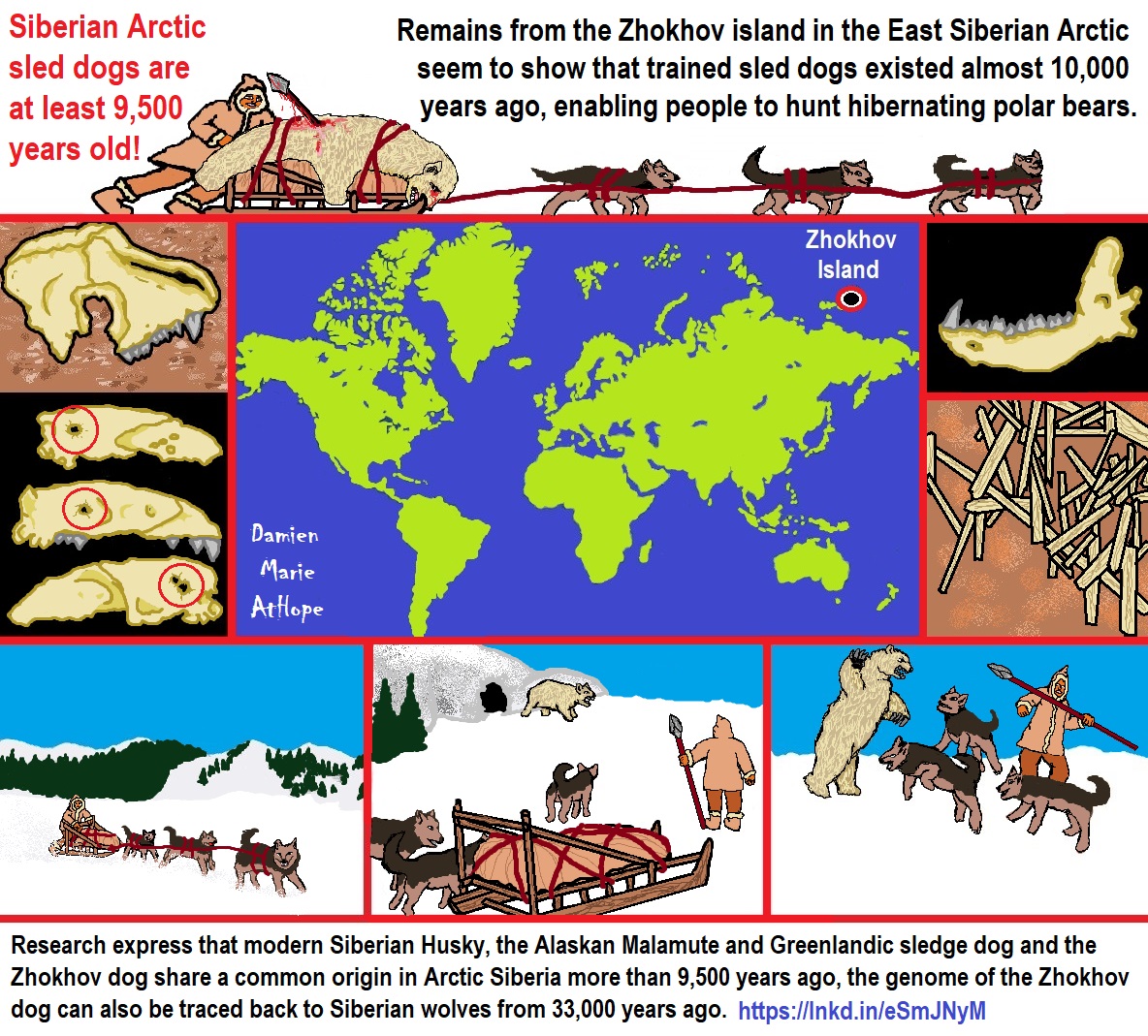


Animism: Respecting the Living World by Graham Harvey
“How have human cultures engaged with and thought about animals, plants, rocks, clouds, and other elements in their natural surroundings? Do animals and other natural objects have a spirit or soul? What is their relationship to humans? In this new study, Graham Harvey explores current and past animistic beliefs and practices of Native Americans, Maori, Aboriginal Australians, and eco-pagans. He considers the varieties of animism found in these cultures as well as their shared desire to live respectfully within larger natural communities. Drawing on his extensive casework, Harvey also considers the linguistic, performative, ecological, and activist implications of these different animisms.” ref

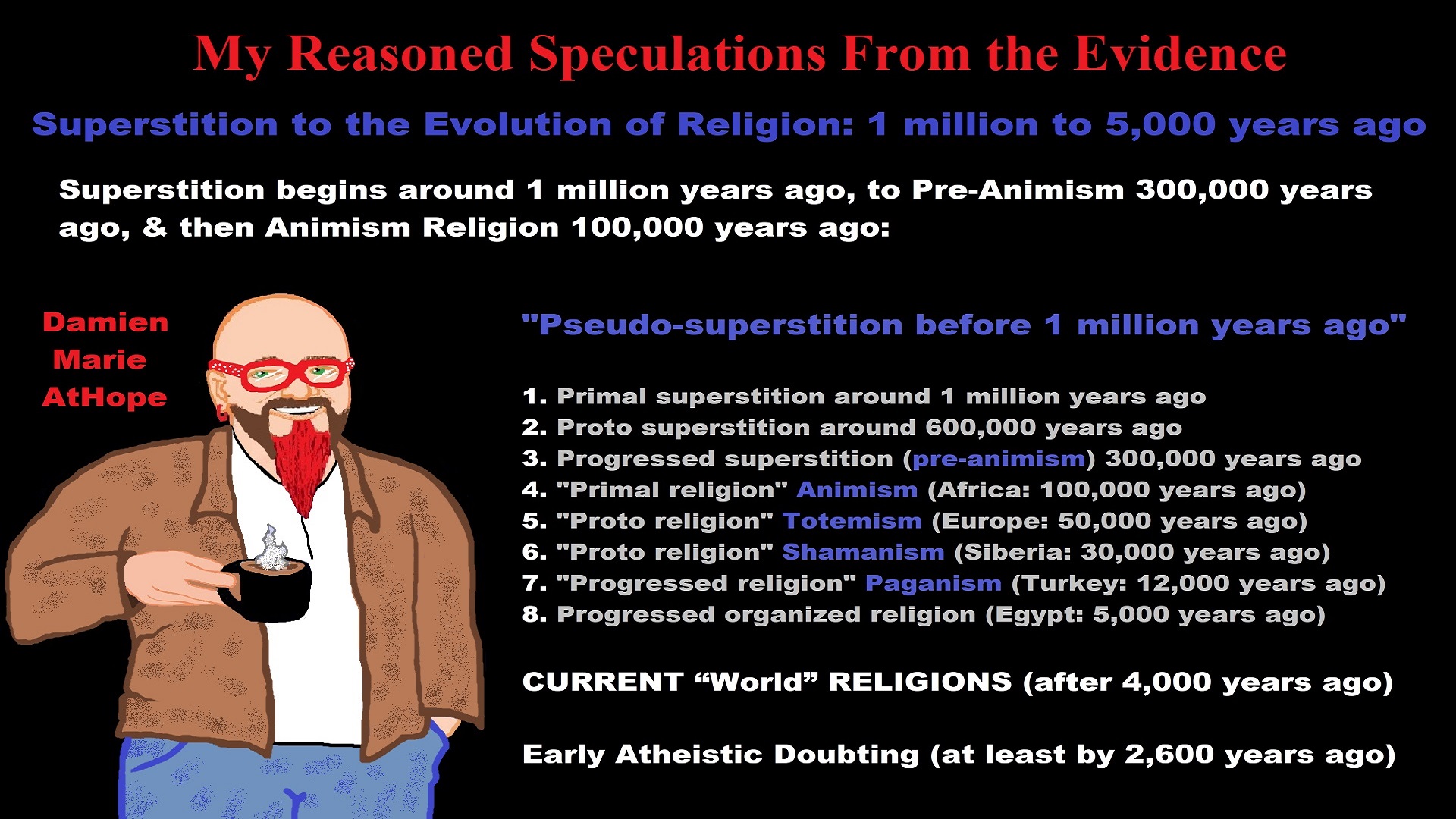
My thoughts on Religion Evolution with external links for more info:
- (Pre-Animism Africa mainly, but also Europe, and Asia at least 300,000 years ago), (Pre-Animism – Oxford Dictionaries)
- (Animism Africa around 100,000 years ago), (Animism – Britannica.com)
- (Totemism Europe around 50,000 years ago), (Totemism – Anthropology)
- (Shamanism Siberia around 30,000 years ago), (Shamanism – Britannica.com)
- (Paganism Turkey around 12,000 years ago), (Paganism – BBC Religion)
- (Progressed Organized Religion “Institutional Religion” Egypt around 5,000 years ago), (Ancient Egyptian Religion – Britannica.com)
- (CURRENT “World” RELIGIONS after 4,000 years ago) (Origin of Major Religions – Sacred Texts)
- (Early Atheistic Doubting at least by 2,600 years ago) (History of Atheism – Wikipedia)
“Religion is an Evolved Product” and Yes, Religion is Like Fear Given Wings…
Atheists talk about gods and religions for the same reason doctors talk about cancer, they are looking for a cure, or a firefighter talks about fires because they burn people and they care to stop them. We atheists too often feel a need to help the victims of mental slavery, held in the bondage that is the false beliefs of gods and the conspiracy theories of reality found in religions.
Understanding Religion Evolution:
- Pre-Animism (at least 300,000 years ago)
- Animism (Africa: 100,000 years ago)
- Totemism (Europe: 50,000 years ago)
- Shamanism (Siberia: 30,000 years ago)
- Paganism (Turkey: 12,000 years ago)
- Progressed organized religion (Egypt: 5,000 years ago), (Egypt, the First Dynasty 5,150 years ago)
- CURRENT “World” RELIGIONS (after 4,000 years ago)
- Early Atheistic Doubting (at least by 2,600 years ago)
“An Archaeological/Anthropological Understanding of Religion Evolution”
It seems ancient peoples had to survived amazing threats in a “dangerous universe (by superstition perceived as good and evil),” and human “immorality or imperfection of the soul” which was thought to affect the still living, leading to ancestor worship. This ancestor worship presumably led to the belief in supernatural beings, and then some of these were turned into the belief in gods. This feeble myth called gods were just a human conceived “made from nothing into something over and over, changing, again and again, taking on more as they evolve, all the while they are thought to be special,” but it is just supernatural animistic spirit-belief perceived as sacred.
Quick Evolution of Religion?
Pre-Animism (at least 300,000 years ago) pre-religion is a beginning that evolves into later Animism. So, Religion as we think of it, to me, all starts in a general way with Animism (Africa: 100,000 years ago) (theoretical belief in supernatural powers/spirits), then this is physically expressed in or with Totemism (Europe: 50,000 years ago) (theoretical belief in mythical relationship with powers/spirits through a totem item), which then enlists a full-time specific person to do this worship and believed interacting Shamanism (Siberia/Russia: 30,000 years ago) (theoretical belief in access and influence with spirits through ritual), and then there is the further employment of myths and gods added to all the above giving you Paganism (Turkey: 12,000 years ago) (often a lot more nature-based than most current top world religions, thus hinting to their close link to more ancient religious thinking it stems from). My hypothesis is expressed with an explanation of the building of a theatrical house (modern religions development). Progressed organized religion (Egypt: 5,000 years ago) with CURRENT “World” RELIGIONS (after 4,000 years ago).
Historically, in large city-state societies (such as Egypt or Iraq) starting around 5,000 years ago culminated to make religion something kind of new, a sociocultural-governmental-religious monarchy, where all or at least many of the people of such large city-state societies seem familiar with and committed to the existence of “religion” as the integrated life identity package of control dynamics with a fixed closed magical doctrine, but this juggernaut integrated religion identity package of Dogmatic-Propaganda certainly did not exist or if developed to an extent it was highly limited in most smaller prehistoric societies as they seem to lack most of the strong control dynamics with a fixed closed magical doctrine (magical beliefs could be at times be added or removed). Many people just want to see developed religious dynamics everywhere even if it is not. Instead, all that is found is largely fragments until the domestication of religion.
Religions, as we think of them today, are a new fad, even if they go back to around 6,000 years in the timeline of human existence, this amounts to almost nothing when seen in the long slow evolution of religion at least around 70,000 years ago with one of the oldest ritual worship. Stone Snake of South Africa: “first human worship” 70,000 years ago. This message of how religion and gods among them are clearly a man-made thing that was developed slowly as it was invented and then implemented peace by peace discrediting them all. Which seems to be a simple point some are just not grasping how devastating to any claims of truth when we can see the lie clearly in the archeological sites.
I wish people fought as hard for the actual values as they fight for the group/clan names political or otherwise they think support values. Every amount spent on war is theft to children in need of food or the homeless kept from shelter.
Here are several of my blog posts on history:
- To Find Truth You Must First Look
- (Magdalenian/Iberomaurusian) Connections to the First Paganists of the early Neolithic Near East Dating from around 17,000 to 12,000 Years Ago
- Natufians: an Ancient People at the Origins of Agriculture and Sedentary Life
- Possible Clan Leader/Special “MALE” Ancestor Totem Poles At Least 13,500 years ago?
- Jewish People with DNA at least 13,200 years old, Judaism, and the Origins of Some of its Ideas
- Baltic Reindeer Hunters: Swiderian, Lyngby, Ahrensburgian, and Krasnosillya cultures 12,020 to 11,020 years ago are evidence of powerful migratory waves during the last 13,000 years and a genetic link to Saami and the Finno-Ugric peoples.
- The Rise of Inequality: patriarchy and state hierarchy inequality
- Fertile Crescent 12,500 – 9,500 Years Ago: fertility and death cult belief system?
- 12,400 – 11,700 Years Ago – Kortik Tepe (Turkey) Pre/early-Agriculture Cultic Ritualism
- Ritualistic Bird Symbolism at Gobekli Tepe and its “Ancestor Cult”
- Male-Homosexual (female-like) / Trans-woman (female) Seated Figurine from Gobekli Tepe
- Could a 12,000-year-old Bull Geoglyph at Göbekli Tepe relate to older Bull and Female Art 25,000 years ago and Later Goddess and the Bull cults like Catal Huyuk?
- Sedentism and the Creation of goddesses around 12,000 years ago as well as male gods after 7,000 years ago.
- Alcohol, where Agriculture and Religion Become one? Such as Gobekli Tepe’s Ritualistic use of Grain as Food and Ritual Drink
- Neolithic Ritual Sites with T-Pillars and other Cultic Pillars
- Paganism: Goddesses around 12,000 years ago then Male Gods after 7,000 years ago
- First Patriarchy: Split of Women’s Status around 12,000 years ago & First Hierarchy: fall of Women’s Status around 5,000 years ago.
- Natufians: an Ancient People at the Origins of Agriculture and Sedentary Life
- J DNA and the Spread of Agricultural Religion (paganism)
- Paganism: an approximately 12,000-year-old belief system
- Paganism 12,000 years old: related to “Anarchism and Socialism” (Pre-Capitalism)
- Shaman burial in Israel 12,000 years ago and the Shamanism Phenomena
- Need to Mythicized: gods and goddesses
- 12,000 – 7,000 Years Ago – Paleo-Indian Culture (The Americas)
- 12,000 – 2,000 Years Ago – Indigenous-Scandinavians (Nordic)
- Norse did not wear helmets with horns?
- Pre-Pottery Neolithic Skull Cult around 11,500 to 8,400 Years Ago?
- 10,400 – 10,100 Years Ago, in Turkey the Nevail Cori Religious Settlement
- 9,000-6,500 Years Old Submerged Pre-Pottery/Pottery Neolithic Ritual Settlements off Israel’s Coast
- Catal Huyuk “first religious designed city” around 9,500 to 7,700 years ago (Turkey)
- Cultic Hunting at Catal Huyuk “first religious designed city”
- Special Items and Art as well as Special Elite Burials at Catal Huyuk
- New Rituals and Violence with the appearance of Pottery and People?
- Haplogroup N and its related Uralic Languages and Cultures
- Ainu people, Sámi people, Native Americans, the Ancient North Eurasians, and Paganistic-Shamanism with Totemism
- Ideas, Technology and People from Turkey, Europe, to China and Back again 9,000 to 5,000 years ago?
- First Pottery of Europe and the Related Cultures
- 9,000 years old Neolithic Artifacts Judean Desert and Hills Israel
- 9,000-7,000 years-old Sex and Death Rituals: Cult Sites in Israel, Jordan, and the Sinai
- 9,000-8500 year old Horned Female shaman Bad Dürrenberg Germany
- Neolithic Jewelry and the Spread of Farming in Europe Emerging out of West Turkey
- 8,600-year-old Tortoise Shells in Neolithic graves in central China have Early Writing and Shamanism
- Swing of the Mace: the rise of Elite, Forced Authority, and Inequality begin to Emerge 8,500 years ago?
- Migrations and Changing Europeans Beginning around 8,000 Years Ago
- My “Steppe-Anatolian-Kurgan hypothesis” 8,000/7,000 years ago
- Around 8,000-year-old Shared Idea of the Mistress of Animals, “Ritual” Motif
- Pre-Columbian Red-Paint (red ochre) Maritime Archaic Culture 8,000-3,000 years ago
- 7,522-6,522 years ago Linear Pottery culture which I think relates to Arcane Capitalism’s origins
- Arcane Capitalism: Primitive socialism, Primitive capital, Private ownership, Means of production, Market capitalism, Class discrimination, and Petite bourgeoisie (smaller capitalists)
- 7,500-4,750 years old Ritualistic Cucuteni-Trypillian culture of Moldova, Romania, and Ukraine
- Roots of a changing early society 7,200-6,700 years ago Jordan and Israel
- Agriculture religion (Paganism) with farming reached Britain between about 7,000 to 6,500 or so years ago and seemingly expressed in things like Western Europe’s Long Barrows
- My Thoughts on Possible Migrations of “R” DNA and Proto-Indo-European?
- “Millet” Spreading from China 7,022 years ago to Europe and related Language may have Spread with it leading to Proto-Indo-European
- Proto-Indo-European (PIE), ancestor of Indo-European languages: DNA, Society, Language, and Mythology
- The Dnieper–Donets culture and Asian varieties of Millet from China to the Black Sea region of Europe by 7,022 years ago
- Kurgan 6,000 years ago/dolmens 7,000 years ago: funeral, ritual, and other?
- 7,020 to 6,020-year-old Proto-Indo-European Homeland of Urheimat or proposed home of their Language and Religion
- Ancient Megaliths: Kurgan, Ziggurat, Pyramid, Menhir, Trilithon, Dolman, Kromlech, and Kromlech of Trilithons
- The Mytheme of Ancient North Eurasian Sacred-Dog belief and similar motifs are found in Indo-European, Native American, and Siberian comparative mythology
- Elite Power Accumulation: Ancient Trade, Tokens, Writing, Wealth, Merchants, and Priest-Kings
- Sacred Mounds, Mountains, Kurgans, and Pyramids may hold deep connections?
- Between 7,000-5,000 Years ago, rise of unequal hierarchy elite, leading to a “birth of the State” or worship of power, strong new sexism, oppression of non-elites, and the fall of Women’s equal status
- Paganism 7,000-5,000 years old: related to “Anarchism and Socialism” (Capitalism) (World War 0) Elite & their slaves
- Hell and Underworld mythologies starting maybe as far back as 7,000 to 5,000 years ago with the Proto-Indo-Europeans?
- The First Expression of the Male God around 7,000 years ago?
- White (light complexion skin) Bigotry and Sexism started 7,000 years ago?
- Around 7,000-year-old Shared Idea of the Divine Bird (Tutelary and/or Trickster spirit/deity), “Ritual” Motif
- Nekhbet an Ancient Egyptian Vulture Goddess and Tutelary Deity
- 6,720 to 4,920 years old Ritualistic Hongshan Culture of Inner Mongolia with 5,000-year-old Pyramid Mounds and Temples
- First proto-king in the Balkans, Varna culture around 6,500 years ago?
- 6,500–5,800 years ago in Israel Late Chalcolithic (Copper Age) Period in the Southern Levant Seems to Express Northern Levant Migrations, Cultural and Religious Transfer
- KING OF BEASTS: Master of Animals “Ritual” Motif, around 6,000 years old or older…
- Around 6000-year-old Shared Idea of the Solid Wheel & the Spoked Wheel-Shaped Ritual Motif
- “The Ghassulian Star,” a mysterious 6,000-year-old mural from Jordan; a Proto-Star of Ishtar, Star of Inanna or Star of Venus?
- Religious/Ritual Ideas, including goddesses and gods as well as ritual mounds or pyramids from Northeastern Asia at least 6,000 years old, seemingly filtering to Iran, Iraq, the Mediterranean, Europe, Egypt, and the Americas?
- Maykop (5,720–5,020 years ago) Caucasus region Bronze Age culture-related to Copper Age farmers from the south, influenced by the Ubaid period and Leyla-Tepe culture, as well as influencing the Kura-Araxes culture
- 5-600-year-old Tomb, Mummy, and First Bearded Male Figurine in a Grave
- Kura-Araxes Cultural 5,520 to 4,470 years old DNA traces to the Canaanites, Arabs, and Jews
- Minoan/Cretan (Keftiu) Civilization and Religion around 5,520 to 3,120 years ago
- Evolution Of Science at least by 5,500 years ago
- 5,500 Years old birth of the State, the rise of Hierarchy, and the fall of Women’s status
- “Jiroft culture” 5,100 – 4,200 years ago and the History of Iran
- Stonehenge: Paganistic Burial and Astrological Ritual Complex, England (5,100-3,600 years ago)
- Around 5,000-year-old Shared Idea of the “Tree of Life” Ritual Motif
- Complex rituals for elite, seen from China to Egypt, at least by 5,000 years ago
- Around 5,000 years ago: “Birth of the State” where Religion gets Military Power and Influence
- The Center of the World “Axis Mundi” and/or “Sacred Mountains” Mythology Could Relate to the Altai Mountains, Heart of the Steppe
- Progressed organized religion starts, an approximately 5,000-year-old belief system
- China’s Civilization between 5,000-3,000 years ago, was a time of war and class struggle, violent transition from free clans to a Slave or Elite society
- Origin of Logics is Naturalistic Observation at least by around 5,000 years ago.
- Paganism 5,000 years old: progressed organized religion and the state: related to “Anarchism and Socialism” (Kings and the Rise of the State)
- Ziggurats (multi-platform temples: 4,900 years old) to Pyramids (multi-platform tombs: 4,700 years old)
- Did a 4,520–4,420-year-old Volcano In Turkey Inspire the Bible God?
- Finland’s Horned Shaman and Pre-Horned-God at least 4,500 years ago?
- 4,000-year-Old Dolmens in Israel: A Connected Dolmen Religious Phenomenon?
- Creation myths: From chaos, Ex nihilo, Earth-diver, Emergence, World egg, and World parent
- Bronze Age “Ritual” connections of the Bell Beaker culture with the Corded Ware/Single Grave culture, which were related to the Yamnaya culture and Proto-Indo-European Languages/Religions
- Low Gods (Earth/ Tutelary deity), High Gods (Sky/Supreme deity), and Moralistic Gods (Deity enforcement/divine order)
- The exchange of people, ideas, and material-culture including, to me, the new god (Sky Father) and goddess (Earth Mother) religion between the Cucuteni-Trypillians and others which is then spread far and wide
- Koryaks: Indigenous People of the Russian Far East and Big Raven myths also found in Tlingit, Haida, Tsimshian, and other Indigenous People of North America
- 42 Principles Of Maat (Egyptian Goddess of the justice) around 4,400 years ago, 2000 Years Before Ten Commandments
- “Happy Easter” Well Happy Eostre/Ishter
- 4,320-3,820 years old “Shimao” (North China) site with Totemistic-Shamanistic Paganism and a Stepped Pyramid
- 4,250 to 3,400 Year old Stonehenge from Russia: Arkaim?
- 4,100-year-old beaker with medicinal & flowering plants in a grave of a woman in Scotland
- Early European Farmer ancestry, Kelif el Boroud people with the Cardial Ware culture, and the Bell Beaker culture Paganists too, spread into North Africa, then to the Canary Islands off West Africa
- Flood Accounts: Gilgamesh epic (4,100 years ago) Noah in Genesis (2,600 years ago)
- Paganism 4,000 years old: related to “Anarchism and Socialism” (First Moralistic gods, then the Origin time of Monotheism)
- When was the beginning: TIMELINE OF CURRENT RELIGIONS, which start around 4,000 years ago.
- Early Religions Thought to Express Proto-Monotheistic Systems around 4,000 years ago
- Kultepe? An archaeological site with a 4,000 years old women’s rights document.
- Single God Religions (Monotheism) = “Man-o-theism” started around 4,000 years ago with the Great Sky Spirit/God Tiān (天)?
- Confucianism’s Tiān (Shangdi god 4,000 years old): Supernaturalism, Pantheism or Theism?
- Yes, Your Male God is Ridiculous
- Mythology, a Lunar Deity is a Goddess or God of the Moon
- Sacred Land, Hills, and Mountains: Sami Mythology (Paganistic Shamanism)
- Horse Worship/Sacrifice: mythical union of Ruling Elite/Kingship and the Horse
- The Amorite/Amurru people’s God Amurru “Lord of the Steppe”, relates to the Origins of the Bible God?
- Bronze Age Exotic Trade Routes Spread Quite Far as well as Spread Religious Ideas with Them
- Sami and the Northern Indigenous Peoples Landscape, Language, and its Connection to Religion
- Prototype of Ancient Analemmatic Sundials around 3,900-3,150 years ago and a Possible Solar Connection to gods?
- Judaism is around 3,450 or 3,250 years old. (“Paleo-Hebrew” 3,000 years ago and Torah 2,500 years ago)
- The Weakening of Ancient Trade and the Strengthening of Religions around 3000 years ago?
- Are you aware that there are religions that worship women gods, explain now religion tears women down?
- Animistic, Totemistic, and Paganistic Superstition Origins of bible god and the bible’s Religion.
- Myths and Folklore: “Trickster gods and goddesses”
- Jews, Judaism, and the Origins of Some of its Ideas
- An Old Branch of Religion Still Giving Fruit: Sacred Trees
- Dating the BIBLE: naming names and telling times (written less than 3,000 years ago, provable to 2,200 years ago)
- Did a Volcano Inspire the bible god?
- The Amorite/Amurru people’s God Amurru “Lord of the Steppe”, relates to the Origins of the Bible God?
- Dené–Yeniseian language, Old Copper Complex, and Pre-Columbian Mound Builders?
- No “dinosaurs and humans didn’t exist together just because some think they are in the bible itself”
- Sacred Shit and Sacred Animals?
- Everyone Killed in the Bible Flood? “Nephilim” (giants)?
- Hey, Damien dude, I have a question for you regarding “the bible” Exodus.
- Archaeology Disproves the Bible
- Bible Battle, Just More, Bible Babble
- The Jericho Conquest lie?
- Canaanites and Israelites?
- Accurate Account on how did Christianity Began?
- Let’s talk about Christianity.
- So the 10 commandments isn’t anything to go by either right?
- Misinformed christian
- Debunking Jesus?
- Paulism vs Jesus
- Ok, you seem confused so let’s talk about Buddhism.
- Unacknowledged Buddhism: Gods, Savior, Demons, Rebirth, Heavens, Hells, and Terrorism
- His Foolishness The Dalai Lama
- Yin and Yang is sexist with an ORIGIN around 2,300 years ago?
- I Believe Archaeology, not Myths & Why Not, as the Religious Myths Already Violate Reason!
- Archaeological, Scientific, & Philosophic evidence shows the god myth is man-made nonsense.
- Aquatic Ape Theory/Hypothesis? As Always, Just Pseudoscience.
- Ancient Aliens Conspiracy Theorists are Pseudohistorians
- The Pseudohistoric and Pseudoscientific claims about “Bakoni Ruins” of South Africa
- Why do people think Religion is much more than supernaturalism and superstitionism?
- Religion is an Evolved Product
- Was the Value of Ancient Women Different?
- 1000 to 1100 CE, human sacrifice Cahokia Mounds a pre-Columbian Native American site
- Feminist atheists as far back as the 1800s?
- Promoting Religion as Real is Mentally Harmful to a Flourishing Humanity
- Screw All Religions and Their Toxic lies, they are all fraud
- Forget Religions’ Unfounded Myths, I Have Substantiated “Archaeology Facts.”
- Religion Dispersal throughout the World
- I Hate Religion Just as I Hate all Pseudoscience
- Exposing Scientology, Eckankar, Wicca and Other Nonsense?
- Main deity or religious belief systems
- Quit Trying to Invent Your God From the Scraps of Science.
- Archaeological, Scientific, & Philosophic evidence shows the god myth is man-made nonsense.
- Ancient Alien Conspiracy Theorists: Misunderstanding, Rhetoric, Misinformation, Fabrications, and Lies
- Misinformation, Distortion, and Pseudoscience in Talking with a Christian Creationist
- Judging the Lack of Goodness in Gods, Even the Norse God Odin
- Challenging the Belief in God-like Aliens and Gods in General
- A Challenge to Christian use of Torture Devices?
- Yes, Hinduism is a Religion
- Trump is One of the Most Reactionary Forces of Far-right Christian Extremism
- Was the Bull Head a Symbol of God? Yes!
- Primate Death Rituals
- Christian – “God and Christianity are objectively true”
- Australopithecus afarensis Death Ritual?
- You Claim Global Warming is a Hoax?
- Doubter of Science and Defamer of Atheists?
- I think that sounds like the Bible?
- History of the Antifa (“anti-fascist”) Movements
- Indianapolis Anti-Blasphemy Laws #Free Soheil Rally
- Damien, you repeat the golden rule in so many forms then you say religion is dogmatic?
- Science is a Trustable Methodology whereas Faith is not Trustable at all!
- Was I ever a believer, before I was an atheist?
- Atheists rise in reason
- Mistrust of science?
- Open to Talking About the Definition of ‘God’? But first, we address Faith.
- ‘United Monarchy’ full of splendor and power – Saul, David, and Solomon? Most likely not.
- Is there EXODUS ARCHAEOLOGY? The short answer is “no.”
- Lacking Proof of Bigfoots, Unicorns, and Gods is Just a Lack of Research?
- Religion and Politics: Faith Beliefs vs. Rational Thinking
- Hammer of Truth that lying pig RELIGION: challenged by an archaeologist
- “The Hammer of Truth” -ontology question- What do You Mean by That?
- Navigation of a bad argument: Ad Hominem vs. Attack
- Why is it Often Claimed that Gods have a Gender?
- Why are basically all monotheistic religions ones that have a male god?
- Shifting through the Claims in support of Faith
- Dear Mr. AtHope, The 20th Century is an Indictment of Secularism and a Failed Atheist Century
- An Understanding of the Worldwide Statistics and Dynamics of Terrorist Incidents and Suicide Attacks
- Intoxication and Evolution? Addressing and Assessing the “Stoned Ape” or “Drunken Monkey” Theories as Catalysts in Human Evolution
- Sacred Menstrual cloth? Inanna’s knot, Isis knot, and maybe Ma’at’s feather?
- Damien, why don’t the Hebrews accept the bible stories?
- Dealing with a Troll and Arguing Over Word Meaning
- Knowledge without Belief? Justified beliefs or disbeliefs worthy of Knowledge?
- Afrocentrism and African Religions
- Crecganford @crecganford offers history & stories of the people, places, gods, & culture
- Empiricism-Denier?
I am not an academic. I am a revolutionary that teaches in public, in places like social media, and in the streets. I am not a leader by some title given but from my commanding leadership style of simply to start teaching everywhere to everyone, all manner of positive education.






ref, ref, ref, ref, ref, ref, ref, ref, ref, ref, ref, ref, ref, ref, ref, ref, ref, ref, ref, ref, ref
Low Gods “Earth” or Tutelary deity and High Gods “Sky” or Supreme deity
“An Earth goddess is a deification of the Earth. Earth goddesses are often associated with the “chthonic” deities of the underworld. Ki and Ninhursag are Mesopotamian earth goddesses. In Greek mythology, the Earth is personified as Gaia, corresponding to Roman Terra, Indic Prithvi/Bhūmi, etc. traced to an “Earth Mother” complementary to the “Sky Father” in Proto-Indo-European religion. Egyptian mythology exceptionally has a sky goddess and an Earth god.” ref
“A mother goddess is a goddess who represents or is a personification of nature, motherhood, fertility, creation, destruction or who embodies the bounty of the Earth. When equated with the Earth or the natural world, such goddesses are sometimes referred to as Mother Earth or as the Earth Mother. In some religious traditions or movements, Heavenly Mother (also referred to as Mother in Heaven or Sky Mother) is the wife or feminine counterpart of the Sky father or God the Father.” ref
“Any masculine sky god is often also king of the gods, taking the position of patriarch within a pantheon. Such king gods are collectively categorized as “sky father” deities, with a polarity between sky and earth often being expressed by pairing a “sky father” god with an “earth mother” goddess (pairings of a sky mother with an earth father are less frequent). A main sky goddess is often the queen of the gods and may be an air/sky goddess in her own right, though she usually has other functions as well with “sky” not being her main. In antiquity, several sky goddesses in ancient Egypt, Mesopotamia, and the Near East were called Queen of Heaven. Neopagans often apply it with impunity to sky goddesses from other regions who were never associated with the term historically. The sky often has important religious significance. Many religions, both polytheistic and monotheistic, have deities associated with the sky.” ref
“In comparative mythology, sky father is a term for a recurring concept in polytheistic religions of a sky god who is addressed as a “father”, often the father of a pantheon and is often either a reigning or former King of the Gods. The concept of “sky father” may also be taken to include Sun gods with similar characteristics, such as Ra. The concept is complementary to an “earth mother“. “Sky Father” is a direct translation of the Vedic Dyaus Pita, etymologically descended from the same Proto-Indo-European deity name as the Greek Zeûs Pater and Roman Jupiter and Germanic Týr, Tir or Tiwaz, all of which are reflexes of the same Proto-Indo-European deity’s name, *Dyēus Ph₂tḗr. While there are numerous parallels adduced from outside of Indo-European mythology, there are exceptions (e.g. In Egyptian mythology, Nut is the sky mother and Geb is the earth father).” ref
Tutelary deity
“A tutelary (also tutelar) is a deity or spirit who is a guardian, patron, or protector of a particular place, geographic feature, person, lineage, nation, culture, or occupation. The etymology of “tutelary” expresses the concept of safety and thus of guardianship. In late Greek and Roman religion, one type of tutelary deity, the genius, functions as the personal deity or daimon of an individual from birth to death. Another form of personal tutelary spirit is the familiar spirit of European folklore.” ref
“A tutelary (also tutelar) in Korean shamanism, jangseung and sotdae were placed at the edge of villages to frighten off demons. They were also worshiped as deities. Seonangshin is the patron deity of the village in Korean tradition and was believed to embody the Seonangdang. In Philippine animism, Diwata or Lambana are deities or spirits that inhabit sacred places like mountains and mounds and serve as guardians. Such as: Maria Makiling is the deity who guards Mt. Makiling and Maria Cacao and Maria Sinukuan. In Shinto, the spirits, or kami, which give life to human bodies come from nature and return to it after death. Ancestors are therefore themselves tutelaries to be worshiped. And similarly, Native American beliefs such as Tonás, tutelary animal spirit among the Zapotec and Totems, familial or clan spirits among the Ojibwe, can be animals.” ref
“A tutelary (also tutelar) in Austronesian beliefs such as: Atua (gods and spirits of the Polynesian peoples such as the Māori or the Hawaiians), Hanitu (Bunun of Taiwan‘s term for spirit), Hyang (Kawi, Sundanese, Javanese, and Balinese Supreme Being, in ancient Java and Bali mythology and this spiritual entity, can be either divine or ancestral), Kaitiaki (New Zealand Māori term used for the concept of guardianship, for the sky, the sea, and the land), Kawas (mythology) (divided into 6 groups: gods, ancestors, souls of the living, spirits of living things, spirits of lifeless objects, and ghosts), Tiki (Māori mythology, Tiki is the first man created by either Tūmatauenga or Tāne and represents deified ancestors found in most Polynesian cultures). ” ref, ref, ref, ref, ref, ref, ref
Mesopotamian Tutelary Deities can be seen as ones related to City-States
“Historical city-states included Sumerian cities such as Uruk and Ur; Ancient Egyptian city-states, such as Thebes and Memphis; the Phoenician cities (such as Tyre and Sidon); the five Philistine city-states; the Berber city-states of the Garamantes; the city-states of ancient Greece (the poleis such as Athens, Sparta, Thebes, and Corinth); the Roman Republic (which grew from a city-state into a vast empire); the Italian city-states from the Middle Ages to the early modern period, such as Florence, Siena, Ferrara, Milan (which as they grew in power began to dominate neighboring cities) and Genoa and Venice, which became powerful thalassocracies; the Mayan and other cultures of pre-Columbian Mesoamerica (including cities such as Chichen Itza, Tikal, Copán and Monte Albán); the central Asian cities along the Silk Road; the city-states of the Swahili coast; Ragusa; states of the medieval Russian lands such as Novgorod and Pskov; and many others.” ref
“The Uruk period (ca. 4000 to 3100 BCE; also known as Protoliterate period) of Mesopotamia, named after the Sumerian city of Uruk, this period saw the emergence of urban life in Mesopotamia and the Sumerian civilization. City-States like Uruk and others had a patron tutelary City Deity along with a Priest-King.” ref
“Chinese folk religion, both past, and present, includes myriad tutelary deities. Exceptional individuals, highly cultivated sages, and prominent ancestors can be deified and honored after death. Lord Guan is the patron of military personnel and police, while Mazu is the patron of fishermen and sailors. Such as Tu Di Gong (Earth Deity) is the tutelary deity of a locality, and each individual locality has its own Earth Deity and Cheng Huang Gong (City God) is the guardian deity of an individual city, worshipped by local officials and locals since imperial times.” ref
“A tutelary (also tutelar) in Hinduism, personal tutelary deities are known as ishta-devata, while family tutelary deities are known as Kuladevata. Gramadevata are guardian deities of villages. Devas can also be seen as tutelary. Shiva is the patron of yogis and renunciants. City goddesses include: Mumbadevi (Mumbai), Sachchika (Osian); Kuladevis include: Ambika (Porwad), and Mahalakshmi. In NorthEast India Meitei mythology and religion (Sanamahism) of Manipur, there are various types of tutelary deities, among which Lam Lais are the most predominant ones. Tibetan Buddhism has Yidam as a tutelary deity. Dakini is the patron of those who seek knowledge.” ref
“A tutelary (also tutelar) The Greeks also thought deities guarded specific places: for instance, Athena was the patron goddess of the city of Athens. Socrates spoke of hearing the voice of his personal spirit or daimonion:
You have often heard me speak of an oracle or sign which comes to me … . This sign I have had ever since I was a child. The sign is a voice which comes to me and always forbids me to do something which I am going to do, but never commands me to do anything, and this is what stands in the way of my being a politician.” ref
“Tutelary deities who guard and preserve a place or a person are fundamental to ancient Roman religion. The tutelary deity of a man was his Genius, that of a woman her Juno. In the Imperial era, the Genius of the Emperor was a focus of Imperial cult. An emperor might also adopt a major deity as his personal patron or tutelary, as Augustus did Apollo. Precedents for claiming the personal protection of a deity were established in the Republican era, when for instance the Roman dictator Sulla advertised the goddess Victory as his tutelary by holding public games (ludi) in her honor.” ref
“Each town or city had one or more tutelary deities, whose protection was considered particularly vital in time of war and siege. Rome itself was protected by a goddess whose name was to be kept ritually secret on pain of death (for a supposed case, see Quintus Valerius Soranus). The Capitoline Triad of Juno, Jupiter, and Minerva were also tutelaries of Rome. The Italic towns had their own tutelary deities. Juno often had this function, as at the Latin town of Lanuvium and the Etruscan city of Veii, and was often housed in an especially grand temple on the arx (citadel) or other prominent or central location. The tutelary deity of Praeneste was Fortuna, whose oracle was renowned.” ref
“The Roman ritual of evocatio was premised on the belief that a town could be made vulnerable to military defeat if the power of its tutelary deity were diverted outside the city, perhaps by the offer of superior cult at Rome. The depiction of some goddesses such as the Magna Mater (Great Mother, or Cybele) as “tower-crowned” represents their capacity to preserve the city. A town in the provinces might adopt a deity from within the Roman religious sphere to serve as its guardian, or syncretize its own tutelary with such; for instance, a community within the civitas of the Remi in Gaul adopted Apollo as its tutelary, and at the capital of the Remi (present-day Rheims), the tutelary was Mars Camulus.” ref
Household deity (a kind of or related to a Tutelary deity)
“A household deity is a deity or spirit that protects the home, looking after the entire household or certain key members. It has been a common belief in paganism as well as in folklore across many parts of the world. Household deities fit into two types; firstly, a specific deity – typically a goddess – often referred to as a hearth goddess or domestic goddess who is associated with the home and hearth, such as the ancient Greek Hestia.” ref
“The second type of household deities are those that are not one singular deity, but a type, or species of animistic deity, who usually have lesser powers than major deities. This type was common in the religions of antiquity, such as the Lares of ancient Roman religion, the Gashin of Korean shamanism, and Cofgodas of Anglo-Saxon paganism. These survived Christianisation as fairy-like creatures existing in folklore, such as the Anglo-Scottish Brownie and Slavic Domovoy.” ref
“Household deities were usually worshipped not in temples but in the home, where they would be represented by small idols (such as the teraphim of the Bible, often translated as “household gods” in Genesis 31:19 for example), amulets, paintings, or reliefs. They could also be found on domestic objects, such as cosmetic articles in the case of Tawaret. The more prosperous houses might have a small shrine to the household god(s); the lararium served this purpose in the case of the Romans. The gods would be treated as members of the family and invited to join in meals, or be given offerings of food and drink.” ref
“In many religions, both ancient and modern, a god would preside over the home. Certain species, or types, of household deities, existed. An example of this was the Roman Lares. Many European cultures retained house spirits into the modern period. Some examples of these include:
- Brownie (Scotland and England) or Hob (England) / Kobold (Germany) / Goblin / Hobgoblin
- Domovoy (Slavic)
- Nisse (Norwegian or Danish) / Tomte (Swedish) / Tonttu (Finnish)
- Húsvættir (Norse)” ref
“Although the cosmic status of household deities was not as lofty as that of the Twelve Olympians or the Aesir, they were also jealous of their dignity and also had to be appeased with shrines and offerings, however humble. Because of their immediacy they had arguably more influence on the day-to-day affairs of men than the remote gods did. Vestiges of their worship persisted long after Christianity and other major religions extirpated nearly every trace of the major pagan pantheons. Elements of the practice can be seen even today, with Christian accretions, where statues to various saints (such as St. Francis) protect gardens and grottos. Even the gargoyles found on older churches, could be viewed as guardians partitioning a sacred space.” ref
“For centuries, Christianity fought a mop-up war against these lingering minor pagan deities, but they proved tenacious. For example, Martin Luther‘s Tischreden have numerous – quite serious – references to dealing with kobolds. Eventually, rationalism and the Industrial Revolution threatened to erase most of these minor deities, until the advent of romantic nationalism rehabilitated them and embellished them into objects of literary curiosity in the 19th century. Since the 20th century this literature has been mined for characters for role-playing games, video games, and other fantasy personae, not infrequently invested with invented traits and hierarchies somewhat different from their mythological and folkloric roots.” ref
“In contradistinction to both Herbert Spencer and Edward Burnett Tylor, who defended theories of animistic origins of ancestor worship, Émile Durkheim saw its origin in totemism. In reality, this distinction is somewhat academic, since totemism may be regarded as a particularized manifestation of animism, and something of a synthesis of the two positions was attempted by Sigmund Freud. In Freud’s Totem and Taboo, both totem and taboo are outward expressions or manifestations of the same psychological tendency, a concept which is complementary to, or which rather reconciles, the apparent conflict. Freud preferred to emphasize the psychoanalytic implications of the reification of metaphysical forces, but with particular emphasis on its familial nature. This emphasis underscores, rather than weakens, the ancestral component.” ref
“William Edward Hearn, a noted classicist, and jurist, traced the origin of domestic deities from the earliest stages as an expression of animism, a belief system thought to have existed also in the neolithic, and the forerunner of Indo-European religion. In his analysis of the Indo-European household, in Chapter II “The House Spirit”, Section 1, he states:
The belief which guided the conduct of our forefathers was … the spirit rule of dead ancestors.” ref
“In Section 2 he proceeds to elaborate:
It is thus certain that the worship of deceased ancestors is a vera causa, and not a mere hypothesis. …
In the other European nations, the Slavs, the Teutons, and the Kelts, the House Spirit appears with no less distinctness. … [T]he existence of that worship does not admit of doubt. … The House Spirits had a multitude of other names which it is needless here to enumerate, but all of which are more or less expressive of their friendly relations with man. … In [England] … [h]e is the Brownie. … In Scotland this same Brownie is well known. He is usually described as attached to particular families, with whom he has been known to reside for centuries, threshing the corn, cleaning the house, and performing similar household tasks. His favorite gratification was milk and honey.” ref

Hinduism around 3,700 to 3,500 years old. ref
Judaism around 3,450 or 3,250 years old. (The first writing in the bible was “Paleo-Hebrew” dated to around 3,000 years ago Khirbet Qeiyafa is the site of an ancient fortress city overlooking the Elah Valley. And many believe the religious Jewish texts were completed around 2,500) ref, ref
Judaism is around 3,450 or 3,250 years old. (“Paleo-Hebrew” 3,000 years ago and Torah 2,500 years ago)
“Judaism is an Abrahamic, its roots as an organized religion in the Middle East during the Bronze Age. Some scholars argue that modern Judaism evolved from Yahwism, the religion of ancient Israel and Judah, by the late 6th century BCE, and is thus considered to be one of the oldest monotheistic religions.” ref
“Yahwism is the name given by modern scholars to the religion of ancient Israel, essentially polytheistic, with a plethora of gods and goddesses. Heading the pantheon was Yahweh, the national god of the Israelite kingdoms of Israel and Judah, with his consort, the goddess Asherah; below them were second-tier gods and goddesses such as Baal, Shamash, Yarikh, Mot, and Astarte, all of whom had their own priests and prophets and numbered royalty among their devotees, and a third and fourth tier of minor divine beings, including the mal’ak, the messengers of the higher gods, who in later times became the angels of Judaism, Christianity and Islam. Yahweh, however, was not the ‘original’ god of Israel “Isra-El”; it is El, the head of the Canaanite pantheon, whose name forms the basis of the name “Israel”, and none of the Old Testament patriarchs, the tribes of Israel, the Judges, or the earliest monarchs, have a Yahwistic theophoric name (i.e., one incorporating the name of Yahweh).” ref
“El is a Northwest Semitic word meaning “god” or “deity“, or referring (as a proper name) to any one of multiple major ancient Near Eastern deities. A rarer form, ‘ila, represents the predicate form in Old Akkadian and in Amorite. The word is derived from the Proto-Semitic *ʔil-, meaning “god”. Specific deities known as ‘El or ‘Il include the supreme god of the ancient Canaanite religion and the supreme god of East Semitic speakers in Mesopotamia’s Early Dynastic Period. ʼĒl is listed at the head of many pantheons. In some Canaanite and Ugaritic sources, ʼĒl played a role as father of the gods, of creation, or both. For example, in the Ugaritic texts, ʾil mlk is understood to mean “ʼĒl the King” but ʾil hd as “the god Hadad“. The Semitic root ʾlh (Arabic ʾilāh, Aramaic ʾAlāh, ʾElāh, Hebrew ʾelōah) may be ʾl with a parasitic h, and ʾl may be an abbreviated form of ʾlh. In Ugaritic the plural form meaning “gods” is ʾilhm, equivalent to Hebrew ʾelōhîm “powers”. In the Hebrew texts this word is interpreted as being semantically singular for “god” by biblical commentators. However the documentary hypothesis for the Old Testament (corresponds to the Jewish Torah) developed originally in the 1870s, identifies these that different authors – the Jahwist, Elohist, Deuteronomist, and the Priestly source – were responsible for editing stories from a polytheistic religion into those of a monotheistic religion. Inconsistencies that arise between monotheism and polytheism in the texts are reflective of this hypothesis.” ref
Jainism around 2,599 – 2,527 years old. ref
Confucianism around 2,600 – 2,551 years old. ref
Buddhism around 2,563/2,480 – 2,483/2,400 years old. ref
Christianity around 2,o00 years old. ref
Shinto around 1,305 years old. ref
Islam around 1407–1385 years old. ref

Knowledge to Ponder:
Stars/Astrology:
- Possibly, around 30,000 years ago (in simpler form) to 6,000 years ago, Stars/Astrology are connected to Ancestors, Spirit Animals, and Deities.
- The star also seems to be a possible proto-star for Star of Ishtar, Star of Inanna, or Star of Venus.
- Around 7,000 to 6,000 years ago, Star Constellations/Astrology have connections to the “Kurgan phenomenon” of below-ground “mound” stone/wood burial structures and “Dolmen phenomenon” of above-ground stone burial structures.
- Around 6,500–5,800 years ago, The Northern Levant migrations into Jordon and Israel in the Southern Levant brought new cultural and religious transfer from Turkey and Iran.
- “The Ghassulian Star,” a mysterious 6,000-year-old mural from Jordan may have connections to the European paganstic kurgan/dolmens phenomenon.
“Astrology is a range of divinatory practices, recognized as pseudoscientific since the 18th century, that claim to discern information about human affairs and terrestrial events by studying the apparent positions of celestial objects. Different cultures have employed forms of astrology since at least the 2nd millennium BCE, these practices having originated in calendrical systems used to predict seasonal shifts and to interpret celestial cycles as signs of divine communications. Most, if not all, cultures have attached importance to what they observed in the sky, and some—such as the Hindus, Chinese, and the Maya—developed elaborate systems for predicting terrestrial events from celestial observations. Western astrology, one of the oldest astrological systems still in use, can trace its roots to 19th–17th century BCE Mesopotamia, from where it spread to Ancient Greece, Rome, the Islamicate world and eventually Central and Western Europe. Contemporary Western astrology is often associated with systems of horoscopes that purport to explain aspects of a person’s personality and predict significant events in their lives based on the positions of celestial objects; the majority of professional astrologers rely on such systems.” ref
Around 5,500 years ago, Science evolves, The first evidence of science was 5,500 years ago and was demonstrated by a body of empirical, theoretical, and practical knowledge about the natural world. ref
Around 5,000 years ago, Origin of Logics is a Naturalistic Observation (principles of valid reasoning, inference, & demonstration) ref
Around 4,150 to 4,000 years ago: The earliest surviving versions of the Sumerian Epic of Gilgamesh, which was originally titled “He who Saw the Deep” (Sha naqba īmuru) or “Surpassing All Other Kings” (Shūtur eli sharrī) were written. ref
Hinduism:
- 3,700 years ago or so, the oldest of the Hindu Vedas (scriptures), the Rig Veda was composed.
- 3,500 years ago or so, the Vedic Age began in India after the collapse of the Indus Valley Civilization.
Judaism:
- around 3,000 years ago, the first writing in the bible was “Paleo-Hebrew”
- around 2,500 years ago, many believe the religious Jewish texts were completed
Myths: The bible inspired religion is not just one religion or one myth but a grouping of several religions and myths
- Around 3,450 or 3,250 years ago, according to legend, is the traditionally accepted period in which the Israelite lawgiver, Moses, provided the Ten Commandments.
- Around 2,500 to 2,400 years ago, a collection of ancient religious writings by the Israelites based primarily upon the Hebrew Bible, Tanakh, or Old Testament is the first part of Christianity’s bible.
- Around 2,400 years ago, the most accepted hypothesis is that the canon was formed in stages, first the Pentateuch (Torah).
- Around 2,140 to 2,116 years ago, the Prophets was written during the Hasmonean dynasty, and finally the remaining books.
- Christians traditionally divide the Old Testament into four sections:
- The first five books or Pentateuch (Torah).
- The proposed history books telling the history of the Israelites from their conquest of Canaan to their defeat and exile in Babylon.
- The poetic and proposed “Wisdom books” dealing, in various forms, with questions of good and evil in the world.
- The books of the biblical prophets, warning of the consequences of turning away from God:
- Henotheism:
- Exodus 20:23 “You shall not make other gods besides Me (not saying there are no other gods just not to worship them); gods of silver or gods of gold, you shall not make for yourselves.”
- Polytheism:
- Judges 10:6 “Then the sons of Israel again did evil in the sight of the LORD, served the Baals and the Ashtaroth, the gods of Aram, the gods of Sidon, the gods of Moab, the gods of the sons of Ammon, and the gods of the Philistines; thus they forsook the LORD and did not serve Him.”
- 1 Corinthians 8:5 “For even if there are so-called gods whether in heaven or on earth, as indeed there are many gods and many lords.”
- Monotheism:
- Isaiah 43:10 “You are my witnesses,” declares the LORD, “and my servant whom I have chosen, so that you may know and believe me and understand that I am he. Before me no god was formed, nor will there be one after me.
Around 2,570 to 2,270 Years Ago, there is a confirmation of atheistic doubting as well as atheistic thinking, mainly by Greek philosophers. However, doubting gods is likely as old as the invention of gods and should destroy the thinking that belief in god(s) is the “default belief”. The Greek word is apistos (a “not” and pistos “faithful,”), thus not faithful or faithless because one is unpersuaded and unconvinced by a god(s) claim. Short Definition: unbelieving, unbeliever, or unbelief.

Expressions of Atheistic Thinking:
- Around 2,600 years ago, Ajita Kesakambali, ancient Indian philosopher, who is the first known proponent of Indian materialism. ref
- Around 2,535 to 2,475 years ago, Heraclitus, Greek pre-Socratic philosopher, a native of the Greek city Ephesus, Ionia, on the coast of Anatolia, also known as Asia Minor or modern Turkey. ref
- Around 2,500 to 2,400 years ago, according to The Story of Civilization book series certain African pygmy tribes have no identifiable gods, spirits, or religious beliefs or rituals, and even what burials accrue are without ceremony. ref
- Around 2,490 to 2,430 years ago, Empedocles, Greek pre-Socratic philosopher and a citizen of Agrigentum, a Greek city in Sicily. ref
- Around 2,460 to 2,370 years ago, Democritus, Greek pre-Socratic philosopher considered to be the “father of modern science” possibly had some disbelief amounting to atheism. ref
- Around 2,399 years ago or so, Socrates, a famous Greek philosopher was tried for sinfulness by teaching doubt of state gods. ref
- Around 2,341 to 2,270 years ago, Epicurus, a Greek philosopher known for composing atheistic critics and famously stated, “Is God willing to prevent evil, but not able? Then he is not omnipotent. Is he able, but not willing? Then he is malevolent. Is he both able and willing? Then whence cometh evil? Is he neither able nor willing? Then why call him god?” ref
This last expression by Epicurus, seems to be an expression of Axiological Atheism. To understand and utilize value or actually possess “Value Conscious/Consciousness” to both give a strong moral “axiological” argument (the problem of evil) as well as use it to fortify humanism and positive ethical persuasion of human helping and care responsibilities. Because value-blindness gives rise to sociopathic/psychopathic evil.
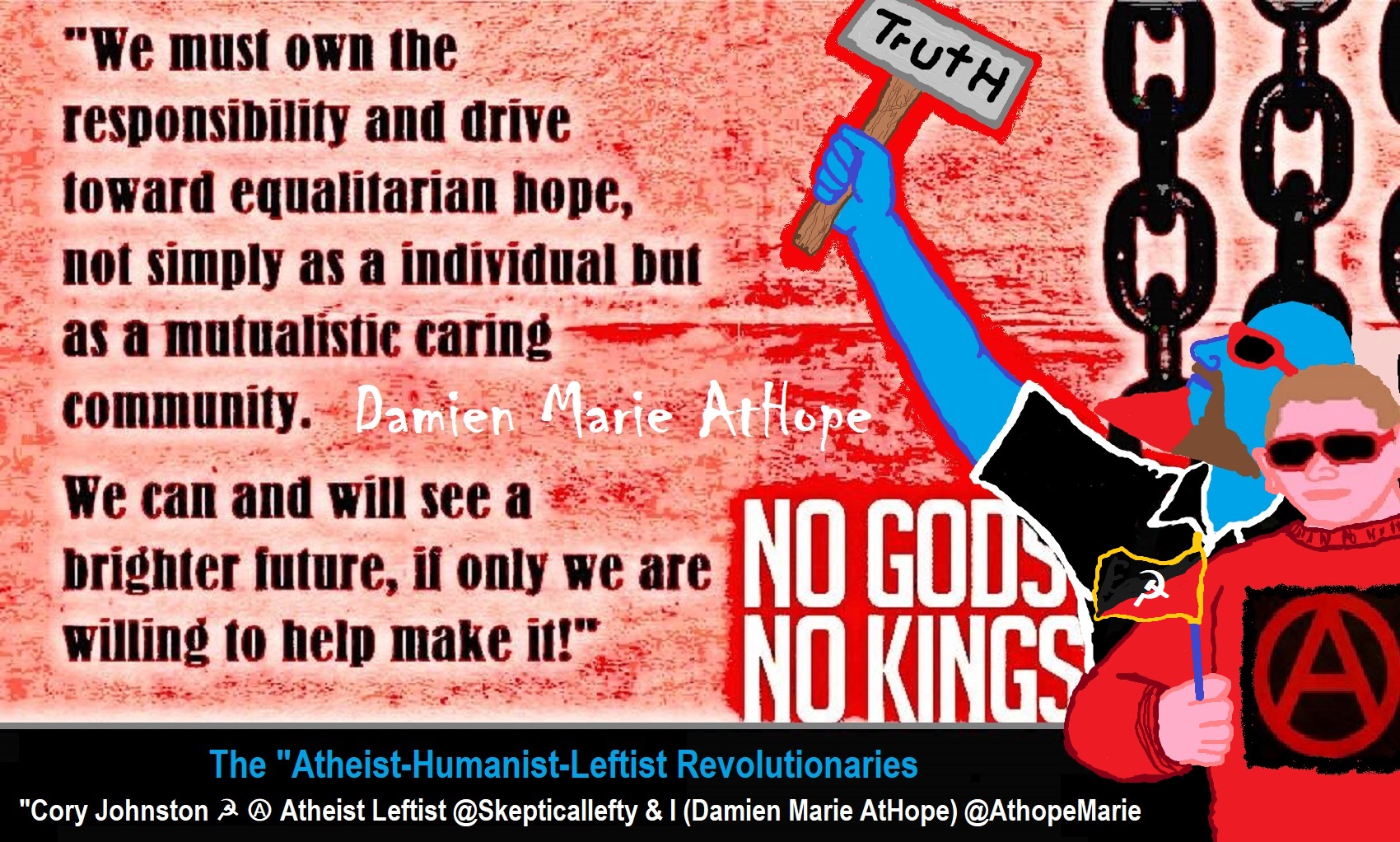
While hallucinogens are associated with shamanism, it is alcohol that is associated with paganism.
The Atheist-Humanist-Leftist Revolutionaries Shows in the prehistory series:
Show two: Pre-animism 300,000 years old and animism 100,000 years old: related to “Anarchism and Socialism”
Show tree: Totemism 50,000 years old: related to “Anarchism and Socialism”
Show four: Shamanism 30,000 years old: related to “Anarchism and Socialism”
Show five: Paganism 12,000 years old: related to “Anarchism and Socialism”
Show six: Emergence of hierarchy, sexism, slavery, and the new male god dominance: Paganism 7,000-5,000 years old: related to “Anarchism and Socialism” (Capitalism) (World War 0) Elite and their slaves!
Prehistory: related to “Anarchism and Socialism” the division of labor, power, rights, and recourses: VIDEO
Pre-animism 300,000 years old and animism 100,000 years old: related to “Anarchism and Socialism”: VIDEO
Totemism 50,000 years old: related to “Anarchism and Socialism”: VIDEO
Shamanism 30,000 years old: related to “Anarchism and Socialism”: VIDEO
Paganism 12,000 years old: related to “Anarchism and Socialism” (Pre-Capitalism): VIDEO
Paganism 7,000-5,000 years old: related to “Anarchism and Socialism” (Capitalism) (World War 0) Elite and their slaves: VIEDO
Paganism 5,000 years old: progressed organized religion and the state: related to “Anarchism and Socialism” (Kings and the Rise of the State): VIEDO
Paganism 4,000 years old: related to “Anarchism and Socialism” (First Moralistic gods, then the Origin time of Monotheism): VIEDO
I do not hate simply because I challenge and expose myths or lies any more than others being thought of as loving simply because of the protection and hiding from challenge their favored myths or lies.
The truth is best championed in the sunlight of challenge.
An archaeologist once said to me “Damien religion and culture are very different”
My response, So are you saying that was always that way, such as would you say Native Americans’ cultures are separate from their religions? And do you think it always was the way you believe?
I had said that religion was a cultural product. That is still how I see it and there are other archaeologists that think close to me as well. Gods too are the myths of cultures that did not understand science or the world around them, seeing magic/supernatural everywhere.
I personally think there is a goddess and not enough evidence to support a male god at Çatalhöyük but if there was both a male and female god and goddess then I know the kind of gods they were like Proto-Indo-European mythology.
This series idea was addressed in, Anarchist Teaching as Free Public Education or Free Education in the Public: VIDEO
Our 12 video series: Organized Oppression: Mesopotamian State Force and the Politics of power (9,000-4,000 years ago), is adapted from: The Complete and Concise History of the Sumerians and Early Bronze Age Mesopotamia (7000-2000 BC): https://www.youtube.com/watch?v=szFjxmY7jQA by “History with Cy“
Show #1: Mesopotamian State Force and the Politics of Power (Samarra, Halaf, Ubaid)
Show #2: Mesopotamian State Force and the Politics of Power
Show #3: Mesopotamian State Force and the Politics of Power (Uruk and the First Cities)
Show #4: Mesopotamian State Force and the Politics of Power (First Kings)
Show #5: Mesopotamian State Force and the Politics of Power (Early Dynastic Period)
Show #6: Mesopotamian State Force and the Politics of Power
Show #7: Mesopotamian State Force and the Politics of Power (Sargon and Akkadian Rule)
Show #9: Mesopotamian State Force and the Politics of Power (Gudea of Lagash and Utu-hegal)
Show #12: Mesopotamian State Force and the Politics of Power (Aftermath and Legacy of Sumer)
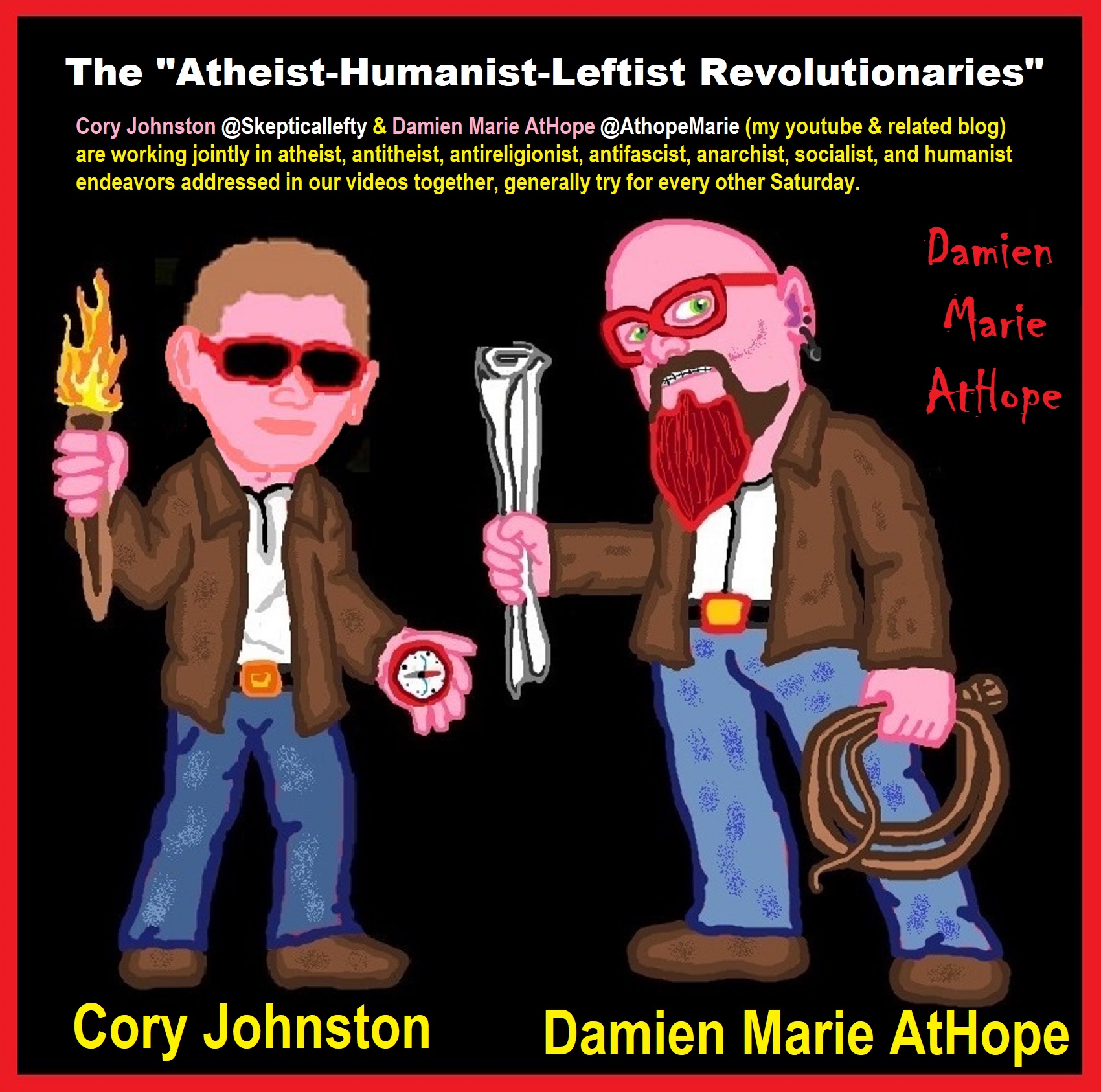
The “Atheist-Humanist-Leftist Revolutionaries”
Cory Johnston ☭ Ⓐ Atheist Leftist @Skepticallefty & I (Damien Marie AtHope) @AthopeMarie (my YouTube & related blog) are working jointly in atheist, antitheist, antireligionist, antifascist, anarchist, socialist, and humanist endeavors in our videos together, generally, every other Saturday.
Why Does Power Bring Responsibility?
Think, how often is it the powerless that start wars, oppress others, or commit genocide? So, I guess the question is to us all, to ask, how can power not carry responsibility in a humanity concept? I know I see the deep ethical responsibility that if there is power their must be a humanistic responsibility of ethical and empathic stewardship of that power. Will I be brave enough to be kind? Will I possess enough courage to be compassionate? Will my valor reach its height of empathy? I as everyone, earns our justified respect by our actions, that are good, ethical, just, protecting, and kind. Do I have enough self-respect to put my love for humanity’s flushing, over being brought down by some of its bad actors? May we all be the ones doing good actions in the world, to help human flourishing.
I create the world I want to live in, striving for flourishing. Which is not a place but a positive potential involvement and promotion; a life of humanist goal precision. To master oneself, also means mastering positive prosocial behaviors needed for human flourishing. I may have lost a god myth as an atheist, but I am happy to tell you, my friend, it is exactly because of that, leaving the mental terrorizer, god belief, that I truly regained my connected ethical as well as kind humanity.
Cory and I will talk about prehistory and theism, addressing the relevance to atheism, anarchism, and socialism.
At the same time as the rise of the male god, 7,000 years ago, there was also the very time there was the rise of violence, war, and clans to kingdoms, then empires, then states. It is all connected back to 7,000 years ago, and it moved across the world.
Cory Johnston: https://damienmarieathope.com/2021/04/cory-johnston-mind-of-a-skeptical-leftist/?v=32aec8db952d
The Mind of a Skeptical Leftist (YouTube)
Cory Johnston: Mind of a Skeptical Leftist @Skepticallefty
The Mind of a Skeptical Leftist By Cory Johnston: “Promoting critical thinking, social justice, and left-wing politics by covering current events and talking to a variety of people. Cory Johnston has been thoughtfully talking to people and attempting to promote critical thinking, social justice, and left-wing politics.” http://anchor.fm/skepticalleft
Cory needs our support. We rise by helping each other.
Cory Johnston ☭ Ⓐ @Skepticallefty Evidence-based atheist leftist (he/him) Producer, host, and co-host of 4 podcasts @skeptarchy @skpoliticspod and @AthopeMarie
Damien Marie AtHope (“At Hope”) Axiological Atheist, Anti-theist, Anti-religionist, Secular Humanist. Rationalist, Writer, Artist, Poet, Philosopher, Advocate, Activist, Psychology, and Armchair Archaeology/Anthropology/Historian.
Damien is interested in: Freedom, Liberty, Justice, Equality, Ethics, Humanism, Science, Atheism, Antiteism, Antireligionism, Ignosticism, Left-Libertarianism, Anarchism, Socialism, Mutualism, Axiology, Metaphysics, LGBTQI, Philosophy, Advocacy, Activism, Mental Health, Psychology, Archaeology, Social Work, Sexual Rights, Marriage Rights, Woman’s Rights, Gender Rights, Child Rights, Secular Rights, Race Equality, Ageism/Disability Equality, Etc. And a far-leftist, “Anarcho-Humanist.”
I am not a good fit in the atheist movement that is mostly pro-capitalist, I am anti-capitalist. Mostly pro-skeptic, I am a rationalist not valuing skepticism. Mostly pro-agnostic, I am anti-agnostic. Mostly limited to anti-Abrahamic religions, I am an anti-religionist.
To me, the “male god” seems to have either emerged or become prominent around 7,000 years ago, whereas the now favored monotheism “male god” is more like 4,000 years ago or so. To me, the “female goddess” seems to have either emerged or become prominent around 11,000-10,000 years ago or so, losing the majority of its once prominence around 2,000 years ago due largely to the now favored monotheism “male god” that grow in prominence after 4,000 years ago or so.
My Thought on the Evolution of Gods?
Animal protector deities from old totems/spirit animal beliefs come first to me, 13,000/12,000 years ago, then women as deities 11,000/10,000 years ago, then male gods around 7,000/8,000 years ago. Moralistic gods around 5,000/4,000 years ago, and monotheistic gods around 4,000/3,000 years ago.

Damien Marie AtHope (Said as “At” “Hope”)/(Autodidact Polymath but not good at math):
Axiological Atheist, Anti-theist, Anti-religionist, Secular Humanist, Rationalist, Writer, Artist, Jeweler, Poet, “autodidact” Philosopher, schooled in Psychology, and “autodidact” Armchair Archaeology/Anthropology/Pre-Historian (Knowledgeable in the range of: 1 million to 5,000/4,000 years ago). I am an anarchist socialist politically. Reasons for or Types of Atheism
My Website, My Blog, & Short-writing or Quotes, My YouTube, Twitter: @AthopeMarie, and My Email: damien.marie.athope@gmail.com

